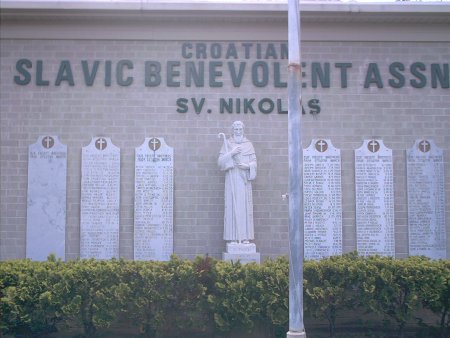
BILOXI CROATIAN FAMILY TIMELINE
1909
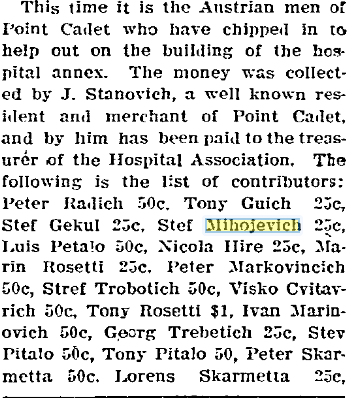

[The Daily Herald, March 27, 1909, p. 1]
1913
The Daily Herald, "Set for trial in Circuit Court", January 8, 1913, p. 3. Local Croatians on trial in early 1913 in the Harrison County Circuit Court were: Tony Martinolich-gambling; Nick Skermetta (sic), assult with intent; Nick, john, Maro, and John Skermetta Jr., assaut and battery; Mike Skermetta and Nick Skermetta, fighting and disorderly conduct; Tony Stanovich and Jake Stanovich Jr., selling liquor; and Jake Stanovich Sr., allowing liquor to be sold on his premises.
The Daily Herald, "Austrians form Benevolent Association", December 18, 1913, p. 7. Charter members: Ivan Budinich; Ivan Gabrich; Ivan Letich; Ivan Lovetich; Blas Miljan; Marko Mulat; Tony Rosetti; Nikola Skrmetti; Victor Simonich; Jacob Stanovich (1860-1926); and Philip Williams.
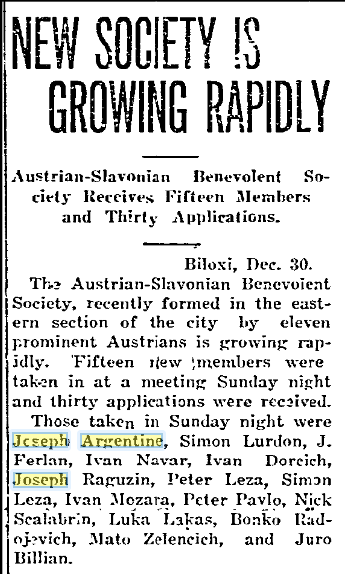
The Daily Herald, "New Society is growing rapidly", December 30, 1913, p. 2.
1918
The Daily Herald, "Servian [sic] wants to be an American", March 20, 1918, p. 3. Tony Conovich came to America in 1904 and lives in Handsboro.
1920
The Daily Herald, "Americans from troubled Dalmatia", March 4, 1920, p. 4.
The Daily Herald, "Files petition", June 3, 1920, p. 3. Dominick Cvitanovich had made application to file his naturalization papers in Federal Court here. Tony Cvitanovich has filed his declaration of intention to become an American citizen with US Commissioner George Money at Gulfport.
1921
Letter from Brac-1921
Nikola Skermeta (sic), 413 Copp Street in Biloxi, received a woeful letter from his parents at Bobovisci, in the island of Brach (sic), off the Dalmatian coast in the far-away Adriatic Sea. It recited the privation and suffering common in that country, where the native grape vines have succumbed to a disease which the people have been unable to cure, andin consequence of which many American grape vines have been imported. The soil there is rocky, quite unlike the rich American soil, and the vines require time become acclimated and learn to struggle against the poor soil condition, said Mr. Skermeta (sic) His people write that it will take about six years before they will be able to harvest these grapes. In the meantime, the people of Brach (sic) are enduring great hardships. Mr. Skermeta (sic) was at the Federal clerk's office inquiring into some safe method to send his parents money, a previous remittance never reached them. Reports by Biloxians of losses of money sent to relatives have been frequent, are unable to understand it being accustomed to Uncle Sam's generally prompt and safe deliveries. Mr. Skermeta's (sic) parents wrote that many people were eating grass to save themselves from starving. (The Daily Herald, January 19, 1921, p. 4)
Mateo Pitalo, Tony Pitalo, Peter Pavlov, Vincenzo Citanovich, Joseph Argentin, John Kersance; Steve Sekul, and Sam Sekul took an oath of allegiance to the Unied States.[The Daily Herald, February 22,1921, p. 1]
The Daily Herald, "These men may don US suits June 20", May 23, 1921, p. 6. Gregorio Anticich came from Ygrane and was naturalied at NOLA in 1914. Peter Lessa [Lesso], Biloxi fisherman, came to NOLA as a boy on the Eugenia, a liner, as part of the crew and jumped ship.
The Daily Herald, “The Charter of Incorporation of the Slavonian Benevolent Association 'St. Nicola'", August 19, 1921, p. 2.
1927
Captains Jake Rosetti, Tony Cvitanovich, and Frank J. Barhonovich formed a committee to collect money for the relief of flood victims in southeast Louisiana after the Mississippi River was breached in an action called the Poydras Crevasse. Croatian families donated $176.50 which was given to The Daily Herald for distribution.[The Daily Herald, May 6, 1927, p. 1]
1929
The Daily Herald, "28 seek citizenship at next court term", May 24, 1929. Biloxi-Jugoslavia: Rocco Beverin; Martin Baranich (sic); Jerko Covich; A. Dujmov; G. Garbin; Stefano Gego; Parvel Starmeta [Paul M. Skrmetta]; Mato Soljan; and Giovanni Zorkovic.
Captain Anthony J. Stanovich (18-1929), aboard Lone Star and ferrying workers from the Louisiana seafood factories of the C.B. Foster Packing Company, was killed while workng on the vessel's engine off the coast of Waveland, Hancock County, Mississippi.(The Daily Herald, November 5, 1919, p. 1)
The Benevolent Association of St. Nicolai dedicated their new home on East Howard Avenue on December 26th. The organization was lead by B. Dujmov, pres.; Tony Cvitanovich (1888-1964), v. pres.; Peter Pavlov, sec.-treas.; Steve Filipich, marshal;with Alexc Pitalo, chair of the arrangement committee. The society commenced circa 1914 with Jake Stanovich (1891-1927), as president, and Phillip Williams, sec.-treasurer.(The Daily Herald, December 27, 1929, p. 1 and The Times-Picayune, December 28, 1929, p. 2 [photo])
1932
The Sea Coast Packing Company was founded by hard working, Croatian fishermen in July when they acquired the Martin Fountain Packing Company from the 1st National Bank of Biloxi. Peter Pavlov (1882-1951) was president and treasurer; Alexander Pitalo, vice pres. and Steve M. Sekul (1881-1970), operations manager. The plant had been idle for a year and expected to employ 200 people when it was fully operating.(The Daily Herald, July 30, 1932, p. 1)
1934
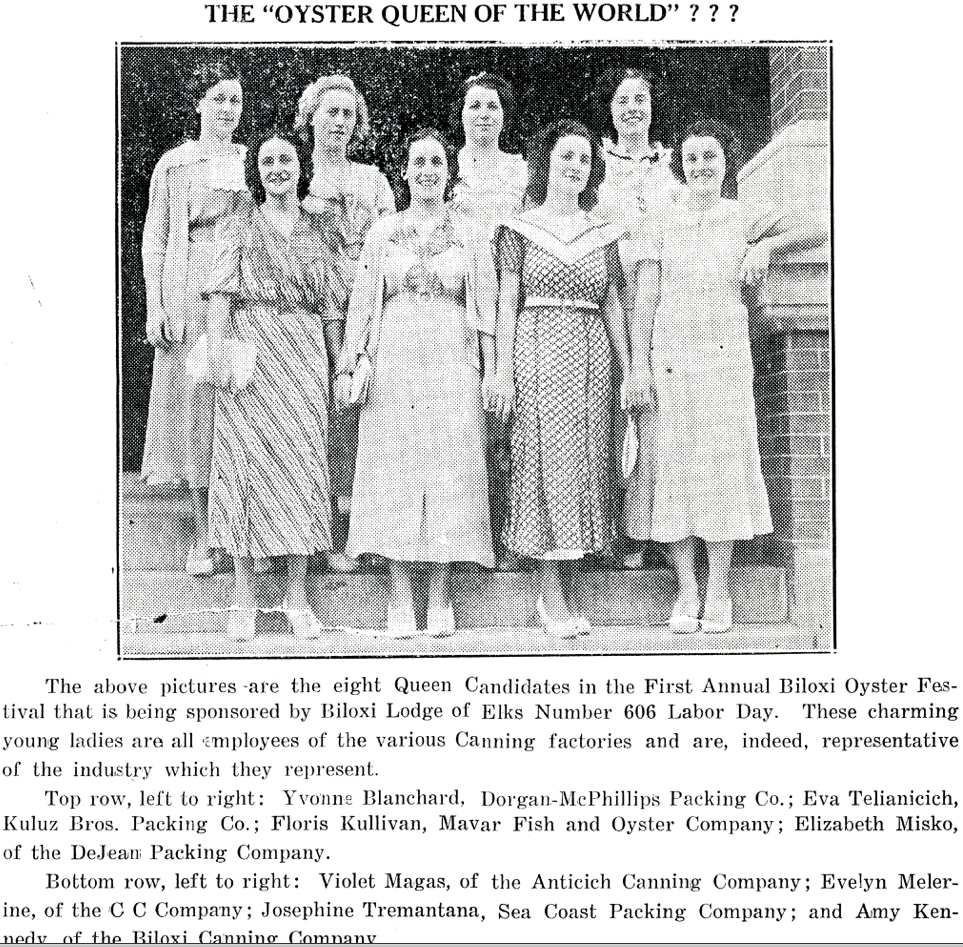

Contestants in front of Riviera Hotel [Lameuse Street and Beach Boulevard]
[L-R: Violet Magas; Amy Kennedy; Elizabeth Misko; Yvonne Blanchard; Evelyn Mellerine; Josephine Tremontana; Eva Talijanicich; and Floris Kullivan.
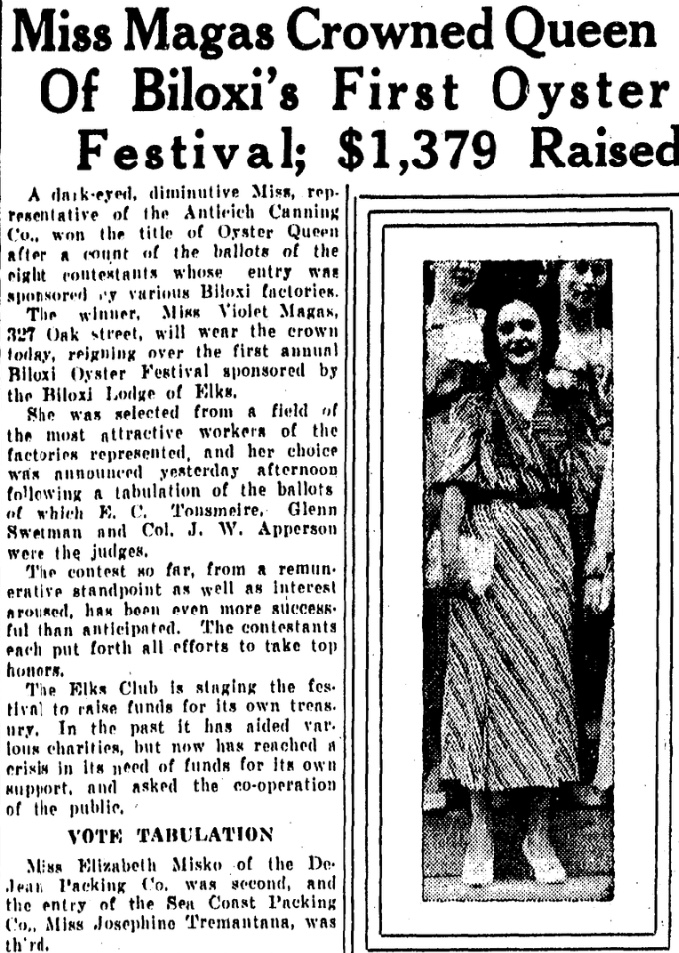
[
1935
The Daily Herald, "Matre Pitalo heads new voting club", July 1, 1935, p. 2. The Slavonian Voting Club was organized on August 31, 1935 at the Slavonian Hall by Austrian residents in the eastern section of Biloxi. Matre Pitalo (1898-1981), seafood dealer and grocer, was elected president. Mico Fillipich was elected vice-president. He is president of the Slavonian Benevolent Association. Pete Pavlov of the Seacoast Packing Company was eelcted secretary and treasurer. The organization is planning a picnic and political rally at the Slavonian Hall on East Howard Avenue.
1937
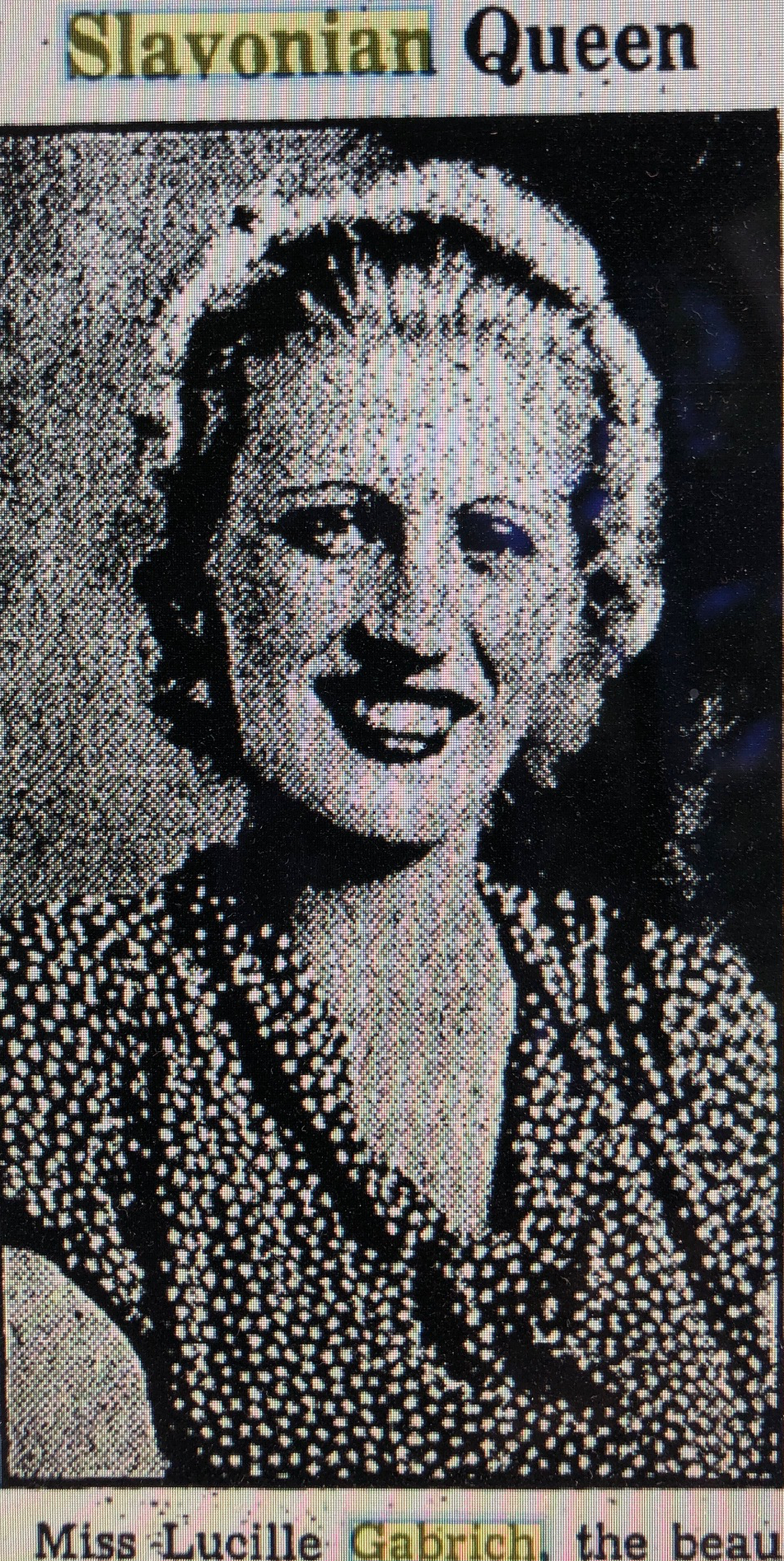
1938
Madeline Kuljis (b. 1912), daughter of Mr. and Mrs. Luka Kuljis, 1002 East Beach, was named Miss Biloxi on February 4th. She was sponsored by Elliott's Jewelery.(The Daily Herald, February 5, 1938, p. 1)
The Slavonian Society began planning for the erection of their new home.(The Daily Herald, February 24, 1938, p. 12)
Dr. Konstantin Fotich, Yugoslavian Ambassador to America, visited Biloxi and the Croatian community in late February.(The Daily Herald, February 24, 1938, p. 1)

[from The Daily Herald, February 11, 1938, p. 8]
Madeline Kuljis was named Miss Biloxi at the Buena Vista Hotel in early February.[The Daily Herald, February 5, 1938, p. 1]

Miss Claire Sekul [Hornsby] (1921-2017) was named Miss Yugoslavia.(The Daily Herald, August 8, 1938, p. 5)
The new St. Nicholas Slavic Benevolent Society Lodge [Slavonian Lodge] on First Street and Myrtle at Point Cadet was dedicated on November 20th. The $20,000, two-story, structure was erected by the Collins Brothers, general contractors, from a design by Jack Fayard, the architect. Steve Kuljis was president of the organization at this time and building sponsors were Mary Anticich and Alonzo Gabrich.(The Daily Herald, November 19, 1938, p. 3)
1939
Irma Summerlin, Queen Victoria, and Peter Cerenich, King Peter, ruled the annual carnival ball of the Slavonian Girls’ Association. The event was the first in the new Slavonian Lodge.(The Daily Herald, January 20, 1939, p. 2)

Veronica Anticich Cangemi (1919-1998) was named Miss Yugoslavia garnering 12,450 votes to beat Frances Pavlov (1915-2004) Touchet who had 2880 votes.(The Daily Herald, August 2, 1939, p. 5)
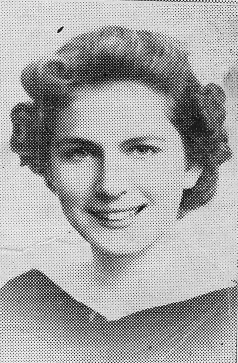


(The Daily Herald, May 28, 1940, p. 2)
Captain Steve Rodolfich (1883-1960) of 116 Maple Street was honored with a silver loving cup for his contributions to the oyster industry by Dunbar-Dukate and the Louisiana Conservation Department for delivering the best oysters to Violet, Louisiana for the 1940 oyster season and for the discovery of oyster reefs in Lake Borgne.(The Daily Herald, June 28, 1940, p. 8)
Lewis W. Hines (1874-1940), sociologist and photographer, expired at Dobbs Ferry, New York on 3 November. He was a crusader against child labor and made dramatic images of children working in the seafood industry in Mississippi and Louisiana circa 1910.
1941
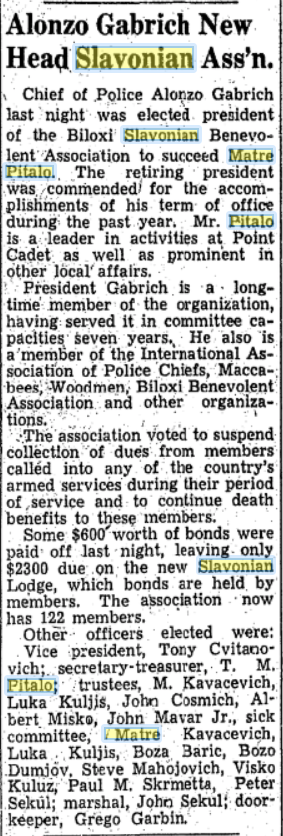
(The Daily Herald, May 20, 1941, p. 3)
In mid-August, Dan Markotich (1892-1964) sold the French Restaurant to Joseph Baricev (1904-1999). Markotich had operated the restaurant for six years.(The Daily Herald, August 13, 1941, p. 6)
1942
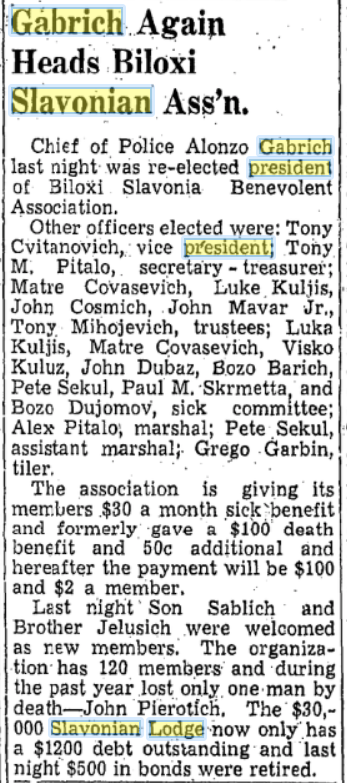
(The Daily Herald, My 19, 1942, p. 6)
1943
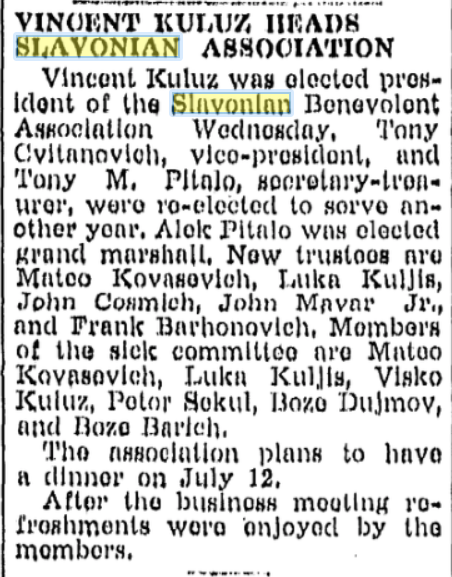
[The Daily Herald, May 22, 1943, p. 7]

[The Daily Herald, June 23, 1944, p. 5]
1944
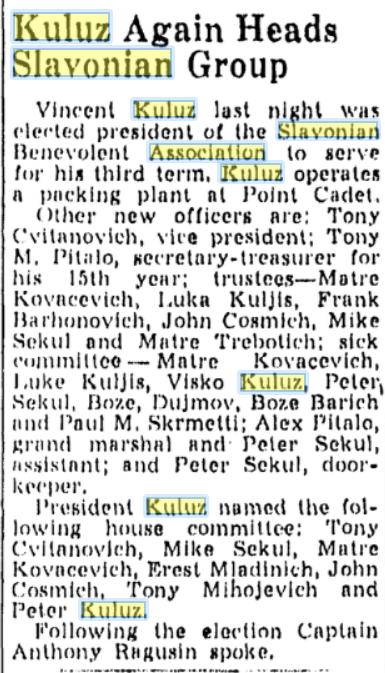
[The Daily Herald, May 19, 1944, p. 5]
1945
The Daily Herald, "Vincent Kuluz Slavonian head", May 26, 1945, p. 5.
1946
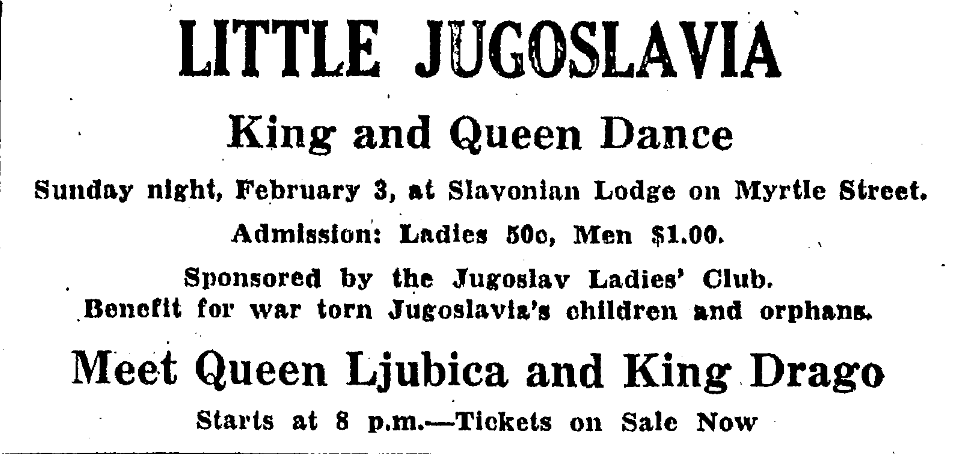
[The Daily Herald, February 2, 1946, p. 5]
1947
Tony J. Rosetti was elected president of the Slavonian Benevolent Association in May. Other officers elected were: Dr. steve Pitalo, v. pres.; Tony M. Pitalo, sec.-treas.; Alex Pitalo, marshal; Peter Sekul, asst. marshal; Jake Mladinich, sgt.-at-arms; and Mateo Kovacevich, Luka Kuljis, and Visko Kuluz, trustees.(The Daily Herald, may 24, 1947, p. 6)
1948
The Times -Picayune, "Yugoslavia, Miss.", May 2, 1948, p. 130.
1949
On March 3rd, Jacobena ‘Jackie’ Sekul Gillich (1913-2003) and Andrew Gillich (1923-2014), her spouse, who had formerly operated the City Hall Cash Grocery at 129 East Howard Avenue, opened Foodland at 1400 West Howard, now Judge Sekul, in early March 1949. Andrew Puzz (1895-1971) of Quality Bakery baked a 4-foot tall, 7 layer cake weighting 185 pounds for the first anniverary in March 1950.(The Daily Herald, March 2, 1949, p. 6 and March 3, 1950, p. 15)
1951
In late May, the Slavonian Benevolent Association elected Visko Kuluz as their new president who replace Paul Skrmetti. Other association officers elected were: Tony Mihojevich, vice-pres.; and John Kersanac, sec.-treasurer.(The Daily Herald, June 1, 1951, p. 8)
1953
At the 1953 Slavonian Benevolent Bazaar, Miss Elmerita Mihojevich was crowned Miss Jugoslavia by Clare Sekul Hornsby. Miss Hillbilly of Mississippi was Barbara Mae Knebel and her tiara was placed by Mrs. Hank Williams[Billie Jean Jones (b. 1933)].(The Daily Herald, August 3, 1953, p. 6)
1955
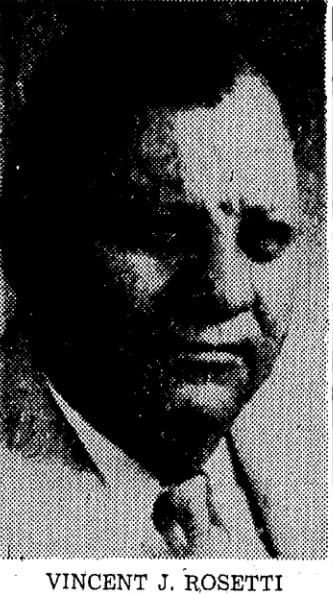
In May, Vincent J. Rosetti was elected pesident of the the Slavonian Benevolent Association.[The Daily Herald, May 21, 1955, p. 9]
The Times-Picayune, "The Day After-Festivities continue on as Yugoslavs at Biloxi honor their patron [St Stephen]", December 25, 1955, p. 5.
1960

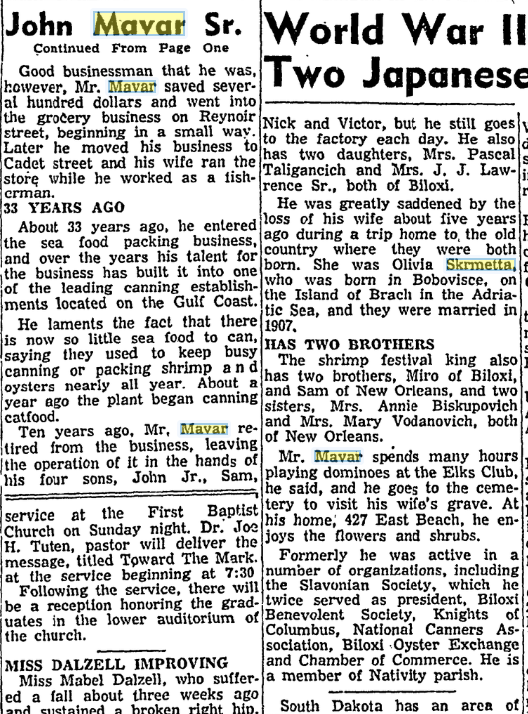
[The Daily Herald, May 28, 1962, p. 1 and p. 12]
1962

Steve C. Sekul


[The Daily Herald, May 30, 1962, p. 1]
1966

Long time Croatian leader at Biloxi, Steve M. Sekul [1880-1966] expired on July 16, 1966.[The Daily Herald, July 18, 1966, p. 2]
1968
Francis "Butch" J. Nadalich (1937-2002) was elected president of the .[Thje Daily Herald, May 21, 1968, p. 14]
1969
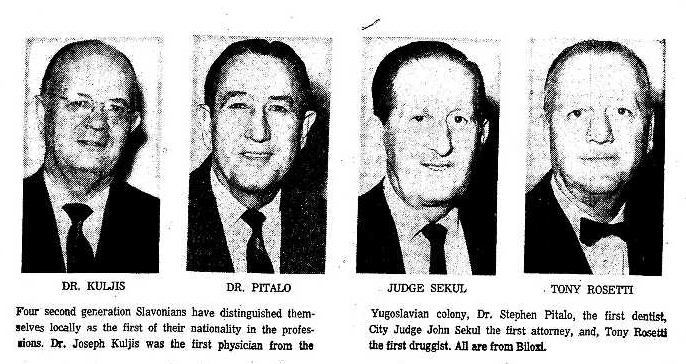
[The Daily Herald, February 22, 1969, Section II, p. 15]

Dr. Matthew Kuluz was selected as Outstanding Citizen of Jackson County, Mississippi.[The Daily Herald, March 21, 1969, pp. 1-7]


1989

Peter Halat
Peter Halat [b. 1942] was the first Coatian descedent to be elected Biloxi's Mayor.
1993

Martin Skrmetta, son of Noel J. 'Jimmy' Skrmetta (1936-2004) and Bobbie Jean Maumus (b. 1935), was Biloxi's 1993 Shrimp King.
1999
The Sun Herald, "Slavonian men pose for posterity", December 18, 1999, p. A1.
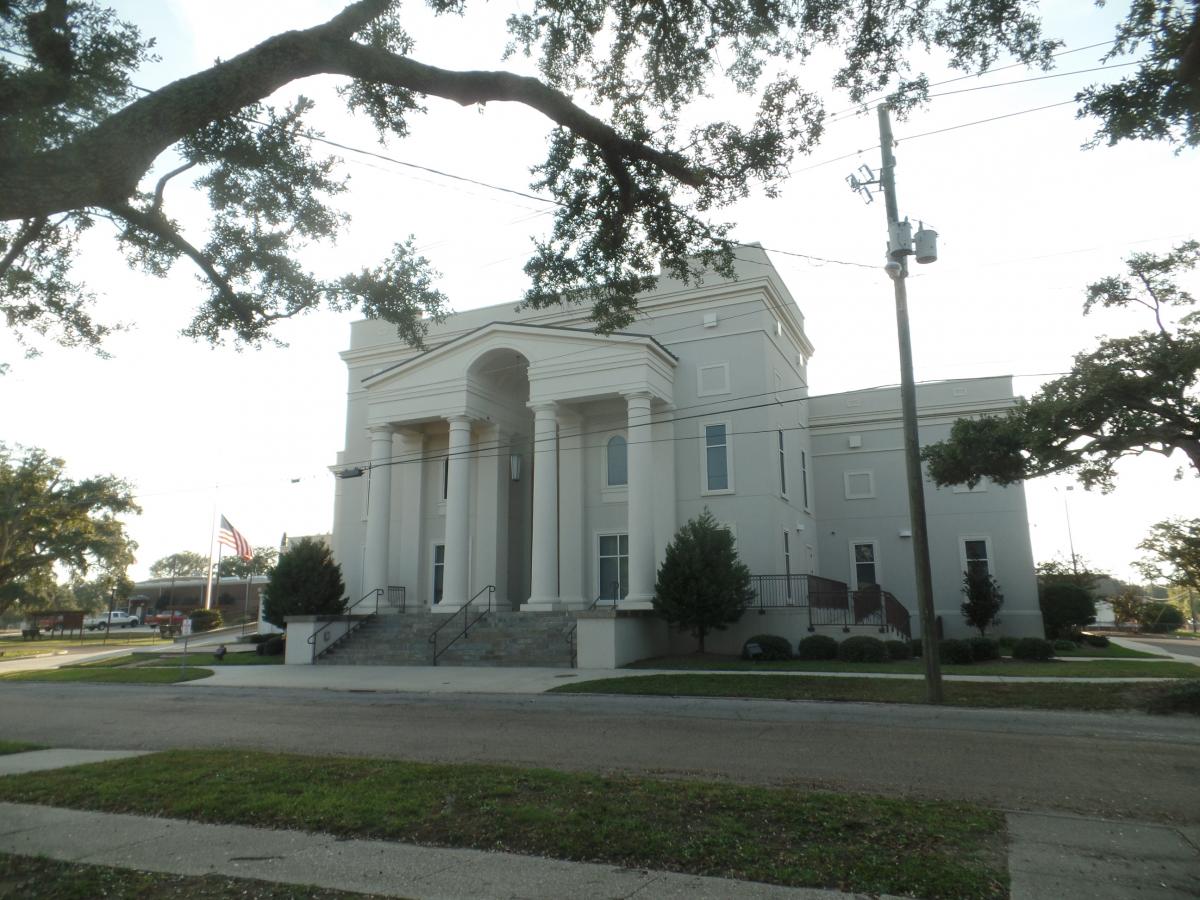
2010
The new $3 million Lodge of the Slavonian Benevolent Association of St. Nikolai, located near Howard Avenue and Oak Street,was dedicated on November 27th.(The Sun Herald, November 26, C, p. A2)
2011
Pusharatas are a sweet tradition.(The Sun Herald, December 24, 2011, p. A2)
2015
_________________________________________________________
BILOXI CROATIAN FAMILIES
FAMILY ARRIVALS FROM ARBANASI, ZADAR

JOSEPH SMOLCICH
Joseph Smolcich [Josip Smolcic] (1893-1967) was born August 6, 1893 in Anbanasi, a village on the on the Zadar Peninsula, Croatia. He left Trieste, Italy on the Franz Joseph I and arrived at New York City on August 31, 1912. Joseph settled at 402 Oak Street in Biloxi, Mississippi with his spouse, Frances Cvitanovich (1901-1979), a native of Milna, Brac, Croatia.(Southern District, Mississippi-Declaration of Intention No. 840, March 12, 1927)
Joseph August Smolcich (1893-1967) and Frances Cvitanovich (1901-1979), a native of Milna, Brac and the daughter of Vincent Cvitanich (1873-1947) and Mary U. (1880-1946), were the progenitors of the Smolcich family of Biloxi, Mississippi. They married on May 22, 1916 at Biloxi, Mississippi. Children: Matilda Smolcich (b. 1920) m. Raymond C. Barry (1905-1988); Joseph 'Smoky Joe' A. Smolcich II (1922-2010) m. Anna Kopszywa (1927-2010); Vincent L. Smolcich (1925-1981) m. Aurora Marie Saujon (1923-2007); Steve Anthony Smolcich (1927-2013) m. Patricia Lee Wilson (1929-2017); ; Mary Rita 'Melrita' Smolcich m. Marvin Lee Raesner; Samuel D. Smolcich (1934-2006) m. Vinnie Elba Seymour; and John A. Smolcich (1937-2001) m. Jeanet Marie Callis. The Smolcich family started the Biloxi Seafood Company, the Roxy Theatre at 1430 East Howard Avenue, the Roxy Restaurant and owned much rental property on Point Cadet in East Biloxi.(The Sun Herald, October 12, 2010, p. and Harrison County, Mississippi Circuit Court MRB 29, p. 38)
CHILDREN
MATILDA SMOLCICH
Matilda Smolcich (1920) married Raymond C. Barry (1905-1988) on March 3, 1946.(Harrison Co., Mississippi Circuit Court MRB 71, p. 39)
Raymond C. Barry died at Biloxi, Mississippi on October 6, 1988.
JOSEPH A. SMOLCICH
Joseph A. ‘Smokey Joe’ Smolcich (19-2010) was born 19. In Harrison County, Mississippi, he married Anna Kopszywa (1926-2010), a native of Cleveland, Ohio and the daughter of Edward Kopszywa (1887-1962) and Mary Agnes Misiora (1888-1939). They had a son, Gregory Jude Smolcich, who married Deborah ?.
VINCENT L. SMOLCICH
Vincent L. Smolcich (1925-1981) was born October 18, 1925. He married Aurora Marie Saujon (1923-2007), the daughter of Robert Saujon (1865-1944) and Mary McCaleb (1897-1937) in Harrison County, Mississippi on April 4, 1948. Their children were: Vincent L. Smolcich II m. Myrna and Sharon Frances Smolcich m. Richard Wayne Gontz and John McDonnell.(Harrison Co., Mississippi Circuit Court MRB 76, p. 455; MRB 135, p. 370;
Vincent L. Smolcich expired on July 26, 1981. Aurora Marie Smolich died on April 4, 2007. Their corporal remains were interred in the Biloxi Cemetery.(The Sun Herald,

STEVE A. SMOLCICH
Steve Anthony Smolcich (1927-2013) married Patricia Lee Wilson (1929-2017) in Harrison County, Mississippi on January 1, 1950. They were the parents of Steve Anthony Smolich Jr. who married Bridget Orrell.(Harrison Co., Mississippi Circuit Court MRB 81, p. 48)
Steve Anthony Smolcich Sr., 85, of Biloxi, died at home on Friday. He was born to the late Joseph and Frances Smolcich, on October 1, 1927. He married Patricia "Pat" Wilson, also of Biloxi. They were married for 63 years.
Mr. Smolcich served in the Merchant Marines, in the Atlantic, during World War II and was honorably discharged from the Navy after serving in the Pacific. During his time in the Pacific he witnessed the nuclear bomb tests in the Bikini Atolls aboard the USS Fieberling DE-640. After returning from the war he worked in the family business at the Roxy Theater and later at Ingalls Shipbuilding. He worked at the U.S. Post Office for 32 years and retired in 1991.
This past October Mr. Smolcich enjoyed a trip to Washington, D.C. with other World War II veterans, which was provided by the Mississippi Gulf Coast Honor Flight. He was an avid boater, fisherman, and longtime member of the Slavonian Benevolent Association and the Elks B.P.O.E..
Mr. Smolcich was preceded in death by his parents and his brothers Joseph Smolcich, Vincent Smolcich, Sam Smolcich, and Anthony Smolcich. He is survived by two sisters, Matilda Barry and Melrita Raesner and numerous nieces and nephews. In addition to his wife, Pat, Mr. Smolcich is survived by his son, Steve Smolcich, Jr. and wife Bridget Orrell Smolcich; granddaughter, Shelley Smolcich McManaman and husband Leonard McManaman; grandson Scott Steven Smolcich and wife Jennifer Harper Smolcich; and three great grandchildren, Chase McManaman, Paige McManaman, and Madison Smolcich.
The family would like to thank Home Instead and Singing River Hospice for their respectful, loving care. In lieu of flowers donations may be sent to Singing River Health System, Hospice of Light.
Visitation will be at the Howard Avenue Chapel of Bradford-O'Keefe Funeral Home, on Monday, July 15, 2013 from 6:00 pm to 8:00 pm. A Rosary will be recited at 7:00. There will also be a visitation at Nativity of the Blessed Virgin Mary Catholic Church, on Tuesday, July 16, 2013 from 10:00 am to 11:00 am followed by a Funeral Mass at 11:00. Interment will be at Southern Memorial Park.[The Sun Herald, July 14, 2013]

Patricia W. Smolcich
Patricia "Pat" Lee Wilson Smolcich (1929-2017), age 87 years, a native and life long resident of Biloxi, died on Friday, June 2, 2017 at St. Joseph Hospice. She was preceded in death by her parents, George and Orpha Mae Wilson; and her husband of 62 years, Steve Smolcich.
Pat is survived by her son, Steve (Bridget) Smolcich, Jr., of Mandeville, Louisiana; two grandchildren, Shelley Smolcich (Leonard) McManaman of Frisco, TX, and Scott (Jennifer) Smolcich of League City, Texas; and three great-grandchildren, Chase McManaman, Paige McManaman, and Madison Smolcich.
Mrs. Smolcich graduated from Biloxi High School and retired from South Central Bell as a switchboard operator. Throughout her life, Pat devoted her time, talent, and treasures to numerous religious, social, and civic activities, including mission trips to Saltillo, Mexico and volunteering for Meals on Wheels.
Mrs. Smolcich was a member of Nativity of the Blessed Virgin Mary Parish. She served as a Eucharistic minister, greeter, and a member of the Parish Life Committee. She also took Communion to homebound, hospitalized, and nursing home patients. When Pat married Steve Smolcich, she became one of the proudest Slavonian Catholics in Biloxi. She joined the Slavonian Ladies Auxillary, and served as president for many years, helping with the Christmas pusharata sales, the annual golf tournament, and organizing the ladies' trips. Pat was Treasurer of the Elks Club for years, organizing the monthly po-boys sales. The Blessing of the Fleet held a special place in Pat's heart. For more than twenty years she enjoyed working with the Shrimp Queen contestants. In 2004, Mrs. Smolcich was named Lions Club Mother of the Year. Pat was a part of several social groups, including Pokeno, high school lunch bunch, and the FLEAS birthday group. The family would like to thank St. Joseph's Hospice for their loving care.
A vigil will be held from 6:00 p.m. until 8:00 p.m. on Monday, June 5, 2017 at the Howard Avenue Chapel of Bradford-O'Keefe Funeral Home. A Mass of Christian Burial will be held at Nativity BVM Cathedral at 10:00 a.m. on Tuesday, June 6, 2017, with a visitation thirty minutes prior. Interment will follow at Southern Memorial Park.[The Sun Herald, June 4, 2017]
SAMUEL D. SMOLCICH
Samuel Dominick ‘Sam’ Smolcich (1934-2006) was born December 16, 1934. He married Vinnie Elba Seymour in Harrison County, Mississippi on February 8, 1955. They were the parents of: Samuel Smolcich m. Cindy Collis and Maria Smolcich m. Jay Hindmarch. Sam Smolcich made his livelihood in the seafood and oil industries. He was the captain of the Nana, one of Biloxi’s first steel-hulled shrimp boats and also worked in the Louisiana offshore oil fields for Amerada Hess Corporation. Sam Smolcich expired on January 29, 2006.( Harrison Co., Mississippi Circuit Court MRB 100, p. 373 and The Sun Herald, January 31, 2006)
JOHN A. SMOLCICH
John Anthony Smolcich (1937-2001) m. Jeanet Marie Callis in Harrison County, Mississippi on August 9, 1986.(Harrison Co., Mississippi 2nd JD Circuit Court MRB 31, p. 475 and The Sun Herald, August 31, 2001, p. A9)
REFERENCES:
The Daily Herald, “Vincent Smolcich”, July 28?, 1981.
The Sun Herald, “Aurora Marie Saujon Smolich”, April 5, 2002.
The Sun Herald, “John Anthony Smolich”, August 31, 2001.
The Sun Herald, “Mr. Sam Smolich”, January 31, 2006.
The Sun Herald, "Anna Kopszywa Smolcich", February 13, 2010, p. A4.
The Sun Herald, "Joseph 'Smokey Joe' Smolcich", October 11, 2010, p. A6.
The Sun Herald, "Smolcich lived as 'Mr. Biloxi'", October 12, 2010, p. A4.
____________________________________________________________________________________________
FAMILY ARRIVALS FROM BRAC
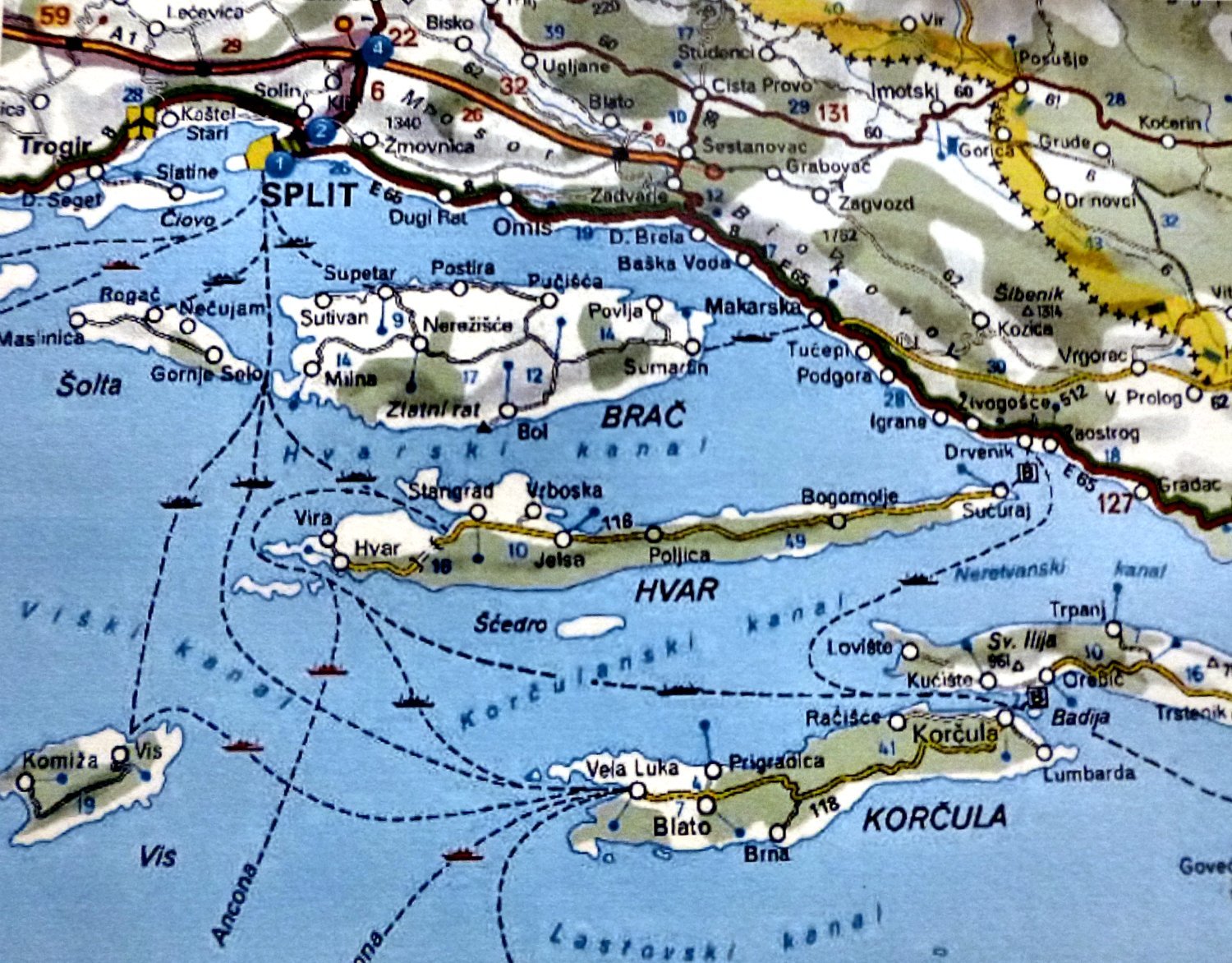
BRAC [Brazza-Italian]
Bobovisca, Brac
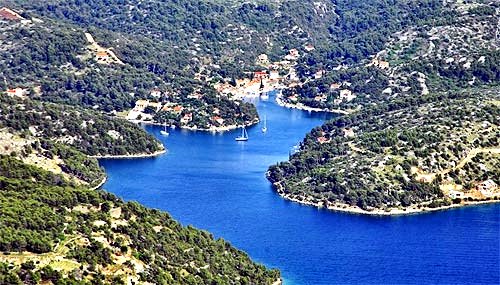
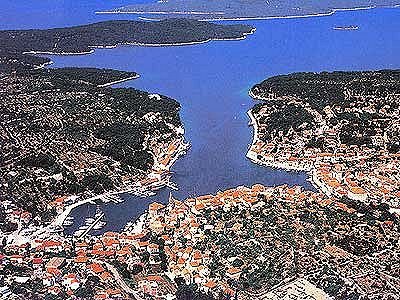

Milna, Brac Supetar [San Pietro della Brazza-Italian], Brac
Brac
Island of Stone Sunshine and Sea
By Peter Simunovic
Brac pronounced Brach.
On this island man and stone have lived and fought each other from time immemorial. This island is my rock. Olives writhe and cypresses slumber in its cracks. Today fewer vineyards burst into leaf on its terraced slopes and, in the spring, fewer lively goats and unruly colts riotously race each other in its grassy vales.
My island is full of heaps of stone piled up through the centuries by hard working hands which picked out the stones from the barren clearings in order to wrest the thin layers of soil from the karst and plant in it the vine to yield dry "plavac” and the sweet "vugava” wines.
At the dawn of history such heaps of stone, hill forts and tumuli were silhouetted, on the ridges of Brac. Watering places were dug and paths cleared everywhere in the bare rock, and later settlements, churches and ports were built. The bowels of the island yielded the marble for the huge Palace of Diocletian and many other magnificent buildings throughout the world. The people of this island have always, struggled for their land, always dependent on the mercy of the skies: would they send rain to the parched terra rossa or fire to burn the fruits of the earth defiantly maturing in the stone?
This island evades, superficial judgment and hasty comparisons. It will conceal its true identity from the observer, and will bestow a smile rather than shed a tear as bitter as wormwood and as clear as grape-brandy.
Brac is at its most hospitable in summer when it opens up its heart and presents: its small towns, and villages and its coves. In summer, the population doubles on its shores, which stretch for more than a hundred miles. Sage, xeranthemum, heather, lavender and rosemary bushes bloom on its slopes and fill one's nostrils with their scents. A multitude of colors meet the gaze: ripe dog berries, bearberries, barberries, mallow, the swollen fruits of blackthorn, blackberry and mahaleb bushes. The deafening song of crickets chirping tirelessly on the knotty jasmines, junipers and spruces, has given the island its name, "island of crickets".
I watch the herds of sheep resting in the deep shade of the tree tops. The heat has stilled the bells around the necks of the bellwethers, and led the shepherds to rest in the shade and carve flutes from service tree bark. I hear the plaintive music echoing along the long valleys, the music of satyrs, from the Arcadia of Brac, like a melancholy Dalmatian song sung in the parks and under girls' windows.
Heat shimmers in the air, warms the stone, lulls the sea to sleep, dries up the wells in the villages and the ponds in the pastures. In his later years Nazor expressed his gratitude to this island, accustomed to thirst: "Thank you, waterless isle for having taught me to thirst and long for something all my life" (Brac, 1940).
This is the island of sweat, which drops and evaporates on the hazy whiteness of the heated stone in the quarries of Brac, in front of the infernal doors of the red-hot lime-kilns, in the fields where only the swing of the hoe enables you to distinguish the tanned backs of the laborers from the cleared patches of terra rossa.
The sounds and fragrances harmonize with the hundreds of bright colors, as in Ignat Job’s paintings of Brac.
Another Brac splashes in the coves. Here it gives itself to the sun, like a naked girl on a rock beneath a myrtle in a hidden cove, in the solitude of noon, listening to the amorous whispering of the pines and the calm sea.
Brac has chosen summer for its festivities. More guests visit it in summer, thus giving it greater opportunities to be hospitable. This is the Brac of feasts, youthful abandon, lavish lunches under the arbours, noisy fairs, cunning horse-traders, and desperate, almost hopeless singing in the churches: "Lord, grant rain to Thy land", rain for the vine and the olive, and the cracked soil, hardened like the palm by the oar, hoe and flail; rain for the fruits shriveled like my mother's cheeks on which toil, worry and sorrow have written everything there is to be written.
Brac is full of wrinkles, on its stone and on its people, like the corroded surfaces of the sculptures of V. Michieli: this is Brac in shriveled bronze.
Brac is at its most somber and saddest in autumn. The vineyards blush with red and the swollen black bunches of grapes await the harvest. At the turn of the century, when the entire island was a huge vineyard, grape-picking was a laborious and festive affair, with pickers, grape-crushers, basket-carriers and mule drivers everywhere. The songs and shouts indicate whether the barrels will be full, the must plentiful and the wine strong enough. Fishermen wait for dark in order to set sail, in their lantern-decked boats, for the fishing grounds allotted to them. The white beaches lie bare, "like a girl's virginity", in the quiet solitude of the deserted coves.
The departure of the swallows is followed by the first rains. The stone slab roofs are coated with lime to disinfect the water which will flow into the cisterns from the gutters under the eaves. The flowers in the windows, and porches come to life again. Red-textured mushrooms shoot up under the tangled mass of fallen pine and spruce needles, and shepherds gather them into umbrellas turned upside down. The thirsty earth drinks its fill. The stone assumes a blue-grey hue, like the tombs, which, with the dead days, await the sad processions of long talks with the deceased. The cypresses give in to the caresses of the sirocco which seems to introduce a strange, plaintive note into people's lives.
This is the autumn described by Tin Ujevic, who chose such days of memento morn to visit his mother's island, to sing of his own sadness: "There, there to travel / there, there to grieve. . ." (from the poem "Departure").
By St. Martin's Day the wine has settled. It has fermented and awaits the buyers. The mark left over in the barrels is put into sacks and taken to the still. Spruce twigs, and handfuls of mint, fennel and sage are added on top. After a while, the boiling still yields the first drops of the invigorating and healthy herb brandy of Brac.
Brac is most beautiful in autumn. At this time of the year it is left to its own resources, abandoned and alone. It listens to the must fermenting in the casks, and watches the ripening of the black berries on the olive trees. Autumn brings its gifts of wine and oil, saturated with the sweetness of the sun and the vigor of the climate. Both mostly leave the island for other people's tables . . .
When Christmas announces winter, and the porkers are hung on double hooks so that the chops may be cut out and the hams nicely rounded, the wailing bura plunges down the slopes of Mosor and whistles across the Canal.
"The coolness sends a shiver through the body, and the wind plays hesitating and wavering melodies ... What is the wind saying? It tells of the crying of imprisoned hearts, the resignation of the will bowing to fate, the lonely solitude of widows, the lily pure smile of infants, the thoughts of a faraway world, the last breath of those who lost their lives on the seas of the world. The wind communicates like a soul, and wails like a cello". (Tin Ujevic', Supetar on Brac, 1929).
On these windy evenings thousands of stars grace the sky above the island, showing shepherds and seamen the time and the way in the nocturnal waylessness of the rocky expanses and the sea.
This is the season of the yule log and New Year's songs, rollicking festivities which have cloaked their pagan Slav origins in Christian apparel. The fire crackles and warms your knees, and the pine torch blazes and lights up the sooty ceilings ... I recall my childhood, full of stories, about demons and vampires climbing the chimneys and up the chain on which the kettle hangs above the fireplace, about witches and evil spirits which haunt men in their beds, unbaptized children's souls, mountain fairies, about the Greek treasures in the tumuli, about evil fairies and witches, galley-slaves, and misers, the Spanish plague, hardships and miseries, about the hard life of the colony of Brac , those exploited on their own island and those who wasted away their strength and health toiling for foreign masters in Australian mines, on South American plantations, on strange seas and under alien captains. By these open winter fireplaces I first learnt about the history of my people from Kacic, and about the hard times of my island from my grandparents.
In the winter months, when the bura chills to the marrow, the people of Brac cut jasmine, hornbeams; and boxwood. In olden times, countless mule loads of best firewood were taken to the towns to heat the homes of the rich, thus, providing a meager wage for the woodcutters. On bright winter mornings the peasants would leave their homes, their woolen stockings tied to the handles of their hoes, for the first banking up of the vineyards, while the "makinari", tired and sleepy after a hard night's work at the oil cake press hurried home to rest after being relieved by the next shift.
Almond trees blossom on the island in winter, like a carpet of snow around the villages by the sea. The first lambs are weaned in winter. I know of no softer fur than that on the neck of a scared, new born lamb, which I would take away from the herd and bring to the village, together with the ewe, to warm it by the fire and then offer it the swollen udder of its mother.
Rains fill the ponds on the highlands, the grazing grounds of droves of semi wild mules and unguarded herds of sheep, which water themselves unheeded at the ancient pools, left over from Roman times. Shepherds check the herd only now and then, and in the meanwhile look to see if the marten's paw has sprung the trap in front of its hiding place among the cracks in the solid rock, and collect up the dormice caught in the springy traps placed on jasmine shrubs and the black birds and thrushes caught under the thin stone slabs near puddles in the rock. This is winter in the wayless expanse of Brac.
"0 island without paths, you taught me how to walk, wherever I went., with invulnerable feet and firm ankles." (V. Nazor, ibid.).
Island of the Carnival. Rollicking masquers on the village roads. In the small dance halls by the flickering light of carbide lamps, young people hop about to the rhythm of the polka and schottische, the "ciciljana" and "avilota". They dance "our way", the "Apulian way , the "modern way". The young men seize moments when the mothers are engrossed in gossip to clasp the girls close and satisfy their lustful hands on the hot, quivering and sweaty curves. This is the time for the first sly and wanton winks, met by the shy blushes of the maidens. Such gay evenings give rise to first loves, soon to blossom with the first violets in the hollow roots of the olives.
In spring the island dons its gala dress. When the March buras have stripped the almonds of their blossoms, the vineyards burst into bud and a carpet of new green grass, covers the dales and fallow land again. St. George's Day, so they say, as did their pagan ancestors who rejoiced at nature's reawakening, is the true beginning of the year. The sap of life begins to flow in plants, animals, and people. The herds leave the barren highlands for the grassy lowlands, break into fenced vineyards, browse on the shoots, and cause damage. The shepherds' nights grow shorter, their eyes quicker, and their ears keener for the sound of the bells on the rams and mules.
The last rains in April bring out the snails. The shepherds catch them and brush the dried sage leaves off their slimy undersides then string them on twigs.
Hornbeams, oaks and ashes burst into bud on the highlands below Mount Vidovica and along the edge of Dugi Dol. Hawthorn blossoms in the cracks and along the paths a mass of round quivering medallions. Thousands of cones appear on the Austrian pines, a rarity in these parts. The fragrance of rosemary, sage, laurel, pyrethrum, lavender and mint pervades the countryside. The blossoming crowns of sour cherry and cherry trees adorn the banked up vineyards. The peasants apprehensively await the exasperating dry "pasjunski jugo" (sirocco), which can destroy the buds and blossoms and thwart all the peasants' hopes and the labor put into the meager rocky soil, just as the first fruits are being born.
In the vineyards diggers gently bank up the budding stems lest they should damage them while working. They move in long rows, one behind the other, as in the mournful Good Friday procession when in Christ's suffering they recognize their own. Processions again on Rogation Day: "Please drive away lean years and pests from the sown fields, the vineyards and all the trees. . ." They crawl like centipedes along the village paths, following the cross, beseeching heaven to spare the healthy fruits of their labors and cursing the pests, the evil fiends that prey maliciously upon their harvest. And when the sun "blazes like a bonfire" as spring turns into summer and the days are at their longest, midsummer bonfires are lit at dusk on the crossroads and the peasants leap over them, to tame them and appease the evil spirits: "From St. John's to St. John's, lest our feet should burn!"
In this ancient folklore which still survives' on this Slav periphery, we recognize the pagan faith of our ancestors woven into Christian fabric.
Of all the magnificently colored flowers and intoxicating fragrances of the Mediterranean macchia the people of Brac have fallen in love with just two flowers: those of the vine and the olive. They watch over them as they blossom and the petals drop after pollination, until the small berries grow into juicy grapes and olives which, in late autumn and winter, ferment in the casks and percolate in the stone vessels.
"0 island of vines and olives, you give me the daily drunkenness of summer days and the ever burning light in all the winter nights of my life" (V. Nazor, ibid.).
In spring Brac is full of lambs and wild asparagus. I will never forget the springs in the rocky pastures when, as a shepherd I used to drowse on dry jasmine leaves bathed by the warm May sun, with lambs and horned vipers as my neighbors.
Spring is most beautiful in the coves of Brac, particularly on the unpopulated western coast of the island, where the steep wooded slopes are overgrown with wild Mediterranean pine and the small beaches resemble strings of pearls.
The coves are drowsy in the morning as dreams and melancholy abandon them for a while, and they are awakened by the dawn and the trembling breeze in the pine needles, and flurried by the fishermen who. haul in their nets on the promontories. The silvery riot of frightened sardines ruffles the morning calm, blue like the molten vitriol in the small eye-like troughs in the vineyards. They are somber at noon, dazed by the sunshine, the fragrance of pines, heather, thistle ... and by the deafening chirp of the crickets in the jasmine, spruce and chaste-tree bushes. They are in love in the late afternoon, when the maestrale gives way to, calm and ceases to caress their pearly pebbles, whose solitary whiteness is exposed and washed like the naked skin of a sleeping girl who abandons herself to the caress of the midday sun, the breeze and sea. And when they finally quieter down in the violet dusk, the shadows, of the pines grow longer, the caves become mysterious, and the sea dark and full of sparks. They say that fairies. and satyrs, meet then on these lonely beaches, and dance until the moon goes out and dawn drives them away.
Brac is not inclined to reveal itself to superficial visitors who have no feeling for the wrinkled cracks in the rock, the dales, and bottomless chasms in the karst where pigeons, perch around the edge; to people who show no interest in its pools, its vast terraced slopes and lonely little churches on the ridges, in the writhing of the olives and sadness of the cypresses on the stone graves. How can one love this rocky landscape and these people without a deliberate effort to feel in the stone of this complex mosaic the fleshliness of Rendic’s thoughtful marble fairies on the graves, the autumn sadness of Tin Ujevic, and the summer exultation of Nazor who, recognizes the melody of his island in the chirping of the crickets.
One must penetrate into this landscape, the blood-red rutted terra rossa. which clings to the stone walls. in order to keep out of the gullies. and stay on the terraces. One must understand the stone heaps scattered all over the island, soaked in the sweat of labor and the blood of blistered hands and woven harmoniously into the unique architecture of the karst expanse like monuments to work. How can one experience the island without understanding the sorrow underlying the frequent departures, of sons, brothers and lovers who seek their daily bread across the seas, on voyages, from which, there is no return? How can one remain indifferent to, the enduring faith of the woman who says farewell to a husband to whom she has barely had time to donate her virginity and awaits his final return from strange lands, when he will bring her old age and infirmity in return? How can one, love the island and not feel sympathy for the grief in the tears dried in the wrinkles, and in the weeds of mothers and widows donned with the first death in the family and only cast aside at their own passing away.
No camera can record such scenes. Their image and meaning has been changed by rapid post-war transformation. But they are worthy of acquaintance. Not as a melancholy return to one's childhood before the second war, but for the sake of comparison with present-day Brac and its development, as a starting point and measure of its growth.
The sea divides Brac from the mountains of Mosor and Biokovo. It lies between Hvar and Split, at the junction of the modern east-west coastal road and the historical, neglected route which leaves the sea and crosses the gorges of Split and Klis for the interior.
Brac has much in common with the adjacent mainland, which does not affect any of its insular features. One of its major advantages is the proximity of Split. Brac is the largest Dalmatian island - it is 40 km long, and 4 to 13 km wide. The area of the island is 394 square kilometers.
The terraced northern slopes of the asymmetric ridge drop gradually to the sea. These are limestone stretches. with a very developed karst formation. In the western and eastern parts of the island the terraces are smoother, the relief less rugged, and the valleys and fields larger. The southern part of the ridge is, narrower and steeper. Here Vidova Gora soars to 778 meters above sea level. This is the highest peak on all the Adriatic islands. In the late 19th century all of Brac was covered by terrace vineyards. When phylloxera destroyed the grapevines, many of these were abandoned. Erosion reduced their workable surface and created follow areas with stretches of genista, spruce and sparse olive groves. The vineyards, retreated to the better land in the valleys, where tractors are now replacing hoes.
Brac has a truly Mediterranean climate. The summers are long and dry, the winters mild and rainy. The wettest months are November and December, the driest July and August. The temperature only very occasionally drops below O- C; on the other hand, more than a hundred days have a temperature of more than 25-C, and more than fifty days above 30-C. The settlements, on the western and southern coast of the island have the hottest climate.
Cool (northern) and warm (southern) winds alternate during the colder part of the year. The best known are the bura and the jugo (sirocco.). In summer, the commonest winds are the burin and the maestrale The tramontana (northwestern), ostro (southwestern), levant (eastern) and lebic (western) are less frequent.
The island enjoys more than 2,700 hours, of sunshine annually; it is one of the sunniest regions in Croatia.
Brac has, entered history as an island of animal husbandry. According to the writings, of the Roman naturalist Pliny the Elder it was well-known for its goats, (et capris laudata Brattia). Today the goats are few, and are mainly tethered lest they should nibble the shoots in the macchia.
The macchia of Brac abounds in many typically Mediterranean species. It is made up of jasmine, juniper, bladder-nut, terebinth, box-wood, genista, the strawberry-tree, the carob-tree, spruce, mahaleb, cherry, rosemary and vines. Only the hardier shrubs, are found at heights exceeding 400 meters: jasmine, box-wood, juniper and spruce. Grazing has destroyed the macchia over substantial areas, where it turns into undergrowth and rocky stretches with occasional juniper patches, thorn bushes and aromatic herbs. This is behind the fame of the honey and cheese of Brac, and the delicious flavor of the meat of its kids and game. The black pine grows autochthonously in an unmixed community over a vast area of 2000 hectares at a height of above 400 meters. The people of Brac call it "the highland pine". The Aleppo pine grows wild in the southwestern part of the island in the environs of Blaca, Obrsje and Dragovoda, and in the coves on the southern coast. Of the deciduous trees, the most typical are ash, hornbeam, oak, common maple, hawthorn, blackthorn, terebinth and "divuza", which grow in the northwestern part of the island. One-fourth of the area of the island is covered by forest.
One half of the island consists of pasture-land, with sage, fennel, xeranthemum, mallow, flea-bane, furze, heather, knee-holly, wild marjoram, thistle, and many other aromatic plants. Mediterranean crops, the most prized and widespread being still the vine and the olive, today occupy only one-sixth of the island's, area. Today Brac has fewer inhabitants than a century ago.
It was settled in prehistoric times, but little is known about its population, as regards numbers, until the 15th century. The Croatians appeared on Brac in the 7th century. They came from the Neretva region and settled the interior of the island. In the early 15th century the population of Brac was about 6000; soon, however (1425-1427) pestilences of various kinds reduced the number to barely two thousand. Panic-stricken, they abandoned their abodes, burnt everything that had been contaminated, fled to the forests and founded new hamlets, well away from each other.
The Turkish conquest of the region on the other side of the Canal drove many people to seek shelter and a new domicile on the island. The population increased again. In the mid-19th century, 16000 people lived on the island. The highest figure - 24,408 - was reached at the very turn of the century, in 1900. Then came phylloxera, and destroyed the vineyards, while the steam engine drove sailing ships off the seas. On top of everything came World War One and its calamities. Hunger threatened the people of the island, and drove them to seek their daily bread in faraway over-seas countries. But it was hard and gloomy there too, as longing for home grew and hope of return waned. Men in their prime emigrated from the island, leaving behind the old people and the women. Depopulation threatened Brac.
Today Brac has an indigenous, population. Out of its 12900 present-day inhabitants, 93.5 per cent were born on the island. There are hardly any "intruders". Population density - 33 per square kilometer - is, below the average for Dalmatia (88), Croatia (78). A substantial proportion of the population are more than 60 years old (18 per cent). The leading economic activity is agriculture (providing employment for 38 per cent of the economically active population), with an additional 20 per cent working in factories.
No trace at all has survived of the large patriarchal families. 18 per cent of all households consist of one member, 20 per cent of two members. The proportion of households with three or more members is decreasing steadily. Some settlements in the interior of the island are faced with total emigration and the possibility of disappearing. This is a serious problem which requires an urgent solution. The living potentials of the island - which now has power, water and a road network are great and every advantage should be taken of them.
The first occupation of the inhabitants of Brac was animal husbandry. They dug pools to water their stock. Later on they cleared and burnt forests in order to obtain arable land. They worked in the ancient quarries, fired lime-kilns, kept bees, cut and sold the good jasmine fire-wood. During the transition from the Middle Ages to modern times, a few rich families became owners of the vast pastures, and the best farmlands, forcing the majority of the population into serfdom. Rents were high and the taxes, oppressive, running up to three-fifths of a man's crops. The people called them "the evil fifths"; the memory of that foreboding name. has survived to the present day.
Both farming activities and the population reached a peak in the late 19th century. The island boasted more than 12000 hectares of vineyards on the terraced slopes, which used to yield up to 200,000 hectolitres of good wine. In the late 18th century Brac had half a million olive-trees, and produced 800 wagon loads of oil, more than the rest of Dalmatia.
These figures sound incredible when compared with those of the present. Today Brac' produces 16,373 hectolitres of wine, no more than 3,670 hectolitres of oil (1969) and about 4,000 quintals, (400 tons) of sour cherries. Once famous for its animal husbandry, today the island has only 500 horses, 1000 mules, 800 asses, 6250 sheep and about 2000 goats.
However, other activities, have developed on the island: industry and tourism. These economic activities are in full swing. Industry provides work in quarrying, which employs more than 500 people, fishing and canning (230 employees), foodstuffs processing (200) and manufacturing (65).
The tourist trade has just begun to develop. Today Brac can accommodate 15,000 visitors at any one time: 2000 in hotels, 10688 in private homes, 2217 in holiday homes, and 700 in children's and youth hostels open in the summer.
The agreeable climate and the coast, 175 km long with more than twenty quiet and picturesque coves, offer much greater possibilities, of development. The proximity of the mainland, fresh water piped from the Cetina river and available all over the island, new wide and modern roads to every settlement, strongly support such prospects.
It is to be hoped that this island - which has been witnessing the departure of its population for seventy years now - will succeed not only in stopping emigration but also in making a return to the island possible. Brac will need many workers. It is gradually and surely assuming a role which it deserves considering its position, advantages and potentials. It is up to Brac - and to all of us - not to miss this opportunity and gamble the chance away.
The history of Brac is first and foremost the history of a struggle against stone, on which the people had to persevere and survive.
The first historical record of Brac dates from the 4th century B. C., at which time the Greek geographer Scylax (338-335) called it Krateiai. Other, later records mention it under the names Brectia, Elaphusa, Brattia ... All these names are of pre-Roman origin and imply the notion of a horned animal: elaphos, and brenthos mean 'deer', and the name of Brac may very likely be associated with the name given this charming horned animal kept by Artemis, goddess of hunting, in her sacred groves.
The old chroniclers always wanted to find an "appropriate" origin for their native region. Thus the chroniclers of Brac also quote a legend according to which Antenor landed on Brac, after the Trojan war, with Greeks from Ambratia. This, allegedly, gave rise to the later name of Brattia (Brac). However, in spite of the still living legends about the Greeks and their treasures, in the tumuli of the island, no Greeks ever lived on Brac.
The first inhabitants of whom a little more is known were the Illyrians. They lived in the interior of the island and built huge defensive hill forts on strategic rises. In the 4th, century B. C. the Greeks colonized Vis, (Issa), Korcula (Kor kyra), Hvar (Pharos), Trogir (Tragurion), Stobrec (Epetion) .. Brac was, bypassed, a fact history has so far not been able to explain.
Dissatisfied with the Greek domination of the Dalmatian shores, Teuta, the Illyrian queen, called on the Romans to help. By the year 228 the latter proved to be the final victors and consolidated their power in the newly-founded province of Dalmatia, whose capital, Solin (Salona), boasted a population of no less than 60,000. Roman domination lasted until the decline of the Western Roman Empire in 476.
In the Roman period, hundreds of slaves toiled in the quarries of the island under the supervision of veterans of the Roman legions. They left a few records of their life and worship on stones and sacrificial altars.
After the split in the Roman Empire, Christianity became a free religion under the Emperor Constantine in 313, and underground catacombs were replaced by numerous basilicas and monasteries, built all over Dalmatia and the islands, Brac included.
In the 7th century, the citizens of Solin and Split fled before the Avar and Slav onslaught to the nearby islands. Subsequent Byzantine control of the island was lax, and the island was conquered by Croatians from the Neretva region, who settled mainly in the interior on the sites of the old Illyrian settlements.
In the 8th century the Frankish Emperor Charlemagne conquered Dalmatia and the islands. Thus began the conversion of the Croats to Christianity. In their introduction to, western Christian culture, a special role was played by the Benedictines, who had several monasteries on the island - near Postira, Pucisca and in Povlja. The Croatian language and script was fostered in these abbeys. The first charter in the Croatian language, one of the most valuable cultural monuments of the island was written in the Povlja monastery in 1184 (1250). it is still extant.
In the 9th century the influence of the Frankish Empire waned as the power of the Croatian princes grew. In the same century the Dalmatian coast suffered from raids by the Saracens from Crete. Thus Bol was raided in 872.
In the 10th century Brac was part of the Croatian state. In the 11th Venice assumed control. Nerezisca appears to have been the seat of the Brac commune as early as the year 1000. In the mid-10th century Brac again became part of the Croatian kingdom during the reign of King Kresimir IV (1058 -1074).
From the 12th century to1420 Brac belonged to the Croato-Hungarian state. In the latter year, Venice took advantage of the weakening might of the Byzantine Empire in order to establish their rule over the Dalmatian islands and towns. Thus Brac again fell into Venetian hands. The Venetian Republic was mainly interested in trading links with the faraway Levant and it let the Dalmatian towns grow stronger and more independent. At the time Brac was a bone of contention between Trogir, Split, Dubrovnik and especially Omis, ruled by the famous family of Kacic.
The pirates of Omis used to raid Brac as early as the 11th century. In 1145 they plundered the Abbey of Povlja. In 1277 they struck again, this time against Nerezisce, burnt the town hall down and destroyed the rich archives of the Brac commune. The monastery at Povlja was again pillaged in 1294. Feeling insecure, the monks abandoned the monastery for good in 1357. The raids continued to follow one another until 1420 when the Venetians gained a firm hold in Dalmatia. Brac had no town proper at the time. Many specific features concerning the administration of the island, contained in the Povlja Charter as early as 1250, are also included in the Charter of Brac which, like that of Poljica, displays a much higher share of Slav common law than the charters of other Dalmatian communes. Although fairly independent in its internal structure, Brac remained under Venetian control until the fall of Venice, in 1797.
1797-1805
Having conquered Venice, Napoleon ceded the former Venetian territories. Dalmatia included, to Austria, by the peace treaty of Campoformio. The Austrian administration, which promised social reforms, lasted a short time, until 1805, in which year Napoleon defeated Austria. and annexed Dalmatia.
1805-1813
After several hundred years of rather apathetic existence under Venetian rule, the French brought a new drive to Dalmatia: they built roads, developed settlements and connections between them. The road from G. Humac, the highest settlement on the island to Bol, the only place on the southern coast of the island, was built in this period.
1814-1914
After the fall of Napoleon, Dalmatia again became part of Austria, which forced Italianization upon the population, introducing the Italian language in schools and public administration. Resistance against this policy led to the awakening of Croatian national consciousness and a general national revival. On Brac the struggle against the autonomists was hard and long, and lasted well into the 20th century. The workers' and rural social movements also grew stronger along with the Croatian national revival. Pan-Slavic ideas spread among the intellectuals, especially in Selca and Povlja. For the small erstwhile neglected island with no town proper nor urban population, these movements contributed greatly to arousing the consciousness and educating the people exploited by the owners of the quarries, land and ships.
1914-1941
As phylloxera destroyed the vineyards, and sailing ships disappeared from the seas, at the beginning, of the present century the island, at that time quite highly populated, began to suffer from the mass emigration of the most active part of the population - people in the prime of life. Then came World War One which took the lives of many men who fought in foreign, Austrian armies on the fronts, of Soca and in Galicia, for the lost causes and interests of foreign powers. After the war and following the dissolution of the Austro-Hungarian Empire, new disappointments awaited the people under the dictatorial regime of pre-war Yugoslavia. Brac grew poorer and poorer, while its population continued to decrease.
1941-1945
The second world conflict swept over Brac in 1941. This time the experience was much more painful, and the scars deeper. The freedom-loving people of the island rose up in arms. Every tumulus, became a pillbox, every jasmine bush a, shelter, and every death doubled the defiance and the spirit of revolt and vengeance. The Italian and German fascist soldiery devastated the island, burnt villages, (Selca, Novo Selo, G. Humac, Pucisca, Praznica, Bol, Dracevica, Obrsvje and Dragovoda), arrested and killed people who meant nobody any harm. The liberation movement on the island successfully organized resistance from the very beginning of the war. The enemy fortifications in Supetar, above Nerezisca, on Mount Vidovica, and around Sumartin were strong and it took a long time to conquer them. The partisan attacks from the island of Vis found allies in every inhabitant of Brac. The resistance movement involved practically the whole of the population. The forests became hiding places, the karst chasms warehouses, and the stone huts, in the fields were turned with the aid of pine needles, and jasmine leaves, into sleeping quarters and hospitals. Throughout the war the island witnessed merciless fighting. Thousands, of fighters from the island, mainly in the 12th brigade of the 26th division, experienced the calvary of war from the Sutjeska to the Soca. Brac was also the jumping-off area, for the partisan units on Vis for the mainland and on along the victorious path up to Istra and Trieste. Hundreds of young lives, were lost in the battlefields,of the Neretva, Sutjeska, Knin . Hundreds of mothers put on weeds for their children - fighters buried in graves never seen. For hundreds of girls their first loves. were snuffed out by the storm, of war and buried who knows where in the dawn of Freedom which lit the fighting island.
I was but a little boy in these days, but I still clearly remember the grave of an unknown partisan alongside a heap of stones which he had used as a breastwork under a gnarled olive-tree which cast its meager shade, like a monument, upon the blood-soaked red earth of the fighter's grave, above the sea in Supetar. Later on the bones, were transferred to a common grave, while the earth spread the dust of the unknown fighter among the roots of the olive. Only the stones and the olive-tree are left today - and a memory of a wonderful tomb. Its symbolism. summarizes, the entire history of the island.
"Island without history!
Yes - at first one could really say that. It never heard the clash of swords and shields, the firing of guns and the rumble Of cannon. It never echoed a well-known name, be it a brigand or tyrant imposing himself upon human memory, or a bright figure whose splendor never wanes in the memory of succeeding generations ... There are neither names that glitter with glory nor those that darken with shame, neither happy nor unhappy occasions, neither virtues nor long remembered outrages: and all these are the subject matter with which we are -accustomed to build history, both that of others and our own.
But true history is something else. There are histories without storms with flashing lightning and rumbling thunder seen and heard from afar; there is also a quiet history which flows along the bed of time like a river that knows of no waterfalls, whirlpools and floods, yet full of life, full of events, the more tragic they are the less noise they make. It is to the latter kind that the history of Brac belongs.
In the past of Brac there are no sensations no dramatic moments., no events worthy of epic poems and tragedies, romantic tales and novels: here human destiny unwinds and flows along peacefully and quietly and yet too often pehaps full of long, hard struggles, struggles that could be cruel and merciless. A drop of blood spilt by anyone, once and for ever, cries to the sky and everybody bears that cry; the river of sweat that flows for centuries down the brows of countless generations is soaked up by the mute earth and soundlessly disappears. The cry of anger is heard from afar, the sigh of suffering dies without an echo.
Which sort of history is more difficult to grasp, discover, study, describe? That of blood or that of sweat? The answer to this is easy: the history of that which does not clamor with color and noise, which is quiet, continuous and everyday, the deep foundation and the even deeper root-of human events. This is history! True human history! But it is much more difficult to write about this than about the other." (V. Nazor: Brac', Island Without History).
Tumuli and Hill forts
As the past of the island is best discovered in the work of those who dwell there, its spirit is best displayed in its, cultural monuments. The first monuments of this rocky island are the piles of stone: stone shelters, tumuli, guard-posts and forts.
The largest and the most significant of these were the"hill forts built at various strategic points: Rat in the western part of the island near Lozisca, Vela Gomila on Velo Brdo southeast of Dracevica, Kostilo, above, Bol, several hill forts near G. Humac (Hum, Gradac, Vesta, Brkata, Malo Gracisce), and the eastern most one on Velo, Gracisce near Novo Selo. The number of the tumuli is much larger. Not all the tumuli have even been listed, and only a few have been explored. Their layout, size and mode of burial suggest that some of them are not of prehistoric date. They were also used by the Croatians as tombs and ritual monuments in the first centuries, after their arrival on the island.
Roman Monuments
Soon after conquering the Dalmatian coast the Romans discovered the value of the stone of Brac and developed several quarries, especially near Skrip and Splitska. They left there many inscriptions carved in stone, and a beautiful mausoleum in the foundations of the Radojkovic Tower atop the Illyrian walls. Several sarcophagi, a pool dug in stone, a rustic relief of Hercules in Rasota, etc., have been preserved in this part of the island. Similar Roman monuments have been found in Bunja near Dracevica, Bunja near Pucisca and Bunja near Novo Selo.
The Romans had estates with farm buildings on Brac. Such villae, rusticae were built in Bol, Bunja, D. Humac, Pucisca, Supetar, Postira, Nerezisca and Povlja. The Romans left several sarcophagi in Skrip, Splitska, Postira, Novo Selo, Dracevica, D. Humac, Nerezisca, Bol and elsewhere. Another mausoleum, besides the one in Skrip, has been preserved in Sutulija near D. Humac.
After 313, with the start of the public profession of the Christian religion, several Roman basilicas were built on Brac: St. Ivan in Sutivan, St. Petar in Supetar, St. Lovro in Stobrec near Postira, St. Jadro, near Splitska,, St. Tudor Southwest of Nerezisca and the largest, best known and best preserved - St. Ivan's in Povlja, with a baptistry and other ancillary spaces and still extant frescoes.
Early Croatian Monuments
The Croats became masters of Brac as early as the 7th century. They came as pagans from the "Pagania", i. e., the Neretva region. The rich heritage of their ancient Slav beliefs was gradually assimilated into western Christian culture. They kept up the cult of hill-top worship and as Christians, built their first small churches on the ridges next to,the ancient prehistoric tumuli. They built these first primitive but symmetrical "cathedrals" out of roughly hewn stone. They are small and follow a rectangular plan, with a square or semi-circular apse and barrel vault. Blind tracery gave the interior of the sanctuary a monumental appearance. Not used to stone as a material, these early builders lined the walls on both sides with plenty of mortar, and covered the roof with stone sla. These small churches bear the imprint of the pre-Romanesque period, 9th - 12th centuries, and are valuable monuments of the earliest Croatian church architecture.
These prized monuments are quite a pleasant sight on top of the hills from which wondrous views open up across the rocky expanse and the sea and bring ancient Slav myths and early Christianity to one's mind and imagination. Such are the small churches of St. Nikola above Sumartin, St. Mihovil above Dol, St. Ilija near D. Humac, St. Jure above Nerezisca, St. Kliment and St. Jure near Praznice, the church of the Holy Ghost in Skrip, of St. Kuzma, and Damjan on Smrcevik, St. Nedelja on Grac, St. Toma above Selca,, All-Saints near the abandoned medieval settlements of Dubravica, and Mosulja,, and St. Martin above Bobovisca.
As far as their position is concerned the sites of these small pre-Romanesque churches almost coincide with the original Illyrian settlements in the interior of the, island. In those troublesome times, pirates made the interior much safer than the coast, where the pastures were lusher and the watering-places more numerous.
Romanesque and Gothic Period
The small churches of Stomorica northeast of Lozisca, Sutivan between Dol and Praznice and St. Luka between D. Humac and Supetar are similar to those described above; however, they display more explicitly the characteristics, of the Romanesque, such as dressed stone walls, bands, under the vault, and doors, with lintels which are more deeply set than the jambs.
The small churches which were built later in the 13th and 14th centuries bear the imprint of the Romanesque substratum and Gothic admixtures. This may be seen in the pointed arches and rib vaults, the Gothic rose windows in the form of a four-leafed clover on the facades (as decorative windows), the tiered bell-towers and the details on these. Such are the small churches of St. Nikola, the Holy Trinity and St. Jadro near Nerezisca, of St. Mihovil and the Holy Ghost in G. Humac, of St. Jure at Pucisca, St. Ciprijan in Praznice and the parish church of St. Mary in D. Humac with a valuable 13th century fresco. These churches, including those with more marked Gothic characteristics such as St. Petar's and St. Mare's in Nerezisca, and St. Fabijan's and St. Sebastian's in D. Humac, are no longer situated on prominent ridges. The cult of hill-top worship disappeared, and the temples became practical places of worship and descended into the settlements.
In domestic architecture, Gothic features are displayed in the biforia of the summer house in Bol (late 15th and early 16th century).
Renaissance and Baroque
As Renaissance art flourished in the 15th century Dalmatian towns, on this island of cattle breeders and peasants exhausted and decimated by pestilence, the people began to descend to the sea and found coastal settlements. These nuclei were built in sheltered coves upon the remains of ancient Roman settlements. The Turks were a constant threat especially in the 16th century. Instead of sumptuous Renaissance structures the people of Brac built defensive forts in the newly-developed coastal settlements: in Pucisca, Splitska, Skrip, Milna, Bol, Sutivan, Postira and Povlja. The old 'capital' of the island in the interior was left unfortified.
Traces of Renaissance art are left in many stone reliefs to, be found in the small churches all over the island. They are the work of local masters strongly influenced by the schools founded in Dalmatia by J. Dalmatinac (? - 1473), A. Alesi (1430? - 1504?) and N. Firentinac (? - 1505). The most noteworthy are the triptych in the church of St. Ciprijan, the reliefs of St. Klement and St. Jure in the churches bearing the names of these saints in Praznice, the reliefs, of St. Mihovil and St. Mary in G. Humac, of St. Martin near Bobovisca, of St. Jure and the Madonna of Batak in Pucisca, and of St. Petar in Nerezisce. In the 17th and 18th century the churches on the island acquired many valuable Venetian paintings such as the Tintoretto altar piece in Bol and the altar pieces showing the Madonna in Split, L. Bassano's (1577 - 1622) altar piece in Nerezisca, C. Rindolfi's (1594 - 1658) in Milna (Ricci); four altar pieces by Palma the Younger (1544 - 1628) in Skrip and one in Pucisca; several Venetian Settecento paintings in the hermitage of Blaca, and in the monasteries at Bol and Sumartin.
Baroque made its appearance in the architecture of the island in the 18th century. At this time the small cramped churches were given their present-day spaciousness with their slender bell-towers and the lively lines of their facades, Such for example are the churches in Nerezisca, Skrip and Milna. Baroque influences can also be seen in the church organ in Nerezisce and many other objects in churches and their treasuries. The Baroque gave a particular imprint to: the large and luxurious mansions of the owners of large estates, and ship owners, with profiled doors, balustrades on balconies and outside staircases, and ornamental cartouches, vo1utes and iron railings on windows and balcony doors. The Baroque left its most explicit mark on altars, made of polychrome marble or carved wood, in almost every parish church. The churches were also painted by local masters. Thus T. Kokolia (1661 - 1713) painted the ceiling and the choir balustrade of the parish church in Bol, while F. Tironi painted two reliquaries and altar pieces in the church at Supetar.
Monuments of Our Own Time
The sterile atmosphere of the nineteenth century which prevailed, under Austrian administration, in the small communities of the island, left nothing of artistic significance. Austrian rule, mutely resisted by art, "made up" for it by erecting large school and administration buildings on the shore thus covering with these ill-suited sets of spiritual poverty the harmonious and unobtrusive stone dwellings of the local population in the background.
The parish church in Selca, built in 1919, combined the styles of early Christian basilicas, and of Romanesque and Gothic churches; the whole is felt as a foreign presence in the symmetrical square with its pure planes and outlines which display in every detail the untroubled perception of stone.
In spite of its high degree of artistic attainment, Rosandic’s mausoleum in the cemetery of Supetar, with its Byzantine-Oriental characteristics within the harmony of the Mediterranean graveyard, does not fit into the whole. Rendic’s bell tower in Lozisca, excessively ornamented, is not in stylistic accord with the stone which requires flat surfaces in keeping with the Dalmatian tradition of slender belfries with pyramidal spires. 1. Rendic, B. Deskovic and V. Michieli, sculptors from Brac, mainly worked elsewhere.
Three significant cultural ventures mark recent times. There is first of all the "Brac' Papers", a collection of scientific treatises and monographs whose publication started in 1939. Ten volumes, have been published so far. Few communities, especially poor in resources like Brac, can boast such a valuable publication, with contributions covering a wide range of historical and contemporary problems.
The second is the "B. Deskovic"' art gallery in Bol. It includes more than 150 works by renowned Croatian artists who found the source of their inspiration in this Mediterranean environment and introduced the public to the interesting and intimate world abounding in structures deposited there by ancient cultures and woven by them into the life of these southern shores. It also contains several significant sculptures, the work of outstanding sculptors who are natives of the island (Rendic, B. Deskovic, V. Michieli, M. and T. Ostoja). The gallery is particularly proud of the rich collection of paintings by Ignjat Job who discovered in this landscape the rich intensity of color which plays such an important role in his incandescent pictures.
In Skrip the oldest settlement on the island and the richest in cultural monuments, a regional museum has been founded, with a large collection of monuments. in stone, an ethnographic collection and other exhibits illustrating the material and spiritual culture of the population of the island. The Museum will soon include several permanent exhibitions, presenting the development of maritime activities, the island's economy, quarrying, tourism, and the island's rebellious past. The place of the museum could not have been chosen more appropriately, for Skrip abounds in monuments and is a monument itself.
Brac has always been attractive to many artists who knew how to grasp man's laborious, struggle against stone in order to wrest the fruit of their labours from its miserly cracks. Faced with its landscapes many painters were driven to a lively play of the brush over a rich palette of colors; sculptors modeled the meaning of life and perseverance in the wrinkled faces beaten by the sun, wind and salt, in rough bronze or in the dazzlingly white stone, yielding pliantly as the sculptor's chisel bestows upon it the fleshly form of a virgin.
In late autumn, Tin Ujevic frequently used to visit the island of his mother ("the little places of my heart"). He absorbed and experienced the moaning of the bura, the starry skies, the melancholy of the landscape and the sorrow of emigration while still a child. Some of his most beautiful poems and travel writings can be traced to the island. To Nazor his native island was always an inexhaustible spring of most interesting motifs, associations and inspirations forming a continuous strand throughout his opus.. No island has been described so much and in such a way as Nazor's Brac. The island also captured the imagination of M. Kakucin Bencur (1844-1911), the renowned Slovak realist, who worked on the island as a physician and whose writings revolve around island topics. Subsequently Bencur returned to his home country, but left it again, dissatisfied with the social and other conditions in Slovakia, for South America, where he again found himself among his beloved people of Brac, who again became the characters in books written on that faraway continent.
A. Kacic-Miosic, G. Martic, A. Radic, A. Tresic-Pavicic, A. Trumbic, S. Kranjcevic, I. Cipiko, M. Begovic, I. Vojnovic etc., visited the island for periods of varying length. I. Job, E. Vidovic, M. Tartaglia, M. Konjovic, 0. Postruznik, S. Sohaj, L. Ivancic, 1. Mujadzic, E. Kovacevic, J. Mise, A. Kastelanic, F. Simunovic and many other artists painted it.
The cultural monuments of the island of Brac are numerous and significant. They are worthy of a more detailed acquaintance than can be provided by this brief and incomplete survey; never staling, in the long historical sequence that leads to the present day, they capture our attention with their harmony and unobtrusiveness. Except for the piled-up heaps of stones! They capture one's gaze as, huge, mute and indestructible stone exhibits moist with sweat and wet with blood. They are the symbol of the island, uncounted and uncountable, dating from prehistoric times to the present, scattered all over Brac. They have been heaped up by tireless hands which cleared the land in order to wrest from the karst the small fields and steep slopes on which grapevine and olive slips were planted.
These heaps are the pride of the island, a lasting monument to the work and arduous struggle of the people of Brac against the stone. The first inhabitants of this rocky island lived in caves, many of which are still unexplored. In the Kopacina cave, which has been explored to a certain extent, traces of fireplaces have been discovered, as well as numerous stone and bone weapons and even a part of the horn of a deer, the animal to which Brac' allegedly owes its name.
Nowhere else on the Croatian part of the Adriatic coast do we find so many well-preserved "bunje", conical dry vault stone huts, the most widespread ancient Mediterranean dwellings with a round plan. Their primitive structure combines the vault and the roof. In more recent times they have been used as field huts, sheltering peasants and shepherds from the winter rains and the scorching summer heat.. They are still built on the island, especially in its western part.
At the dawn of history, the Illyrians built huge defensive fortifications. Many of these hill forts have survived to, the present day; the one in Skrip shows Greek influence and also includes Roman and Croatian elements. The Romans built farmhouses on the island, with cisterns, and grape and olive presses. They were built on spurs overlooking the coves on the northern coast of Brac and next to fertile plains: in Bunja near the Vejak plain, on the edge of the Bunje plain near Triscenik, and in some other spots as shown by findings and place-names (e. g., Polace - Latin (polatium", 'stately mansion'). Herds grazed on the plateau, where pools (Trolokve, Vrmica, Glogovica, Zurmo) and many cisterns were dug and paths cleared.
Thousands of slaves toiled in the quarries of Roman Skrip (olim civitas), but hardly anything has remained of their dwellings. During the great migration of nations which led to the disintegration of the Roman Empire and brought about the destruction of Roman Salona, many Romans sought refuge on Brac. The Croatians reached Brac as early as the 7th century and settled in the interior next to ancient Illyrian settlements. They chose the sites of their dwellings on the sun ward slopes close to ponds and prehistoric tumuli.
Their cattle seemed to, take to, the stone better than their masters, who, found the karst alien and inhospitable, and stone strange, and unfamiliar as a material. Once assimilated with the native population and drawing upon their heritage, they built dry-walled shepherd dwellings. These were small huts with small windows and recesses, and an open hearth in the middle of the earthen-floored unpartitioned room used as both living and sleeping quarters. Attached to it were ancillary structures, cow sheds and cellars, with an open trough in the yard where both people and cattle watered themselves.
One such settlement was Gradac near the present-day church of St. Nedjelja, most probably the oldest Croatian center on the island and the birthplace of Dujam Hrankovic the first historian of Brac. His Chronicle (1405) tells us of the following settlements: Nerezisca, D. Humac, Skrip, Dol, Praznica, Strazevnik, G. Humac, Pothume, Mosuja, Dubravica and Podgracisce. In the early 15th century their population reached the figure of 6000. Then pestilence struck the island and many settlements were abandoned (Strazevnik, Pothume, Mosuja, Dubravica, Podvie). The dwellings were torn down and the stone used to build walls round the nearby estates. Their appearance survives in the poorly preserved remains of these settlements, in the huts which still exist in all present-day villages, and the majority of the numerous recently abandoned shepherd abodes. In 1423 privileged inhabitants of the island were successful in acquiring ownership over many pastures and new sites by the sea. This was in fact the beginning of the present-day coastal settlements. In 1444 Venice finally subdued the Omis pirates and, in 1452, extended her rule over the Makarska coastal region as well. The sea no longer spelt danger for the first Croatian houses in the coves on the northern coast of the island, next to ancient Roman dwellings, where spring water was, available as attested by the place-names 'Vrilo' and 'Soline' (i. e., spring) in Milna, Sutivan, Supetar, Postira, Pucisca, Bol and Murvica. These small places developed in the coves, on their innermost, shores shaped like amphitheaters (Pucisca, Supetar, Bobovisca, Milna) and on their sun ward, northern slopes protected from the bura and exposed to the sun (Splitska, Povlja, Sumartin, Bol, Murvica). The wise old builders erected no buildings at the outer ends of the coves but left them free for the air currents to flow in during the hot summer evenings.
Although fortified by castles around which the small houses clung for protection, in the beginning the coastal settlements consisted of separate manors and courtyards which gave the whole the appearance of numerous settlements. Hence the plural form of the names of villages, and hamlets on Brac: Bobovisca, Lozisca, Pucisca, Povlja, Nerezisca, Praznica, Mirca, Selca, Nasela, Osvilci, Fontovi Doci, Prodoli, Pothume, etc.
These settlements only acquired the appearance and atmosphere of small Mediterranean towns a century or so ago. Today, there are twenty-odd settlements on the island. The coastal places are of more recent date and more populous: Sutivan, Supetar, Splitska, Postira, Pucisca, Povlja, Sumartin, Bol, Milna and Bobovisca Na Moru. The settlements in the interior are older, richer, in cultural and historical monuments and much more interesting architecturally: Skrip (olim civitas), Nerezisca (the old Brac 'metropolis'), D. Humac, Mirca, Dracevica, Lozisca, Bobovisca, Murvica, G. Humac, Praznica, N. Selo and Selca.
In the beginning, these small towns were divided into several separate parts with a courtyard enclosing a cellar, bread oven, grindstone, grape and wine press, and an open cistern filled from the lime-cleaned roof. Later on the cisterns were covered and the first terraces with porches built.
As time went by the area of common land decreased, while both the population and their discontent grew. This process was supported by the movement of increasing numbers, of people from the interior to, the coastal settlements, and by the growing number of immigrants from the mainland. The spaces between the houses filled up, streets grew narrower, and the small towns began to acquire their typical closely-knit appearance.
The privileged landowners seized more and more land, and leased it to the poor peasants, under exorbitant terms. The great demand for wine, turned Brac into. a huge vineyard interspersed with olive-trees. The first vine-growing and oil-producing cooperatives in Dalmatia were founded in Bol and Povlja, respectively. Economic progress fostered the growth of the maritime trade and ship-building. In the mid-19th century the shipyards at Milna alone launched 16 ships witli a total capacity of 1328 tons,, which was 253 tons more than the tonnage turned out by the shipyards in Split and more than the shipyards of Hvar, Komiza and Trogir put together. In the 19th century Brac had quite a few sailing ships and was the leading Dalmatian island in this respect. Many of these were of medium capacity for navigation in the Adriatic, while more than thirty vessels were registered for sailing to the Levant and the Black Sea, all over the Mediterranean and across the ocean.
The houses of Brac, now built on the sea front, larger and richer, with big gates, enjoyed increasing affluence in money, objects d'art and ideas reaching them from all the shores which saw the sails of the ships of Brac.
The 19th century houses were mainly single-storey buildings, with a cellar at ground-floor level. An external staircase ending in a porch in front of the door, led to the first floor. Inside, a corridor led to the bedrooms, while an internal wooden staircase by the door climbed to a vast garret until recently used as a kitchen.
The great kitchen, with an open hearth and benches, all around, for a long time formed the main living quarters; it also served as a pantry where supplies were kept in chests, shelves, jars. and stone vessels. Hams, goat ribs, lamb skins, octopus arms and fish strung on wire rings were dried and smoked near the eaves. The kitchens were full of smoke, soot and - more often than not - poverty. In the long evenings, the numerous members of the family sat up late around the open hearth, held together by the flickering light of the small oil lamp, until grandfather had finished his story and grandmother had spun her wool.
The houses had a slab-top double-pitched roof. The chimneys had all kinds of fancy tops, not for the sake of ornamentation but rather to protect the fire in the open hearth from rain. In the early 19th century houses of the better-off people, the kitchen gradually stopped being the central living area, and its role was taken over by dining rooms with luxurious furniture, expensive chandeliers, and tapestries: on the walls. In the small and narrow streets, in which light and shadow engaged in lively, picturesque play, new housing space was sought higher up. The roofs were opened up and small picturesque mansards, built. The windows, and doors, were lined with sills, and the arbours and stair cases with stone columns. Stone everywhere: on the houses, in the streets, and on the graves ... In the 16th century Glagolitic monks from Poljice settled on the unpopulated southern coast of the island, in Murvica and Blaca. During their relatively short development from the 16th to the 20th century, their small hermitages duplicated the thousand-year development of the island settlements. Their first dwellings, as in prehistoric times, were the caves: Ljubitovica at Blaca, Drakonjin,,, or the Dragon's Cave above Murvica, etc.
As the monks prospered thanks to their labours the caves were abandoned for primitive huts and finally, large sumptuous buildings packed with luxuries, riches and works of art amidst the pathless wilderness. In these solitary parts of the island the monks owned large estates, ships, and also a large library and their own printing shop.
The monastery in the wilderness of Murvica ceased to exist in the period between the two wars; only ruins and the interesting Dragon's Cave are left today. The monastery in Blaca, however, is quite well preserved and protected as a cultural monument, and attracts everyone's attention with its luxurious furnishings, plaster work, valuable paintings, astronomic apparatus, and rich collections of clocks and weaponry. Until recently Blaca was a well-known astronomical observatory which exchanged the results of its observations and scientific work with many famous observatories all -over the world. The place is an authentic ethnographic exhibit: all the objects and instruments, are where they were when in everyday use, as if laid down just now and as if waiting for the old hermits to use them again. This historical, religious, scientific, cultural and ethnographic monument surprises, us with its architectural splendor and the richness of its collection amidst the wilderness. Blaca is also, a well-known excursion point, and one of the best known places on the island.
Population does not define a town. Today the settlements on Brac number from 300 to 1500 inhabitants, and this would seem to make them villages, rather than towns. Their social structure, way of living, well-cared-for streets, squares and loggias, harbors and small marinas, shops, fish markets, trades, schools, medical facilities, the cultural heritage expressed in the way they live and communicate with each other the open, public, simple and noisy Mediterranean way, with common entertainments and common meeting places all these make them small towns proper in the true meaning of modern urban science.
Here, where people have always had to rely upon one another, where fear in the past brought them closer together, where the stone helped to make living possible, better and nobler the Croatians, especially on this island, knew how to integrate their Slav character into the rich Mediterranean heritage.
"These gentle places" - wrote Tin Ujevic' - "have such a quiet, serene, freshly washed appearance: they are like beautiful girls that only bathe in rain-water, and there is something dovelike about them".
Bobovisca Cemetery and Church
HALAT
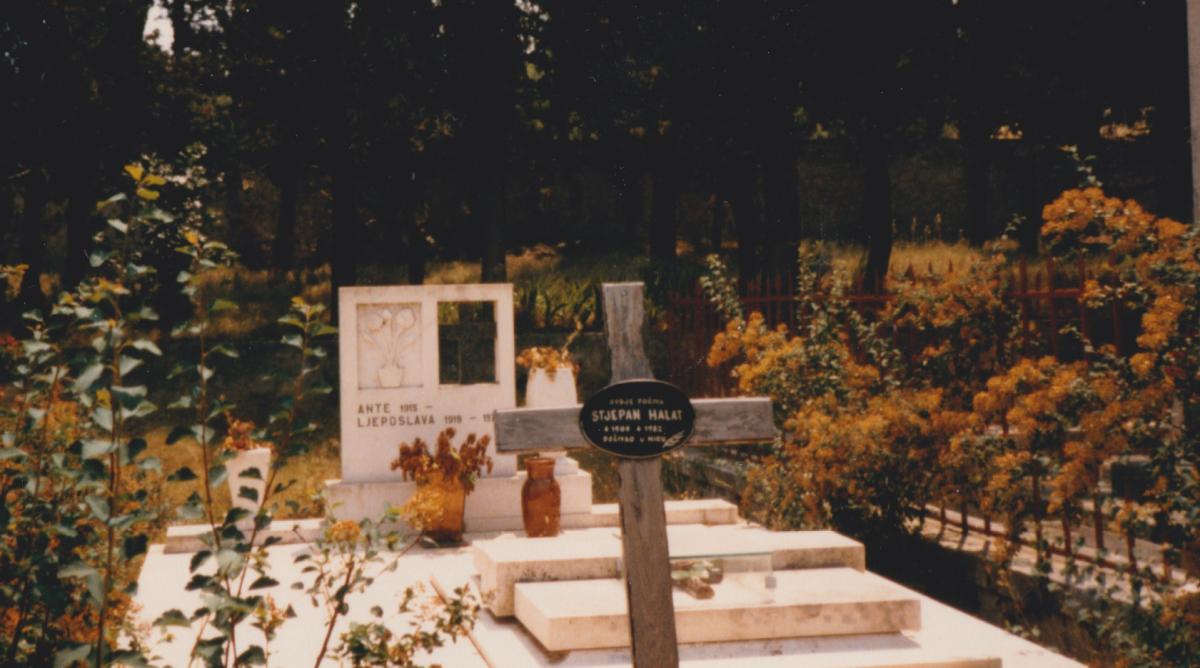

[images by Jacobena "Jackie" Tabb-1985]
HIRE
[images by Jacobena "Jackie" Tabb-1985]
MARINOVICH

[image by Jacobena "Jackie" Tabb-1985]
SEKUL


[images by Jacobena "Jackie" Tabb-1985]
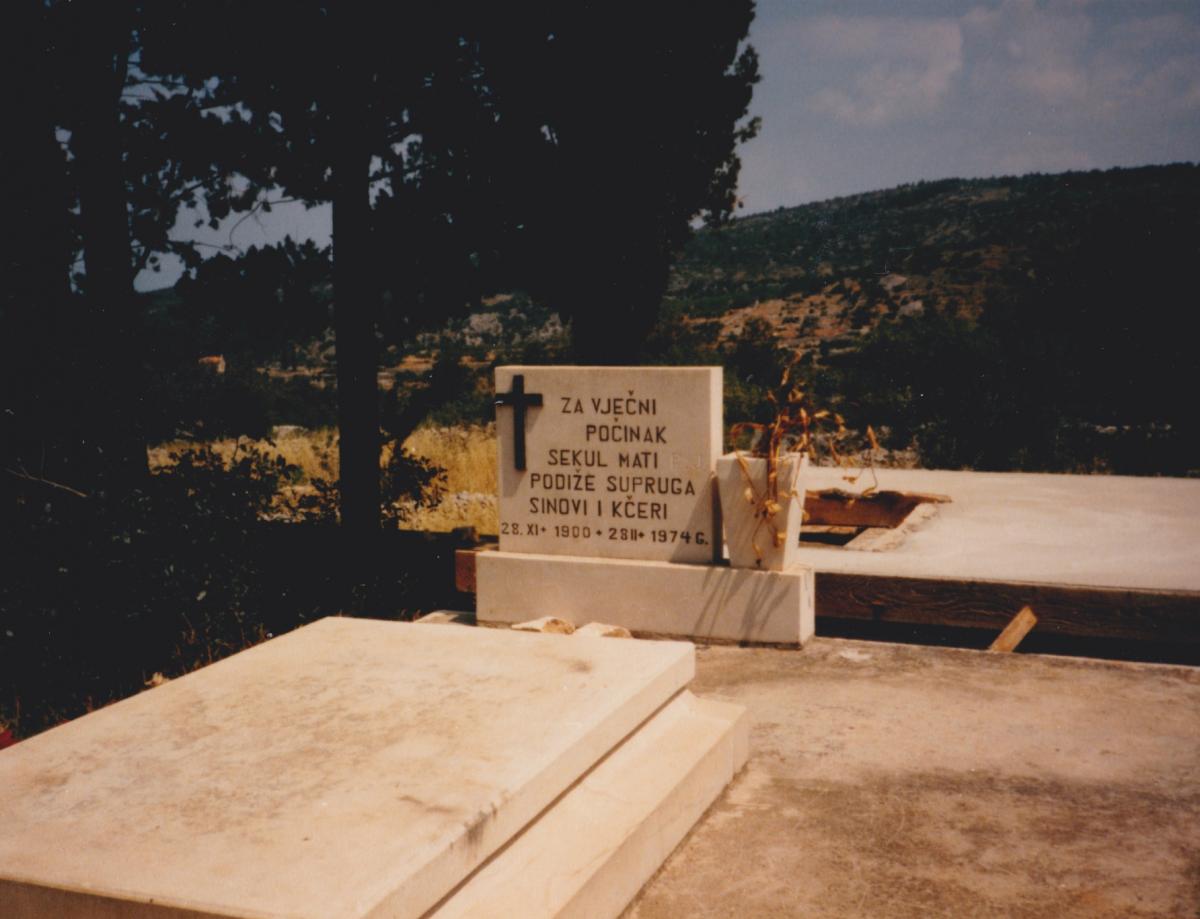

[images by LouAnn Dinero Sekul-November 2016]
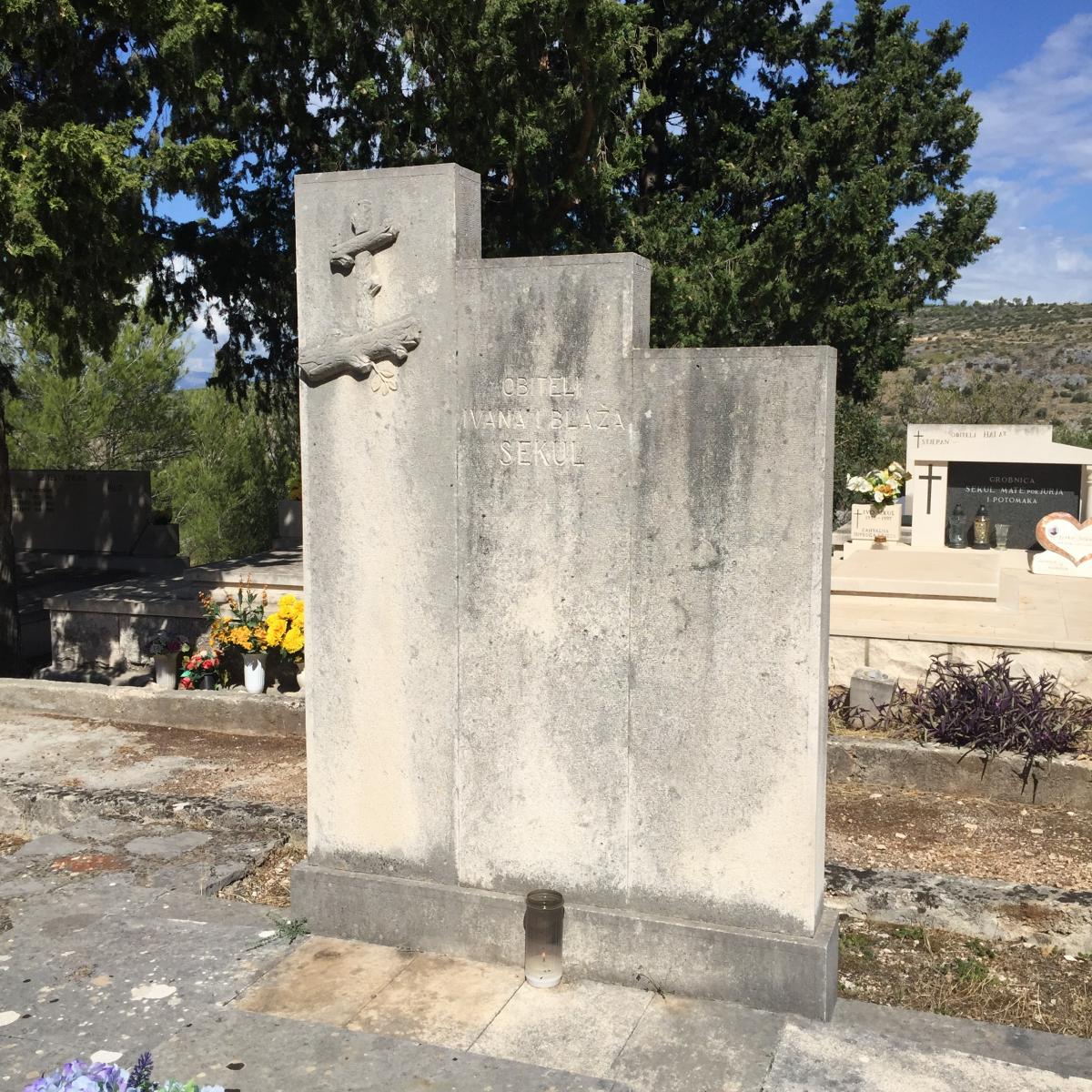
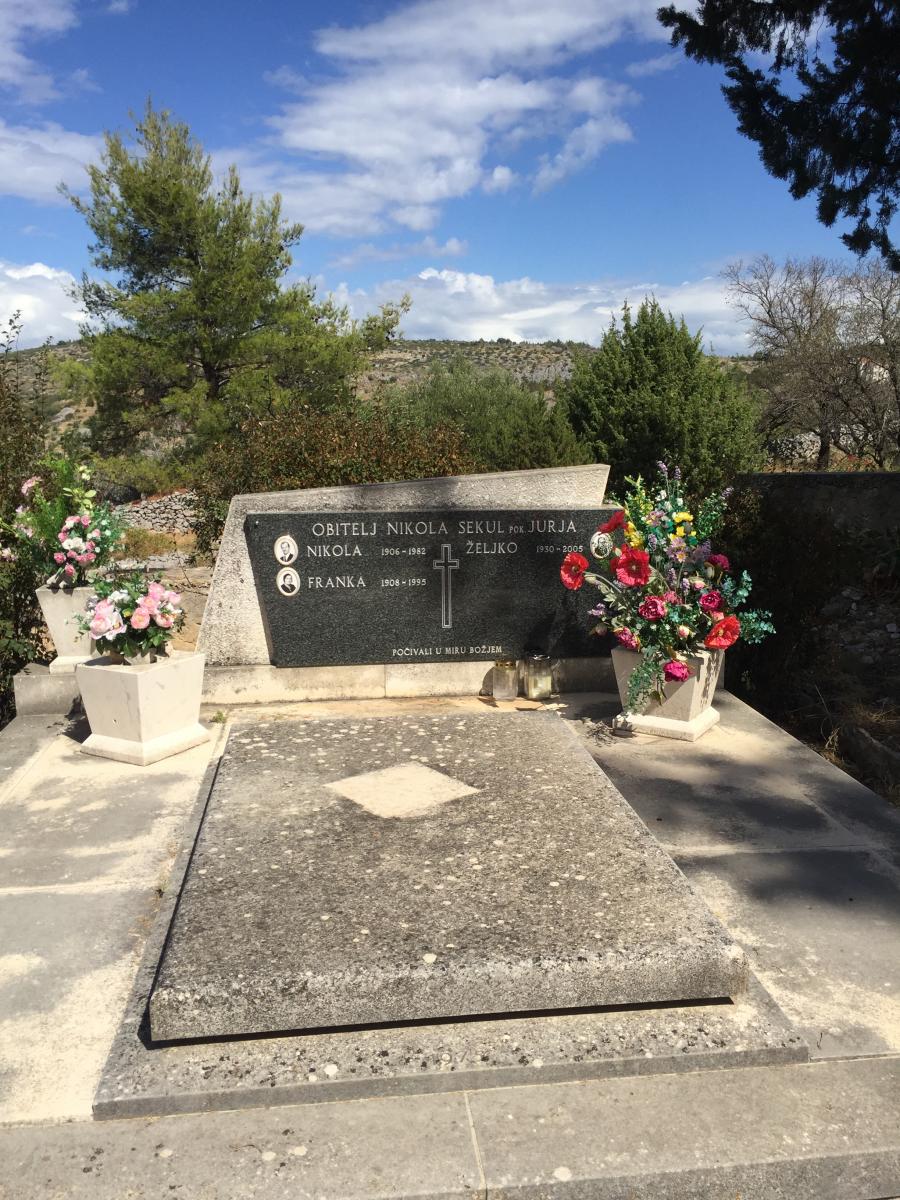
[images by LouAnn Dinero Sekul-November 2016]
SKRMETTA
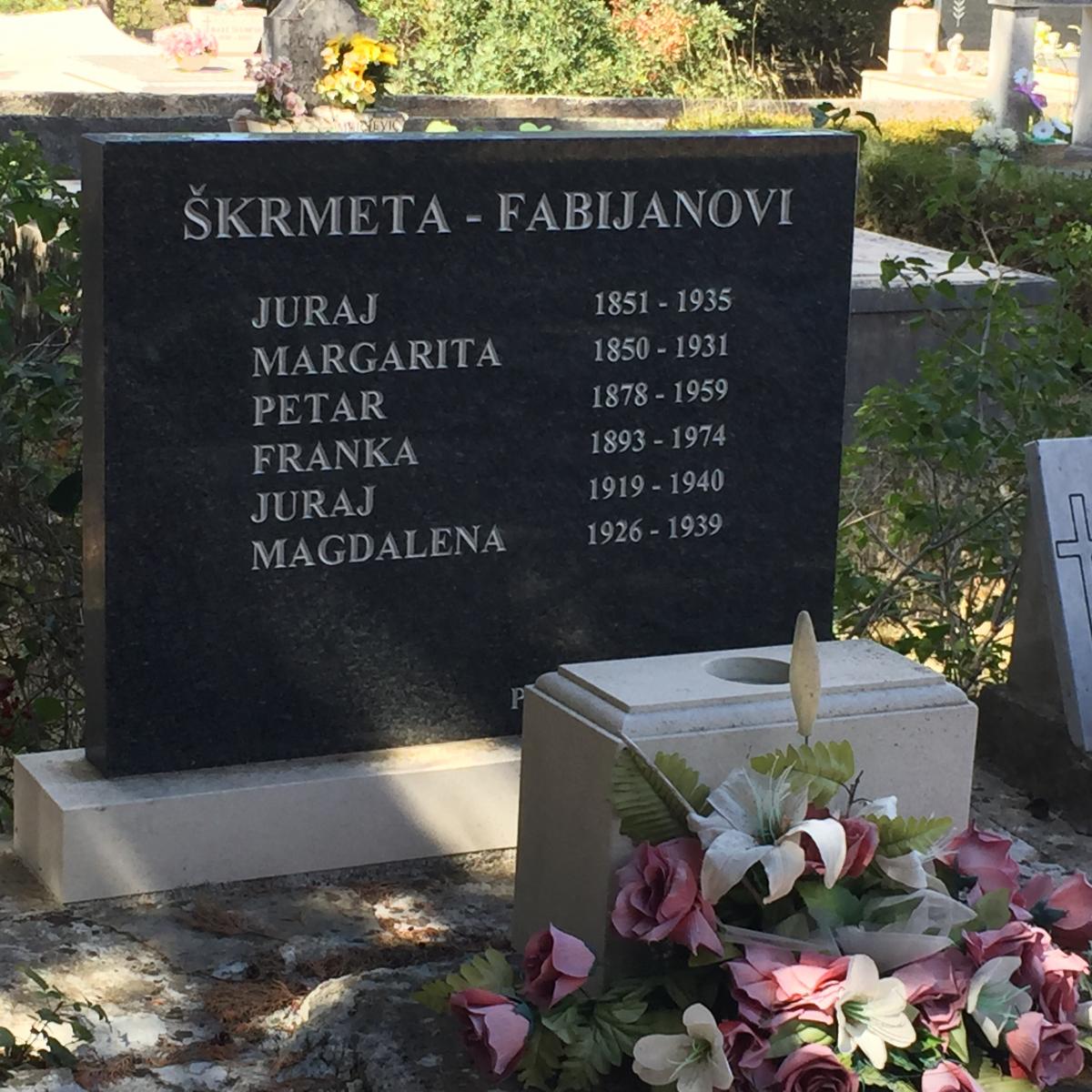
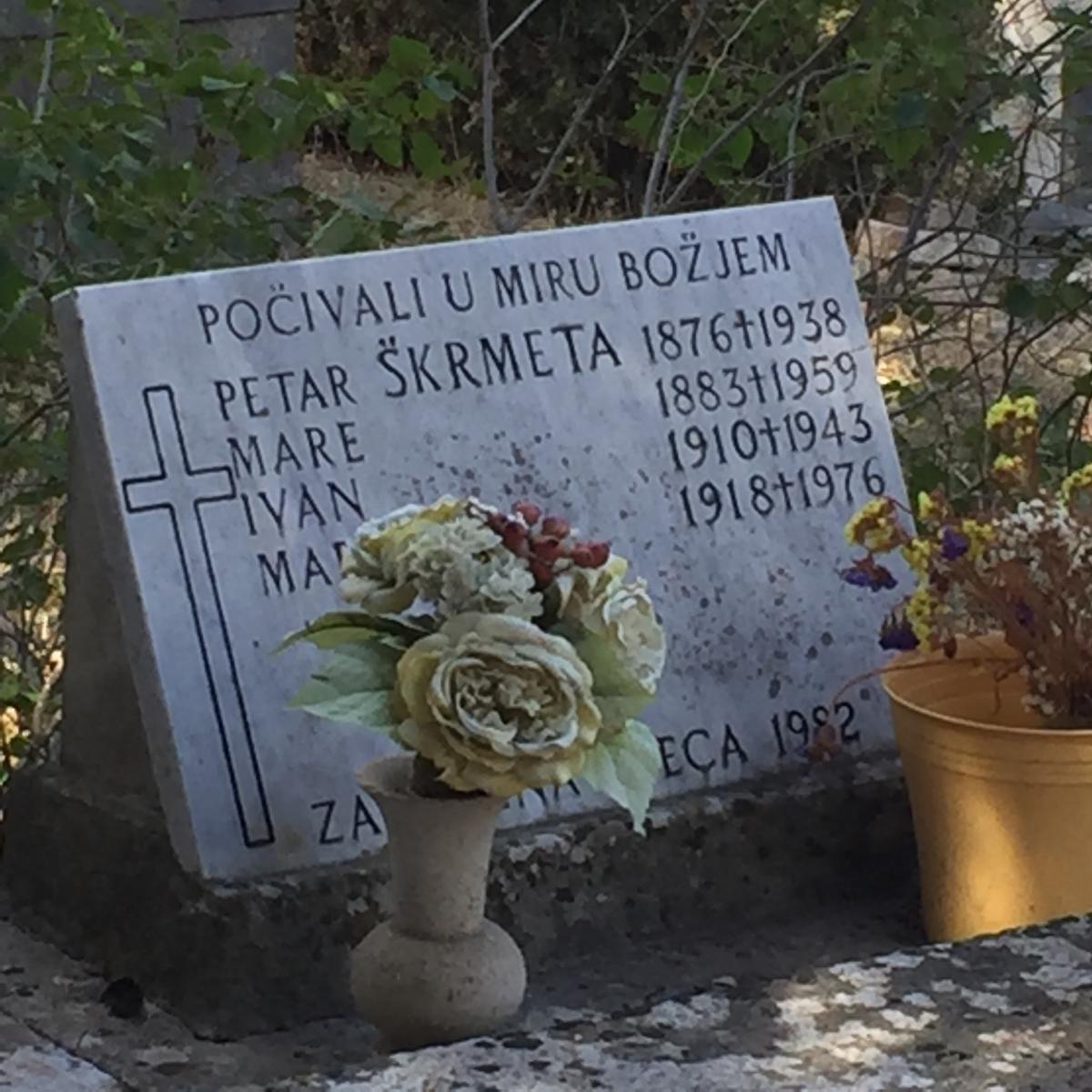
[images by LouAnn Dinero Sekul-November 2016]
TREBOTICH
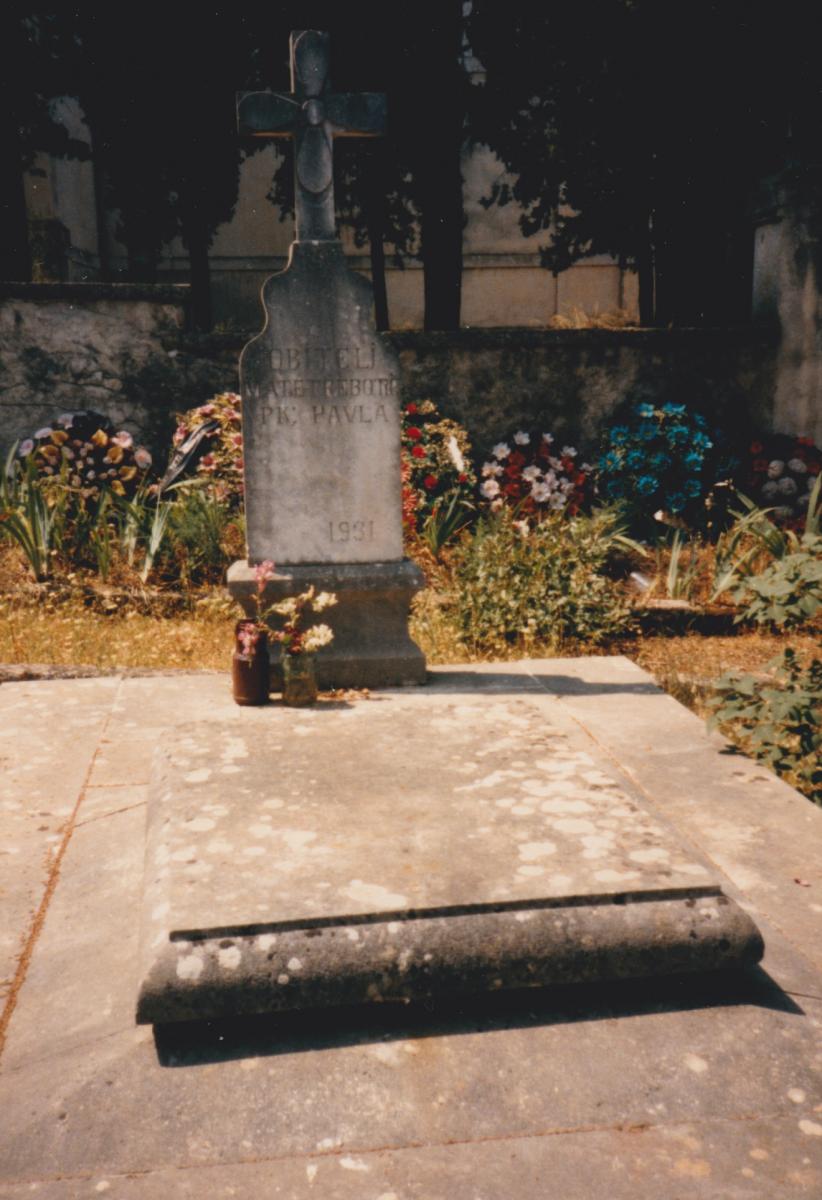
[image by Jacobena "Jackie" Tabb-1985]
Barhonovich, Beaorvich, Cerinich, Cvitanich, Filipich, Gligo, Halat, Hire, Jurich, Kuljis, Maricich [Marich], Marinovich, Mihojevich, Misko, Mladinich, Pierotich, Pitalo, Radich, Rodolfich, Sekul, Skrmetta, Skrnich, Trebotich, and Tremontana.
BARHONOVICH [BARHANOVICH]
Frank Barhonovich
Frank Barhonovich (1889-1963) was born May 21, 1856 at Supetar, Brac, Splitsko-Dalmatia County, Croatia the son of Frank Barhanovich and Maria Barhanovich (1856-1940). He married Mira Kovacevich (1891-1965), a native of Stari Grad on the island of Hvar, Croatia. They were the parents of: Marie V. Barhonovich (1917-2000) m. Peter M. 'Mutt' Jurich (1914-1981); Frances Pauline Barhonovich (1919-1919); Anthony R. Barhonovich (1920-1994) m. and Ruth Alice Hormanski (d. 1999); Antonia Barhonovich ; John F. Barhonovich (1924-1988) m. Gladys Marie Stoute Broussard (); Frank J. Barhonivich Jr. m. Amelia Lechner; and Peter Matre Barhonovich (1931-1991) m. Annette Louise Melancon.
Children
Anthony R. Barhonovich
Anthony Rufinus Barhonovich (1920-1994) was born . He married Ruth Alice Hormanski. Children:
Children
Anthony Rufinus Barhonovich Jr. (1943-2016), age 73, of Biloxi died Saturday, April 30, 2016. Mr. Barhonovich was a lifelong resident of Biloxi. He was a veteran of the U.S. Navy and retired as a Senior Chief. He also was a civil service worker at the Seabee Base. He is preceded in death by his parents, Anthony and Ruth Barhonovich; and brother, Alan Barhonovich. Survivors include his two brothers, Glen Barhonovich and Laverl Barhonovich; several nephews; a niece; and great nephews. A graveside service will be held on Friday, May 6, 2016 at Biloxi National Cemetery at 10:00 a.m. The Howard Avenue Chapel of Bradford-O'Keefe Funeral Home is in charge of arrangements.(The Sun Herald, May 3, 2016)
Alan Barhonovich
Glen Barhonovich
Laverl Barhonovich
John Barhanovich
John Barhanovich (1856-1931) was born March 20, 1856 the son of Frank Barhanovich and Antonia Barhanovich. He married Antonia Paprich (1851-1944) and they settled at 1426 1st Street in Biloxi, Mississippi. Here they reared their children: Frank J. Barhanovich (1886-1930) m. Dominica Sekul (1889-1968) and Antonia Barhanovich (1880-1957) m. John Pierotich (1877-1942).
Antonia Barhanovich
Antonia Barhanovich (1880-1957) married John Pierotich (1877-1942), the son of Matthew Pierotich. In 1920, the Pierotich family was domiciled on Cedar Street and he was employed in the oyster and shrimp industry as a fisherman. John was naturalized at Biloxi, Mississippi in June 1921.(The Daily Herald, June 23, 1921, p. 1)
John Pierotich and Antonia B. Pierotich were the parents of: Matthew Pierotich (1906); Mary Pierotich (1907-1983) m. Jake Mladinich (1902-1967); John Pierotich (1908-1969) m. Hilda Fountain (1915-1991); Anthony Pierotich (1913-1986) m. Sara Nell Lint (1928-1987).
John Pierotich expired March 9, 1942.
Frank J. Barhanovich
Frank J. Barhanovich (1886-1930) married Dominica Sekul (1889-1968). Children: John Barhanovich (1909-1967) m. Gladys Marie Stoute (1909-2001), the widow of Fenlon Broussard ; Anthony Barhanovich (1910-1983) m. Antonia Alberta Stanovich (1915-1975) and Gladys Starkey (1914-2005); Steve Walter Barhanovich (1914-1991) m. Sophie Wells Fayard and Eula Seymour Weeks (1916-1988); Frank 'Yankee' Barhanovich (1915-1987) m. Myrtle Diaz (1916-2015); and Antonia Barhanovich (1917-1918).
Children
John M. Barhanovich
John M. Barhanovich (1909-1967) was born at Biloxi, Mississippi on March 10, 1909. He was a former Capitol police captain in Washington D.C. under Senator Russell Long [D] Louisiana and Senator James O. Eastland [D] Mississippi. John ran a charter boat at Biloxi. He was a member of the Slavonian Lodge and the Mississippi-Tennessee Law Enforcement Officers Association.
John married Lisa Hoelzekammer. He was survived by his spouse; Dominica Barhanovich, his mother; Karl Hutzelmann, son at Chalmette, Louisiana; Ruth Currie, daughter at Clinton, Maryland; three brothers: Frank J. Barhanovich [Biloxi], Steve W. Barhanovich [Biloxi], and Tony J. Barhanovich [Ponchatoula, Louisiana]; and a grandson.
John expired at his residence, 1426 East First Street, on March 23, 1967. His funeral was under the auspices of Bradford-O'Keefe with commitment in Biloxi Cemetery.
Anthony Barhanovich
Anthony Barhanovich (1910-1983), called Tony, was born at Biloxi, Mississippi. He married Gladys and they lived at Ponchatoula, Louisiana. She had three daughters by a prior marriage: Trilby Kincaid; Gaynell Tucker; and Lee Allen. Tony and Gladys had two children: Jackie Barhanovich Campbell and Jock Barhanovich. Tony expired in New Orleans on July 9, 1983. His coproral remians were interred in the Whispering Pines Cemetery at Ponchatoula. Gladys
Steve W. Barhanovich
Steve Walter Barhanivich (1914-1991) was born Febraury 14, 1914 at Biloxi, Mississippi. He married Sophie Wells Fayard in Harrison County, Mississippi on September 24, 1941 and Eula Seymour Weeks (1916-1988) in Harrison County, Mississippi on March 1, 1947.(Harrison Co., Mississippi Chancery Court MRB 53, p. 168 and Bk. 74, p. 79)
Children

Billie Joy Barhanovich
Billie Joy Barhanovich was born on October 5, 1947. She married Mr. Cash and Robert Mark Tucei (b. 1946) on November 1, 1997 in Harrison County, Mississippi.(Harrison County, Mississippi 2nd JD Circuit Court MRB 49, p. 261)

Frank 'Yankee' Barhanovich
Frank 'Yankee' Barhanovich (1915-1987) m. Myrtle Diaz (1916-2015), the daughter of Henry Diaz and Olivia Boney. Children: Martha Ann Barhanovich m. Roy T. Ebberman; Frank Barhanovich m. Judy ; Kenneth Anthony Barhanovich m. Margaret Diana Polite; Katherine Barhanovich m. Charles Polite Jr.; Rita Barhanovich; and Mark Anthony Barhanovich (1957-2012) m. Jerrie Joy Patrick.
BILOXI, Miss. (AP) -- City Councilman Frank "Yankie" Barhanovich Sr. has died after a year-long fight against a blood disorder. The 71-year-old politician died Tuesday night at the Ochsner Foundation Hospital in New Orleans. Barhanovich, a diabetic who suffered from a blood disorder for the past year, was taken to an Ocean Springs hospital a week ago for an infection that resulted in a high fever. He later was transferred to Ochsner.[The Advocate [Baton Rouge], April 9, 1987]

Myrtle D. Barhanovich
Myrtle Diaz Barhanovich (1916-2015), age 98 years, of Biloxi, passed away peacefully at her home on Saturday, February 14, 2015. Myrtle was born on December 16, 1916, to the late Henry and Olivia Boney Diaz, where she was the youngest of 10 children, 7 sisters and 2 brothers. She met the love of her life, Yankie Barhanovich, when she was 16 years old, married him 4 years later, and remained married for 49 years, one month shy of their 50th wedding anniversary if not for his unexpected death. Together, they raised 5 children, as she was a stay-at-home mom her entire life. She was a devout Catholic, attended mass daily, and served on the altar society, where she was the oldest living parishioner of Nativity B.V.M. Catholic Church until the time of her death. She also loved playing Bingo at the Elks Lodge on Friday nights with her sisters in her later years.
She is predeceased in death by her loving husband, Frank “Yankie” Barhanovich, her son Mark Barhanovich, her stillborn daughter Rita Barhanovich, her grandson Roy T. Ebberman III, her great-grandson Zack Fayard, her great-granddaughter, Candace Polite, seven sisters Winnie Fountain, Maggie Borries, Bertha Hutcherson, Stella Cannette, Rita Steinweinder, Dot Page, and Juliet Wheeler, two brothers Henry Diaz and George Diaz, and many nieces and nephews.
Survivors include two daughters Martha Ann Ebberman (Roy), Kathy Polite (Chuck), two sons Frankie Barhanovich, and Kenny Barhanovich (Diane), a daughter-in-law Jerrie Barhanovich, six grandsons Dean Ebberman, Kenny Barhanovich, Jason Polite (Angela), Christian Polite, Chuckie Polite, and Steven Barhanovich, nine granddaughters Donna Derouen (Darney), Chelle Barhanovich, Suzanne Barhanovich, Renee Barhanovich, Rachel Hebert (Greg), Jennifer Morano (Brandon), Amy Polite, Jamie Mitchell, and Dana Barhanovich, nine great granddaughters, nine great grandsons, one great-great granddaughter, and two great-great grandsons.
Visitation will be on Monday, February 16, from 10 am until 12 noon, with a 12 noon Mass of Christian Burial, all at Nativity BVM Cathedral. Burial will follow in Southern Memorial Park. The Howard Avenue Chapel of Bradford O'Keefe Funeral Home is in charge of arrangements.
______________________________________________________
Antonia Barhanovich
REFERENCES:
The Advocate [Baton Rouge], “Anthony Barhanovich", July 10, 1983 , p. 4-B.
The Advocate [Baton Rouge], “Frank "Yankee" Barhanovich Sr.; Biloxi Councilman dies”, April 9, 1987 .
The Biloxi Daily Herald, “Crew Notice”, April 7, 1908.
The Daily Herald, “Frank J. Brohonovich [sic] dies”, May 17, 1930.
The Daily Herald, “John Barhanovich dies”, January 30, 1931.
The Daily Herald, “Mrs. [Mariettea] Barhonovich buried”, May 10, 1940.
The Daily Herald, 'F.J. Barhanovich takes over duties as head of Biloxi K.C. Council', July 15, 1941.
The Daily Herald, “Mrs. [Antonia Barhonovich 93, dies at Biloxi", October 31, 1944.
The Daily Herald, “[Frank Barhanovich III] Barhanovich infant”, May 24, 1957.
The Daily Herald, “Barhanovich is winner of Lions Cup award 1959”, January 1, 1960.
The Daily Herald, “John Barhanovich”, March 23, 1967.
The Daily Star, “Gladys Starkey Barhanovich”, August 17, 2005.
The Sun Herald, “Ruth A. Barhonovich”, April 1, 1999.
The Times Picayune, “Deaths [Dominica Barhanovich]”, May 17, 1968.
The Times Picayune, “Deaths [Anthony Barhanovich]”, July 10, 1983.
The Times Picayune, “Deaths [Roy T. Ebberman]”, January 3, 1987.
The Times Picayune, “Deaths [F. Yankie Barhanovich]”, April 9, 1987.
_______________________________________________________________________________________________
 and Jacobina Sekul (1881-1956).jpg)
Biloxi Cemetery-7th Addition-October 2013
BEAORVICH
Marko Beaorvich (1883-1966) was born at Supetar, Brac, County Split-Dalmatia, Croatia. He was a resident of Biloxi for sixty years and made his livelihood as a fisherman. Marko had married Jacobina Sekul and they lived at 567 Forrest Avenue in Biloxi. Marko was survived by his spouse and three children: Lucas Beaorvich (1907-1969) m. Leona Snear (1909-1976) of Handsboro; Henrietta B. Savage (1911-1999) m. Anthony Cvitanovich, Aden Bellew, and Charles E. Savage (1903-1977), of Ocean Springs; and Eleanor Beaorvich (1913-1994) m. Farrell Grove (1913-1994) of Biloxi.
CHILDREN
.jpg)
Lucas Beaorvich
Lucas Beaorvich (1905-1969) was born at Biloxi, Mississippi on April 5, 1905. He was educated in the public school sustem of Biloxi and took a business course after high school. Lucas married Leona Snaer (1909-1976) in 1930 and they had a daughter, Adele Mary Beaorvich m. Mr. Parks. Circa 1930, Lucas left Biloxi and opened a grocery store in Handsboro. He was the proprietor of this store until 1951 when he acquired the Handsboro Trailer Court. Lucas ran for Tax Assessor of Harrison County in January 1957.(The Daily Herald, December 28, 1956, p. 1)
Lucas Beaorvich expired in October 1969. Leona followed him in death passing in 1976. Their corporal remains were interred in the Floral Hills Cemetery at Gulfport, Mississippi.
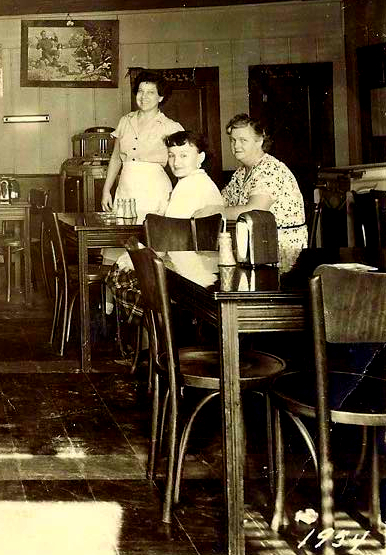

Henrietta working in her cafe on Government Street in 1954 and in the 1980s
Henrietta Beaorvich
Henrietta Beaorvich (1911-1999) was born at Biloxi, Mississippi on September 23, 1911 to Marco Beaorvich (1883-1966) and Jacobina Sekul (1882-1956). She married Anthony Cvitanovich (d. 1957) at Biloxi, Mississippi on June 5, 1926. They had a son, Samuel ‘Sammy’ Cvitanovich (1927-2014), born March 31, 1927 at Biloxi. They divorced and Anthony moved to New Orleans where he died in June 1951.(Harrison Co., Mississippi MRB 38, p. 167 and The Gulf Coast Times, June 14, 1951, p. 2)
Child
.jpg)
Samuel A. Cvitanovich
Samuel ‘Sammy’ Amos Cvitanovich (1927-2014) was born March 31, 1927 at Biloxi and died on Sunday, March 16, 2014 at Ocean Springs. Sammy was lifelong resident of Ocean Springs and was the former owner of Henriettas Café in Ocean Springs for 52 years. His many interests were the love of his family, riding the horn and having his whiskey cocktail. He was also a longtime member of St. Alphonsus Catholic Church and the Slavic Benevolent Society.
Sam was preceded in death by his wife, Mildred "Peachie" Cvitanovich, parents, Anthony Cvitanovich and Henrietta Beaorvich Cvitanovich Bellew Savage, daughter, Mary Ann Cvitanovich and granddaughter, Alicia Ann Allen. Survivors include two daughters, Angela Cvitanovich Vermillion and her companion, Jody Marshall Pigford, Tanya Cvitanovich Guice, three grandsons, Douglas Paul Vermillion II and fiancee, Robyn Ashley Perkett, their unborn daughter, Schella Rose Vermillion, Anthony Michael "Tony Mac" Vermillion and fiancee, Kristy Angelic Allen and Nicholas Anthony Guice, two great-grandchildren, Jessica Ann Saunders and Donald Scott Saunders, and five great-great-grandchildren, Adalee Ann Wilson, Jaxston Nash Wilson, Kaiden Scott Saunders, Jordyn Sky Saunders and Leighla Rose Brown. The family would like to give a special thanks to a cousin, Nadine Marie Sekul, for all of her help. On Saturday, March 22, 2014, there will be an 11 am Mass of Christian Burial, at St. Alphonsus Catholic Church, where friends can visit one hour prior to service. Burial will follow in Evergreen Cemetery in Ocean Springs.(The Sun Herald, March 19, 2014)
Aden S. Bellew
Henrietta Beaorvich Cvitanovich (1911-1999) married Aden S. Bellew (1907-1981) at Mobile, Alabama in September 1936. He (1907-1981) was born August 22, 1907, the son of John Bellew (1859-1945) and Elizabeth Williams (1871-1910+). John Bellew was born July 17, 1859, the son of Irish immigrant, John Bellew (1835-ca 1865), and Delphine Holley Bellew Dampfman (1840-1910), the daughter of William Holley (1803-1850+) and Adeline Richard (1812-1850+). His siblings were: Eliza Bellew (b. 1860) m. John T. Hudson and Margaret Bellew (1865-1942) m. Anthony Santa Cruz (1853-1939).(Lepre, 1970, pp. 83-87)
John Bellew and Elizabeth Williams married in Harrison County, Mississippi on January 31, 1889.(Guice, p. 47) In addition to Aden S. Bellew, their other children were: Della Bellew (b. 1890), Singleton Bellew (1892-1968), Preston Bellew (b. 1895), Mary Bellew (b. 1897), Aliard? Bellew (b. 1899), Thomas Bellew, Eliot Bellew, Mrs. R.S. Williams, and Mrs. Cruthirds. John Bellew was born in the Woolmarket community of rural Harrison County, Mississippi. Elizabeth Williams was a native of Louisiana, but both of her parents were natives of Mississippi. As a young man, John Bellew made his livelihood as a log cutter at a sawmill. He remained in the timber industry and retired as a successful lumberman. Mr. John Bellew expired in March 1945.(The Jackson County Times, March 17, 1945, p. 1 and 1900 and 1910 Harrison Co., Mississippi)
In 1931, Aden S. Bellew resided at Ramsay Springs and was the proprietor of the Four Brothers Meat Market. At the time of his marriage to Henrietta B. Cvitanovich in September1936, Aden S. Bellew was a local dairyman at Biloxi. The newlyweds resided at 1429 4th Street on Point Cadet in Biloxi.(The Daily Herald, February 3, 1936, p. 5)
In 1941, Aden S. Bellew was operating the Pine Grove Grocery on the corner of Copp Street and Nixon in Biloxi.(Biloxi City Directory). Bellew probably moved to Ocean Springs in June 1941, when he bought the A.M. Usner place from Frank B. Faessel (1870-1953) located in Lot 4 on East Beach. Charles Yarbrough resides here today. He acquired the property from Mr. Bellew in September 1973.(JXCO, Ms. Land Deed Bk. 478, p. 46). Bellew’s new spouse was, Laura Bellew (1906-1992).(Jackson Co., Mississippi Land Deed Bk. 77, p. 392)
In February 1943, Henrietta B. Bellew commenced a restaurant business at present day 1013 Government Street, which became the legendary Henrietta’s Café. Aden S. Bellew sold the Goverment Street property to his wife, Henrietta Beaorvich, on November 11, 1946. They divorced and she later married Charles Edward Savage (1903-1977), a L&N Railroad engineer from Wawbeek, Alabama. Henrietta B. Savage remained in business until 1995.(Jackson Co., Mississippi Land Deed Bk. 96, p. 4) .
Aden S. Bellew expired at Saucier, Mississippi on March 19, 1981.
Anthony Cvitanovich, father of Sammy, expired at New Orleans in June 1951.(The Gulf Coast Times, June 14, 1951, p. 2)
Henrietta’s Cafe
Henrietta's Café opened for business in February 1943, in the Engbarth building on Government Street in Ocean Springs, Mississippi Aden S. Bellew sold his café and lot on Government Street property in Ocean Springs to his wife, Henrietta Beaorvich, on November 11, 1946.(JXCO, Ms. Land Deed Bk. 96, p. 4)
1951 Renovations
In January 1951, Henrietta’s Café was extensively refurbished. The building was divided with the restaurant on the west side and a rental space on the east side. Two large rental units were created in the rear of the building, which faces Desoto Avenue. A new kitchen was established and the package store was situated in the restaurant.(The Gulf Coast Times, January 12, 1951, p. 5)
In April 1951, Henrietta Savage acquired a newsstand at Biloxi. It was situated on the west side of town. She planned to operate the Biloxi business herself and leave the responsibility for her café business at Ocean Springs to Sammy and Peaches Cvitanovich.(The Gulf Coast Times, April 19, 1951, p. 2).
Henrietta’s Café closed May 20, 1995. Mrs. Savage was honored by a downtown parade at Ocean Springs on
Charles E. Savage
Henrietta B. Bellew married Charles Edward Savage (1903-1977), a railroad engineer from Wawbeek, Alabama. Mr. Savage came to Ocean Springs circa 1950. They were residing at 1013 Government at time of his demise.(The Sun Herald, December 11, 1977, p. A-2)
Eleanor D. Beaorvich
Eleanor Domenica Bearovich (1913-1994) was born at Biloxi, Mississippi on April 6,1913. She married Louis Elbert Wentzell (1894-1953), the son of Charles H. Wetzell and Alice Cox, in Harrison County, Mississippi on January 31, 1935. They were the parents of Jacquelyn Wentzell m. Peter M. Skrmetta; Mrs. Joseph Janus; Louis E. Wentzell Jr.; Jack Wentzell; Edward Wentzell; and William Wentzell.(Harrison Co., Mississippi Circuit Court MRB 45, p. 584)
Louis E. Wentzell expired on October 30, 1953.
Eleanor had several marriages after the demise of Louis E. Wentzell. She married Claude Evon Johnson in June 1957 and Richard A. Grove (1930-1997) in Harrison County, Mississippi on April 6, 1974.(Harrison Co., Mississsippi 2nd JD Circuit Court MRB 9, p. 131)
REFERENCES:
The Bay Press, “From Henrietta’s to Memories”, March 13, 2002.
The Daily Herald, "Announce Marriage", February 3, 1936.
The Daily Herald, “Wentzell funeral Sunday afternoon”, October 31, 1953.
The Daily Herald, “Mrs. Jacobina Beaorvich”, November 1, 1956.
The Daily Herald, “Lucas Beaorvich enters Harrison Assessor's Race”, December 28, 1956.
The Daily Herald, “Marko Beaorvich”, September 17, 1966.
The Gulf Coast Times, “Henrietta’s Café Being Renovated”, January 12, 1951.
The Gulf Coast Times, “Mrs. Savage Buys New Business”, April 19, 1951.
The Gulf Coast Times, “Personal Items”, April 19, 1951.
The Gulf Coast Times, “Personal Items”, June 14, 1951.
The Jackson County Times, “John Bellew Dies”, March 17, 1945.
The Ocean Springs News, “Mrs. Jacobina Veaorvich (sic)”, November 8, 1956.
The Ocean Springs Record, “Street paving approved at Henrietta’s Café”, June 10, 1971.
The Ocean Springs Record, "Friends Toast Henrietta's 40th", February 24, 1983.
The Ocean Springs Record, “Henrietta’s legacy carries on at new diner”, August 17, 1985.
The Ocean Springs Record,"Henrietta’s reaches agreement", January 14, 1993.
The Ocean Springs Record,"Henrietta’s celebrates 50th", February 25, 1993.
The Ocean Springs Record,"Henrietta’s shuts down, ends 52-year tradition”, May 25, 1995.
The Sun Herald, "Charles Edward Savage", December 11, 1977.
The Sun Herald, “Eleanor Beaorvich Grove”, November 23, 1994.
The Sun Herald, 'Richard A. Grove', July 22, 1997, p. A2.
The Sun Herald, “Henrietta Savage”, December 8, 1999.
The Sun Herald, “Henrietta’s passing ends a quieter era”, December 8, 1999.
The Sun Herald, “Samuel Amos Cvitanovich”, March 19, 2014.
_____________________________________________________________________________________________
BONICICH
Mary Consetta Bonicich Thian (1881-1972), age 90 years, died at 7:15 a.m. Saturday at Howard Memorial Hospital in Biloxi where she had been a patient for three days. She was the widow of Anthony Thian (1866-1932) and resided at 404 Dorries Street in Biloxi.
Mary was born at Milna, Isle of Brac, Split-Dalmatia County, Croatia. She had been a resident of the Coast for 74 years. Mrs. Thian was a parishioner of St. Michael's Catholic Church and the a member of the Slavonian Ladies Auxiliary.
Mary was survived by three daughters, Ola T. Drouant and Mary T. Gilham, both of New Orleans, and Josephine T. Mazurette of Austin, Texas; two sons, Steve Julius Thian (1920-2011) m. Mary Zorich (1922-2010) of Biloxi and Victor Thian of New Orleans; nine grandchildren; and 11 great grandchildren.
REFERENCES:
The Daily Herald, 'Anthony Thion [sic] dies', January 28, 1932, p. 2.
The Daily Herald, 'Inquest for A. Thian', January 29, 1932, p. 2.
The Daily Herald, 'Mrs. Mary Thian', February 27, 1972, p. 2.
The Sun Herald, 'Mary Zorich Thian', July 13, 2010.
The Sun Herald, Steve Julius Thian', December 11, 2011.
_____________________________________________________________________________
CERINICH
Peter Cerinich (1894-1951) married Alena Sekul (1908-2002), the daughter of Steve M. Sekul (1880-1966) and Elena Trebotich (1884-1970), at Biloxi on January 6, 1926. They were the parents of three children: Nicholas Douglas Cerinich (1926-2002) m. Gilda Astleford Wambsgans (1928-1976) and Betty Joyce Lawrence; Jeanette Cerinich (1928-2011+) m. Louis E. Capuana Sr. (1925-2005); and Patricia Cerenich (1938-2016) m. Joseph Powell.(Harrison Co., Mississippi Circuit Court MRB 37, p. 485)
In late April, Peter Cerinich (1894-1951) let a contract with Joseph Wallace to build a new store and residenceon West Howard Avenue and Seal Avenue. I. Daniel Gehr designed the structures. Clarence Kornman moved two houses from the Cerinich lot before construction commenced. Other contractors were: Lester Frentz-painting; Albert Mangin-plumbing and electrical; and Biloxi Roof and Sheet Metal-roofing and metal work. The Cerinich store was called the Biloxi Cash Grocery and operated by Alena Sekul Cerinich (1908-2002) for over fifty years.(The Daily Herald, April 27, 1940, p. 3 and The Sun Herald, July 6, 2002, p. A6)
Children
Patricia Cerenich
On January 2, 2016, heaven received a bright new star, when Patricia "Patsy" Cerinich Powell went home to rest. She began her journey from her childhood home surrounded by the family she loved. She was born in Biloxi, MS on December 20, 1938, she graduated from Sacred Heart Academy and attended Mississippi Southern College for two years before raising a family with her husband of 57 years, Joseph "Sonny Boy" Powell in St. Bernard, LA; she returned to the home of her Mother following Hurricane Katrina in 2005. She was an active member of the Slavic ladies Auxiliary, and she loved her Thursday Ladies Night with the girls, Susie B., Linda B., Jeanette C., Karole E., and Clare H.
She is preceded in death by her parents, Peter Cerinich and Alena Sekul Cerinich; grandparents, Stephen M. Sekul and Elena Trebotich Sekul; brother Nick Cerinich; and sisters-in-law, Gilda Cerinich and Betty Cerinich; brothers-in-law, Louis Capuano and Randy Berta; niece, Stephanie Capuano; aunts, Jacobina Gilich, Josephine Schaaf, Vestie Gabrich and Rita Elezovich; and uncles, John Sekul and Tony Cerinich.
She is survived, loved and dearly missed by her husband, Joseph "Sonny Boy" Powell; children, Karen (Paul) Gares, Karole Elfert, Jeff (Melanie) Powell, Susan (Steve) Porcuna and Joseph (Tanya) Powell, Jr.; grandchildren, Ross (Alicia) Gares, Paul Gares, Trinitee (Gus) Frame; Christopher Powell, Katy (CJ) McLennan, Kyle and Ashley Porcuna, and Jillian and Connor Powell; great grandchildren, Graham and Garrett Gares, and Hannah and Alena Frame; sister, Jeanette Cerinich Capuano; aunt, Clare S. Hornsby; sisters-in-law, Yvonne (Elvin) Battaya and Elaine Berta; and all of her many cousins, nieces and nephews.
Visitation will be held on Wednesday, January 6, 2016 at the Howard Avenue Chapel of Bradford-O'Keefe Funeral Home from 6:00 p.m. until 8:00 p.m. A Mass of Christian Burial will be held Thursday, January 7, 2016 at 10:30 a.m. at the Nativity of the Blessed Virgin Mary Cathedral. Family and friends are invited to visit one hour prior. Interment will follow at Bosarge Cemetery.
Thomas Cerinich
Thomas Cerinich [died before March 1985 in Hamilton Hill, Western Australia] was born at Bobovisce, Brac, County Split-Dalmatia and married Maria Sekul in Brac. She was the daughter of Steve M. Sekul (1880-1966) and Elena Trebotich (1884-1970). Thomas and Maria Sekul Cerinich were the parents of: Anton 'Tony' Cerinich (1928-1985) m. June ?; Mary Cerinich Mosley and Ella Cerinich Senior, both of Hamilton, Hill, Western Australia.(The Daily Herald, March 22, 1985, p. A-2)
Anton Cerinich
Anton 'Tony' Cerinich(1928-1985) was born at Bobovisce, Brac and immigrated to Australia with his family. Tony passed at Sydney, Australia on March 19, 1985. He made his livelihood as assistant director of Custodial Services NW Division, New South Wales, Australia. Tony was survived by his mother, Mrs. Maria Sekul Cerinich, the widow of Thomas Cerinich of Hamilton Hill, Western Australia; June Cerinich, his widow, of Sydney, Australia; daughter, Carolyn Cerinich Chinn m. Peter Chinn of Canberra, Australia; son, Rodney Cerinich of Kiama, Australia;and two sisters, Mary Cerinich Mosley and Ella Cerinich Senior, both of Hamilton, Hill, Western Australia. Tony was also survived by many relatives in Biloxi, including his aunt, Alena Sekul Cerinich, Mrs. Peter Cerinich.(The Daily Herald, March 22, 1985, p. A-2)
The Daily Herald, "Peter Cerinich, Biloxi grocery store owner, dies", June 14, 1951.
The Daily Herald, "City Hall Cash Grocery closes", Ocotber 18, 1951.
The Daily Herald, "Tony Cerinich", March 22, 1985.
___________________________________________________________________
COVICH
Rosalie Covich
Rosalie Covich Isola, age 86 years of Sterling Heights, Michigan, passed away January 13, 2016. Beloved wife of the late John R. Isola. Loving mother of Susan (Gerald) Essiambre, Dianne (Scott Short) Owen, Andrew (Beth), Michael (Kim) and Peggy (Terry) Jerome. Proud grandmother of Erin, Jason, Kelly, Max, Kate, Annie and Tess. Great grandmother of Ava, William and Johnny. Dearest sister of Rita Forbes, Marie Frentz, Ronnie Covich, Betty Jean (Kenny) Hughes, the late Jerry Covich, Jr (Shannon) and the late Rudy Covich. Visitation will be Sunday, January 17, 2016 from 2:00 to 9:00pm Funeral services will be held Monday, January 18, 2016 at 11:00am at Wujek-Calcaterra & Sons Inc., 36900 Schoenherr at Metro Parkway (16 Mile). Interment will be at White Chapel Cemetery.
REFERENCES:
______________________________________________
CVITANICH
Vincent Cvitanich (1873-1947) was born at Milna, Brac, Split-Dalmatia County, Croatia in 1873. He came to Biloxi, Mississippi circa 1907. He married Mary U. Grinovich (1880-1946). They had a child: Frances Cvitanovich (1901-1979) who married Joseph Smolcich (1893-1967).(Harrison County, Mississippi Circuit Court MRB 29, p. 38)
Mary Grinovich was also a native of Milna, Brac, Split-Dalmatia County, Croatia. She died at Biloxi, Mississippi on August 6, 1946 at her residence 402 Oak Street. Father Herbert Mullin of St. Michael's Catholic Church conducted funeral services with internment in Biloxi Cemetery. Pallbearers were: Joseph Smolcich Jr., Vincent Smolcich, Raymond C. Barry, Steve Buzolich, Veen Lee, and Steve Smolcich.(The Daily Herald, August 9, 1946, p. 5)
Frances Cvitanich
Frances Cvitanovich (1901-1979) married Joseph Smolcich (1893-1967) on May 22, 1916 at Biloxi, Mississippi. Children: Matilda Smolcich (b. 1920) m. Raymond C. Barry (1905-1988); Joseph 'Smoky Joe' A. Smolcich (1922-2010) m. Anna Kopszywa (1927-2010); Vincent L. Smolcich (1925-1981) m. Aurora Marie Saujon (1924-2007), the daughter of Robert Saujon (1865-1944) and Mary McCaleb (1897-1937); Steve Anthony Smolcich m. Patricia Lee Wilson; Mary Rita 'Melrita' Smolcich m. Marvin Lee Raesner; Samuel Dominick Smolcich (1934-2006) m. Vinnie Elva Seymour; and John Anthony Smolcich (1937-2001) m. Jeanet M. Smolcich. The Smolcich family started the Biloxi Seafood Company, the Roxy Theatre at 1430 East Howard Avenue, the Roxy Restaurant and owned much rental property on Point Cadet in East Biloxi.(Harrison County, Mississippi Circuit Court MRB 29, p. 38 and The Sun Herald, October 12, 2010, p. A4)
REFERENCES:
The Daily Herald, “Mrs. Cvitanich funeral”, August 9, 1946.
The Daily Herald, “Cvitanich death”, June 9, 1947.
The Daily Herald, “Frances C. Smolcich”, February 13, 1979.
The Daily Herald, “Vincent Smolcich”, 1981.
The Sun Herald, “Aurora Marie Saujon Smolich”, April 5, 2002.
The Sun Herald, “John Anthony Smolich”, August 31, 2001.
______________________________________________________________________________
FILIPICH
Nikola Filipich (1859-1931) and Lucy Skrnich (1867-1941) were from Milna, Brac, Croatia. Children: Steve Filipich (1895-1934) m. Clara Leleaux (1903-1929); Antonio Filipich (1897-1969) m. Mariga [Mary] Mihojevich (1899-1918) and Jennie Antonsich (1905-1977); Nicholas 'Meco' P. Filipich;(1902-1957) m. Marguerite Sekul (1909-1987); and Frank Filipich (1908-1961).

STEVE FILIPICH
Steve Filipich (1895-1934) was born at Milna, Brac, Croatia on September 3, 1895. He arrived in America on November 23, 1907 from Trieste and settled with his parents at 1303 1st Street on Point Cadet. Steve Filipich applied for his declaration of citizenship in the Southern District Court of Mississippi on August 10, 1916 and he was naturalized on June 20, 1921.(Declaration of Intention No. 281-S.Mississippi District Court-1916 and The Daily Herald, June 17, 1920, p. 4)
Steve Filipich married Clara Leleaux (1903-1929), the daughter of Hypolite Leleaux and Euphresine Dubois (1833-1936), on . There children were: Emerite Lucille Filipich (1921-1921); Margaret Filipich (1923-2018) m. Edward Soper (1916-1995); Clara Filipich (b. 1925); Nicholas Filipich (1927-2001) and Stephen Filipich (1928-1932).
Children

ANTONIO 'TONY' FILIPICH
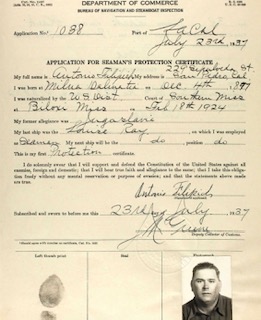
NICHOLAS 'MECO' P. FILIPICH
Nicholas 'Meco' Paul Filipich (1902-1957) was born at Milna, Brac on august 18, 1902. He married Marguerite Sekul (1909-1987), the daughter of Steve C. Sekul (1881-1970) and Lucia Trebotich (1887-1918), in Harrison County, Mississippi on June 30, 1926. Their children: Nicholas 'K-9' Paul Filipich II (1928-2000) m. Betty Fryfogle (1931-2014); Lucy 'Sue' Filipich (b. 1930) m. George A. Trebotich (1919-2014); Jeanette Filipich (1933-2011) m. Matthew F. Kuluz, M.D.; Judy Ann Filipich; and Stephen 'Stip' A. Filipich (1935-2001).

REFERENCES:
The Daily Herald, “Filipich-Mihojevich”, December 22, 1917.
The Daily Herald, “Steve Filipich preparing for citizenship”, June 17, 1920.
The Daily Herald, “Child dead”, October 4, 1921.
The Daily Herald, “Filipich funeral”, January 22, 1931.
The Daily Herald, “Mrs. Filipich dies”, April 28, 1941.
The Daily Herald, “Butorovich-Filipich”, January 26, 1950.
The Daily Herald, “Mrs. Jennie Antonsich Filipich”, February 20, 1977.
The Sun Herald, “”,
The Sun Herald, “Margaret 'Nana' Filipich Soper”, March 5, 2018.
GLIGO
Palmiro Gligo(1884-1949) was born on January 1, 1884 at Bobovisca, Brac, Split-Dalmatia County, Croatia. His mother’s name may have been Vaccaria. Palmiro arrived at New York City on June 30, 1902 aboard La Britagne sailing from La Havre, France. Palmiro was single, a clerk and the nephew of Nikola Skrmetta of Biloxi, Mississippi.(NY Passenger List, T715, R287, Line 29, p. 52)
Palmiro Gligo married Vincenza Skrmetta (1883-1905) and Sam Mihojevich married Perina Skrmetta in Biloxi, Harrison County, Mississippi on June 13, 1904 at the Catholic Church of the N.B.V.M. The Gligos were domiciled on Oak Street when Vincenza expired on October 29, 1905. She had lived at Biloxi since 1901 and they had no children.(The Biloxi Daily Herald, June 14, 1904, p. 1 and October 30, 1905, p. 1 and Harrison Co., Mississippi Circuit Court MRB 15, p. 396)
Circa 1907, Palmiro Gligo married Marica Sekul (1888-1948), the daughter of Antonio Sekul (1854-1940) and Helena Skrmetta. Marica was born at Bobovisca, Brac, Croatia and came to Biloxi, Mississippi in 1902.
In 1910, Palmiro and Marica Sekul Gligo were residents of Sacramento, California. Here Palmiro made his livelihood working in an office building. Their first son, George J. Gligo (1911-1984) was born here in June 1911.(1910 Sacramento Co., California Federal Census T624_92, p. 17B, ED 104)
By 1920, the Gligo family had relocated to San Pedro, Los Angeles County, California. Here Palmiro entered the commercial seafood industry as a fisherman, probably as a tuna fisherman.(1920 Los Angeles Co., California Federal Census, T625_111, p. 20A, ED 312)
Marica Sekul Gligo died on February 5, 1948 at 658 West 8th Street in San Pedro, Los Angeles County, California. She was survived by her spouse, three sons, and four brothers: Steve M. Sekul and Peter Sekul of Biloxi, Mississippi and John Sekul and Mark Sekul of Chile, South America; seven sisters: Mrs. [Vencenta] Sam Marinovich; Mrs. [Jacobina] Mike Beovich [sic]; Mrs. Domenica Barhonovich; Mrs. [Catherine] Alex Pitalo, Mrs. [Ursula] Louis Pitalo, all of Biloxi, Mississippi, and Sister Mary Josephine, Convent of Mercy, Split, Yugoslavia, and Mrs. Tom Cerenich of Australia.(The Daily Herald, February 6, 1948, p. 7)
Palmiro Gligo died at San Pedro, California on January 24, 1949.
Children
George J. Gligo (1911-1984) was born June 6, 1911 at Sacramento, California. He died in July 1984 at Palos Verdes, Los Angeles County, California. No further information.
Palmiro Gligo
Palmiro Gligo (1917-2008) was born at Sacramento, California on September 8, 1917 and was the second child of Palmiro and Marica Gligo. Palmiro is survived by his daughter and son-in-law, Stephanie and Thomas Hart; his two granddaughters and their husbands, Paula and Samuel Spence and Amy and Matthew Dow; his great-grandchildren, Anthony Spence, Heather Dow, Ian Dow and Nicholas Spence; nephews and their families, Joseph and Kathy Gligo and John and Joyce Gligo; and niece, Rita Corpus. He was predeceased by his parents, his brothers, George Gligo and John Gligo, and his wife, Dorothy Gligo (1919-1987)
A 90 year resident of San Pedro and Rancho Palos Verdes, California, Palmiro maintained strong ties to the early San Pedro community members that he grew up with on 8th street in San Pedro and worked with in the San Pedro fishing industry. Palmiro retired from his position as Vice President of Procurement and International Operations for Star Kist Foods, Inc., in 1985. Throughout his long career in the fishing industry, he enjoyed the opportunity to visit and live in many countries around the world including Peru, Italy, Guam, Panama, the Philippines, and many small nations in Africa. The many friends and colleagues that he left in each place continued to call on his expertise and sage advice long after his retirement. In 1939, Palmiro earned a Bachelor of Arts in business from Loyola University where he attended on an academic scholarship and played football. He was the first in his family to graduate from college. As a young man, he was an avid and skilled bowler and boasted many victories and trophies. In later years, he enjoyed golf and spent many days with his family in Palm Springs. Palmiro loved the Los Angeles Lakers and rarely missed watching a game. A Rosary service will be held at Green Hills Memorial Park Chapel, 27501 South Western Avenue, Rancho Palos Verdes, on Sunday, November 23 at 6:30pm.
John V. Gligo
John Victor Gligo (1924-2007) was a lifetime resident of San Pedro, California. He was born April 16, 1924, and passed away November 19, 2007. "Big John" as he was known by his friends, was one of the greatest all around athletes to play football and baseball for San Pedro High School. John is an honored member of the San Pedro Sports Walk Hall of Fame. Upon graduation from high school, John attended the University of San Francisco on an athletic scholarship. With the outbreak of World War II, John served his country honorably for the U.S. Army stationed in the South Pacific.
Upon discharge, John embarked on a career in the fishing industry; first as a commercial fisherman and then as a plant supervisor for Star Kist Foods. John is survived by his brother, Palmiro Gligo, of Rancho Palos Verdes; and by his son, John Jr. and his daughter, Rita Corpuz of San Clemente. A viewing will be held at Green Hills Mortuary on Wednesday, November 21, 2007 from 10am until 6pm. Funeral services will be held at Green Hills Memorial Chapel on Friday, November 23, 2007 at 9am.
REFERENCES:
The Biloxi Daily Herald, “Hymenal”, June 14, 1904.
The Biloxi Daily Herald, “Deaths”, October 30, 1905.
The Daily Breeze [Torrance, California], “John Victor Gligo”, November 20, 2007.
The Daily Breeze [Torrance, California],“John Gligo and Henry Pacheco: Jolly Roger at half-staff for Gligo, Pacheco”, December 1, 2007.
The Daily Breeze [Torrance, California], , “Palmiro Gligo, ”, November 21, 2008.
The Daily Herald, “Palermo [sic]Gligo of San Pedro wants copy”, January 29, 1920.
The Daily Herald, “Mrs. P. Gligo dies”, February 6, 1948.
The Daily Herald, “Gligo funeral”, February 7, 1948.
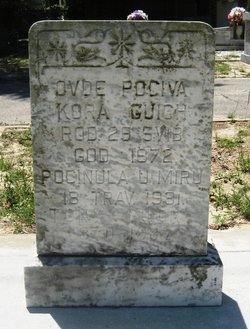
Mary Guich
Mary Guich (1894-1968), a native of Milna, Split-Dalmatia County, Croatia, married Peter J. Radich (1875-1954) in Harrison County, Mississippi on April 17, 1913. They were the parents of: Nicolena Radich (1914-2001) m. William Peter Strayham (1909-1956); Etta C. Radich (1916-1998); Nicholas Charles Radich (1918-1976); Andrew Tony Radich (1921-2004); Peter M. Radich (b. 1924) m. Emelda Joyce Diaz; Tony Radich (b. 1926); Mary Peggy Radich (1929-1955) m. Henry G. Byrd; Victoria Radich (1936-1936);and Stella Ann Radich (1939-1941).(Harrison Co., Mississippi Circuit Court MRB 25, p. 266 and 1930 Harrison Co., Mississippi 1930 Federal Census R11146, p. 23B, and ED 2)
Peter J. Radich (1875-1954) was born September 30, 1875 at Bobovisce, Brac, Split-Dalmatia County, Croatia the son of Nicholas Radich and ?. He came to Biloxi in November 1902 and lived at 212 Pine Street where he made his livelihood as a fisherman in Biloxi's seafood industry. Peter departed Europe from LeHavre, France and arrived at New York City aboard the SS Latonia on October 21, 1902.(Petition for Naturalization-US District Court-Southern Mississippi No. 240, filed July 24, 1920 and The Daily Herald, July 26, 1920, p. 3)
The Daily Herald, “Mrs. [Cora Vincich] Guich dies”, April 18, 1931.
The Daily Herald, “Nada Guich”, January 2, 1965.
The Daily Herald, “Lena Marinovich”, February 8, 1970.
The Daily Herald, "Nick C. Radich", March 17, 1976, p. 2.
The Sun Herald, "Nicolena Radich Strayham", September 5, 2001, p. A7.

Marko 'Mike' Halat (1880-1929) was born November 6, 1880 at Bobovisce, Brac, a Croatian isle off the Dalmatian Coast. On June 15, 1908 in the B.V.M. Catholic Church, Mike Halat married Frances Grassi (1888-1969), the daughter of Paul Grassi and Margaret Grassi. Miss Grassi was also a native of Brac, Croatia. Their children born at Biloxi, Mississippi were: Paul John Halat (1909-1977) m. Margaret Skrmetta (1913-2007); Anastatia J. Halat (1911-1991); Margaret J. Halat (1913-1994) m. Walter A. Kopszywa (1912-1987); Peter Paul Halat (1915-1968) m. Louella Mary Gary and Shirley Sandlin; Frances Halat (1917-1917); Frances Halat (1918-) m. James Joseph Freche (1907-1972); Josephine Halat (1921-1999); and Mike Joseph Halat (1926-2003) m. Gloria Theresa Viator Romero (1930-2010).
Marko 'Mike' A. Halat (1880-1929) settled at 118 Pine Street in Biloxi. He had arrived here circa 1904 and made his livelihood as a fisherman. In late August 1929, Mike Halat was working for Captain Steve Rodolfich (1887-1971) aboard the Arcadia, a power boat, in Lake Borgne, Louisiana. While attempting to tie an awning rope, it broke and he fell into the lake. All attempts to save Mike Halat were futile as he was a poor swimmer. His body was found near the Rigolets by Captain Vincent Kuluz (1898-1987), master of the Annie Long. The US Coast Guard had dispatched two vessels for his search and rescue and at least twenty-five fishing boats from Violet, St. Bernard Parish, Louisiana were on the scene. Tony M. Pitalo, a nephew, was aboard one of the USCG boats during the search for Halat's body. Mike Halat's ccorpse was brought to the O'Keefe Undertaking Service at Biloxi and buried on August 31, 1929 in the Biloxi Cemetery. Pallbearers for Mr. Halat's Catholic funeral service were: Vincent Rosetti; Steve Rodolfich; Mitchell Cavanaugh; Jerry Covich; and Steve T. Sekul. Nick Trebotich of Oakland, California, a cousin of Mrs. Halat, came to Biloxi for the funeral.(The Daily Herald, August 30, 1929, p. 1 and p. 8, August 31, 1929, p. 1, and September 4, 1929, p. 4)
Frances Grassi Halat (1887-1969) had come to Biloxi from Croatia circa 1905. She expired on August 17, 1969. Her corporal remains were interred in the Biloxi Cemetery.
Halat Children
Paul J. Halat
Paul 'Chilly Coon' John Halat (1908-1977) was born March 23, 1908. On June 9, 1935, he married Margaret 'Maudie' Skrmetta (1913-2007), the daughter of Lawrence [Lorenc] Skrmetta (1882-1972) and Jacobina Sekul, both Croatian immigrants. They were the parents of four children: Joyce Elaine Halat (b. 1939) m. Ronald Simon Franklin; Sandra Halat; Paul Lawrence Halat (b. 1944) m. in Los Angeles Co., California; and Michael Joseph Halat m. ? (Harison Co., Mississippi Circuit Court MRB 46, p. 124 and MRB 119, p. 473)
Paul J. Halat was the proprietor of the Biloxi Seafood Packing Company. He died on September 20, 1977. Maudie Skrmetta Halat lived until January 1, 2007.(The South Mississippi Sun, September 22, 1977, p. A4
Anastasia J. Halat
Anastasia J. Halat (1911-1991) was born February 6, 1911. She never married.
Margaret M. Halat
Margaret M. Halat (1913-1994) married Walter A. Kopsyzwa in Harrison County, Mississippi on August 11, 1947.(
Peter P. Halat
Peter Paul Halat (1915-1968) was born . He married Louella Mary Gary on February 17, 1939 and they settled at 806 Oak Street in Biloxi. Their children were: Michael 'Mickey' Anthony Halat (b. 1939) m. Carolyn Ann Rogers Sulzbach (b. 1945), a native of Fayette County, Alabama and the daughter of William L. Rogers and Pauline Thomason; and Peter P. Halat Jr. (b. 1942) m. Sandra A. Dees (b. 1944), of Ocean Springs, Mississippi and the daughter of Joseph Dees (1910-1946) and Dorothy Eglin Dees McKinnon (b. 1919).(

Peter P. Halat Jr.-Mayor of Biloxi from 1989-1993
Peter Paul Halat Jr. (b. 1942) was born at Biloxi, Mississippi on July 27, 1942. He attended Biloxi Senior High School and graduated with the Class of 1960. On August 10, 1963 in St. Alphonsus Catholic Church at Ocean Springs, Mississippi, he married Sanda Ann Dees (b. 1944), the daughter of Joseph P. Dees (1910-1946) and Dorothy 'Dot' Eglin Dees McKinnon (b. 1919). They were the parents of: Sean Stefan McKinnon Halat m. Michelle Ann Holomon and Lynetta Marie Dobbins.(Jackson Co., Mississippi Circuit Court MRB 103, p. 404 and MRB 105, p. 25)
Peter P. Halat Jr. attended the Jackson School of Law at Jackson, Mississippi and became a member of the Mississippi Bar Association in .
Biloxi Mayor
Peter P. Halat Jr. began his term as Biloxi's mayor in July 1989.
REFERENCES:
Edward Humes, Mississippi Mud, (Gallery Books: New York-1994), 434 pages.
The Biloxi-d’Iberville Press, “Peter Halat enters Mayoral race”, November 16, 1988.
The Daily Herald, “Mike Holot [sic], Biloxi fisherman, falls from boat, drown”, August 30, 1929.
The Daily Herald, “Search for Holat's body”, August 30, 1929.
The Daily Herald, “Body of fisherman brought to Biloxi”, August 31, 1929.
The Daily Herald, “Mike Halat buried”, September 4, 1929..
The South Mississippi Sun, “Paul John Halat”, September 22, 1977.
The Sun Herald, “Julia Halat Kopszywa”, June 15, 1994.
The Sun Herald, “Mike Joseph Halat”, October 19, 2003.
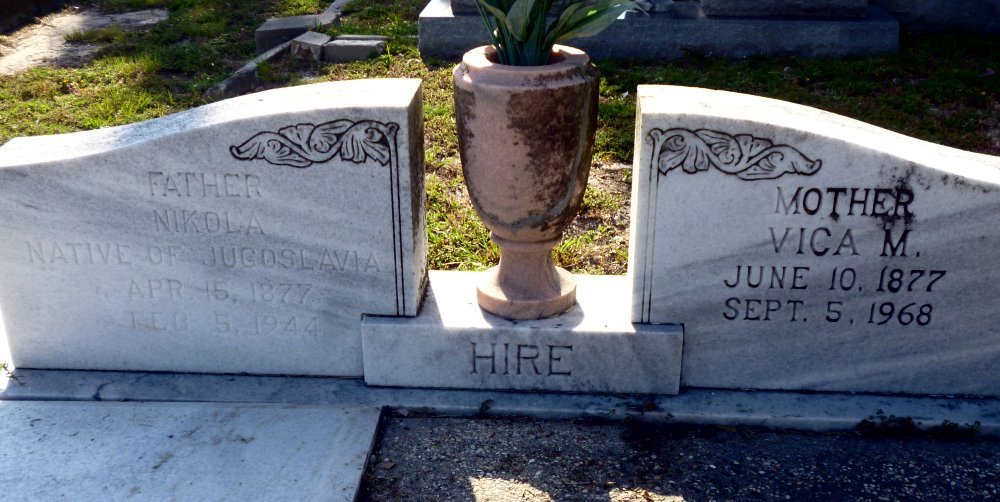
HIRE
Nikola ‘Nick’ Hire (1877-1944) was born in April 1877 at Bobovisce, Isle of Brac, Split-Dalmatia County, Croatia. He came to Biloxi, Mississippi circa 1902 to make his livelihood in the rapidly developing seafood industry.
On April 29, 1907 in Harrison County, Mississippi, Nick Hire married Vincenta ‘Vica’ Martinich (1877-1968), also a native of Bobovisce, Isle of Brac, Split-Dalmatia County, Croatia. She had been at Biloxi in 1905.[Harrison Co., Mississippi Circuit Court MRB 19, p. 78)
Their nuptials were celebrated in Harrison County, Mississippi on April 29, 1907. Vica and Nick Hire were the parents of six children: Margaret Hire (1909-1910); Paul Hire (1910-1988) m. Estelle Cook (1915-1998); Peter Hire (1912-1954) m. Grace Nobles (1913-1994); Catherine Hire (1914-1917); Edward M. Hire (1916-1996); Catherine Hire (1917-19); and Nicholas ‘Corky’ R. Hire Jr. (b. 1922) m.
CHILDREN
Margaret Hire
Margaret Hire (1908-1910) was born at Biloxi, Mississippi in 1908 and died on March 22, 1910.[Tombstone in Biloxi Cemetery]
Paul Hire
Paul Hire (1910-1988) was born at 1312 1st Street on ‘The Point’ in Biloxi, Mississippi on March 7, 1910. He had acquired the moniker "Heedy", which was derived from his Croatian ancestry. After serving in the US Navy, Paul Hire made his livelihood as a shrimper, owned a bar (Heedy's Bar) on the corner of Cedar Street and East Beach where St. Michaels Catholic Church is today, and worked as a pipe fitter at Ingalls Shipbuilding Corporation at Pascagoula, Mississippi. He became associated with Mrs. Brown of Biloxi and was employed by her Broadwater Construction Company. Mr. Hire also was the captain of a Chandeleur charter boat operating out of the Broadwater Marina.
On March 1, 1942, in Harrison County, Mississippi, Paul Hire married Estelle ‘Nuna’ Cook (1915-1998), a young school teacher, who had recently arrived on the Mississippi coast. Estelle was born at Philadelphia, Neshoba County, Mississippi. After graduation from Siena College (Memphis), she taught school in rural Neshoba County. Mrs. Hire later acquired a Master’s Degree in Education from the University of Southern Mississippi.(Harrison Co., Mississippi Circuit Court MRB 54, p. 442 and Estelle Cook Hire, )
Estelle Cook was drawn to Biloxi and the Coast by her Roman Catholic religion. She began her teaching career at Biloxi where she taught at Howard II elementary school on Point Cadet. Mrs. Hire also taught in the elementary school system at Ocean Springs. In 1983, while the principal of the Taconi School in Ocean Springs, she was selected as the outstanding administrator for that year. Mrs. Hire retired in 1984 after thirty-one years in that noble profession. (The Ocean Springs Record, April 7, 1983, p. 14)
Mrs. Hire had a master degree in education from the University of Southern Mississippi. She and Paul reared four children at Ocean Springs: Agnes Paula Hire (b. 1943), Jerome ‘Jerry’ Nicholas Hire (b.1944), Marsha Ann Hire m. Mr. Haynes (b. 1946), and Julia Claire Hire (b. 1950) m. Jerry Platt.
In over forty years in her lovely home, Mrs. Hire has maintained it in excellent and at near original conditions. She has added a carport and repaired the roof. The original wood shingles are still on the roof under the newer construction. The weatherboards are cypress.
Estelle Cook Hire
[from The Sun Herald, June 19, 1998, p. A-11]
OCEAN SPRINGS -- Mrs. Estelle ''Nuna'' Cook Hire, 82, of Ocean Springs, died Wednesday, June 17, 1998, in Mobile, Alabama. Mrs. Hire was born in Philadelphia, Mississippi, and had been a resident of the Coast since 1940. She was a member of St. Alphonsus Catholic Church in Ocean Springs and was active in the Legion of Mary. She was a retired teacher and principal in the Ocean Springs School District.
Estelle was preceded in death by her husband, Paul ''Heedy'' Hire. Survivors include three daughters, Paula Hire of Dallas, Texas, Marcia Hire Haynes of Atlanta, Ga., and Julia Hire Platt of Ocean Springs; a son, Jerome ''Jerry'' Hire of Hartford, Ala.; three sisters, Mary Gibson of Philadelphia, Miss., Jane Sabrio of New Orleans, La., and Polly Nyby of Port Townsend, Washington; two brothers, John Cook of Philadelphia, Mississippi, and Pat Cook of Montgomery, Alabama; four grandchildren, Angela Hire Grimm, Ashley Platt, Jacob Platt, and Joshua Platt, all of Ocean Springs; two great-grandchildren, Brennan Crimm and Lauren Crimm, both of Ocean Springs.
There will be a 1 p.m. Mass on Saturday, June 20, 1998, at St. Alphonsus Catholic Church in Ocean Springs, where friends may call from 11 a.m. until service time. Burial will be in Evergreen Cemetery in Ocean Springs. The Ocean Springs Chapel of Bradford-O'Keefe Funeral Homes is in charge of arrangements.
Peter Hire
Peter Hire (1912-1954), called Preacher, was born at Biloxi, Mississippi on February 6, 1912. He worked in the Biloxi seafood industry as a fisherman and oysterman and enlisted in the US Army in December 1940 and served during WW II. Peter married Grace Nobles (1913-1994) in Harrison County, Mississippi on January 28, 1950. [Harrison Co., Mississippi Circuit Court MRB 81, p. 37)
Peter Hire was a member of the Gulf Coast Fisherman’s Association and St. Michael’s Catholic Church. He expired at the Gulfport veterans’ Administration Hospital on March 26, 1954. Grace N. Hire lived to January 22, 1994. Both their burials were in the Biloxi Cemetery.(The Daily Herald, March 27, 1954, p. 6)
Catherine Hire
Catherine Hire (1914-1917) was born at Biloxi, Mississippi on February 26, 1914, She expired at Biloxi on November 17, 1917. [Tombstone in Biloxi Cemetery]
Edward M. Hire
Edward M. Hire (1916-1996), called Eddie, was born at Biloxi on September 21, 1916.
Nicholas R. Hire
Nicholas R. Hire, called “Corky’, married Loyce Smith in Harrison County, Mississippi on August 14, 1955.
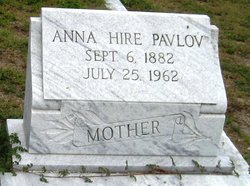
ANNA HIRE
Anna Hire (1882-1962) married Peter Pavlov (1882-1951) who was born March 16, 1882 to George Pavlov and Diana Sapurnich at Brac, Split-Dalmatia County, Croatia. Peter came to America in 1905. He embarked from Le Havre, France on the La Savoie on December 10, 1905 and arrived at New York City on December 17, 1905. Peter declared his intention to become an American citizen at Biloxi, Mississippi on December 6, 1917. He was naturalized at Biloxi on February 21, 1921 receiving Certificate of Naturalization No. 1511976.[Declaration of Intention No. 346 and Petition for Naturalization No. 239-US District Court-Southern Division of Mississippi]
REFERENCES:
The Daily Herald, “Nick Hire buried”, February 7, 1944.
The Daily Herald, “Peter Hire dies”, March 27, 1954.
The Daily Herald, “Mrs. Anna Pavlov”, July 26, 1962.
The Daily Herald, “Mrs Vica M. Hire”, September 5, 1968.
The Ocean Springs Record, “Mrs. Estelle Hire selected outstanding administrator”, April 7, 1983.
The Ocean Springs Record, “Paul Hire”, October 13, 1983.
The Sun Herald, “Paul ‘Heedy’ Hire”, October 10, 1988.
The Sun Herald, “Eddie M. Hire”, May 6, 1996.
The Sun Herald, “Estelle Cook Hire”, June 19, 1998.
The Sun Herald, “Mrs. Alice Davidson Hire”, June 19, 2004.
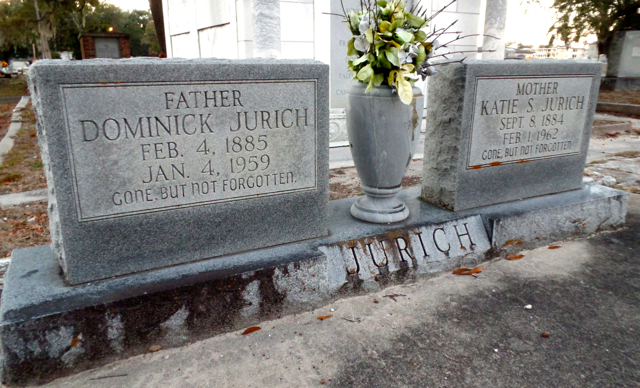

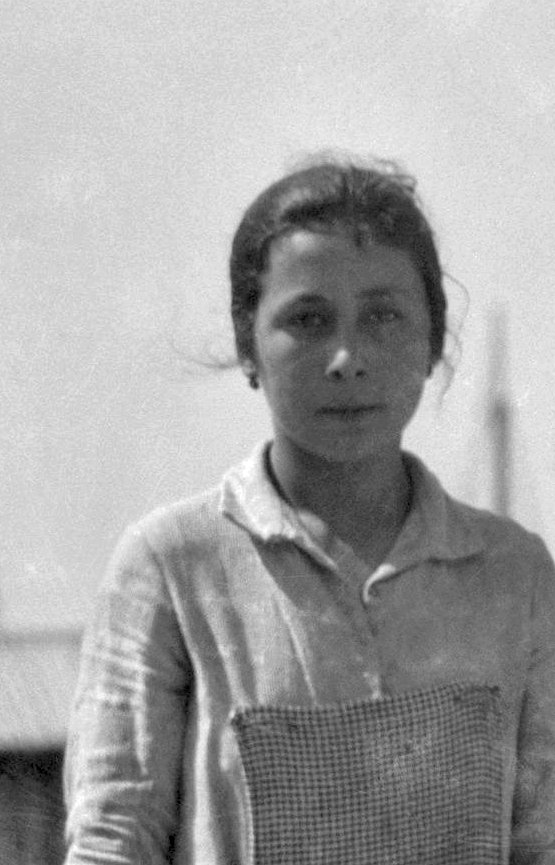
Marie Jurich [Baricev]-[Courtesy of Jacobina Tabb]
Marie [Maritza, Mary, and May] Jurich (1911-1997) was born at Brac, Split-Dalmatia County, Croatia on November 6, 1911. On June 22, 1932 in Harrison County, Mississippi, she married Anthony M. Baricev (1908-1982), the son of Peter [Petar] M. Baricev (1880-1951), born on Molat, Croatia and Theresa [Tereza] Buyasich (1880-1957), also a native of Molat. They were the parents of Jomarie Baricev (1944-1976) m. Victor Suzanno Soares, the son of Armindo 'Herman' Soares (1908-1994) and Judith Suzzano (1917-2006) on August 23, 1964; Catherine Baricev Fiorentini of San Diego, California; and Anthony 'Tony' D. Baricev.(Harrison Co., Mississippi Circuit Court MRB 43, p. 612 and Bk. 127, p. 376)
Marie Jurich Baricev (1884-1962)died at Hattiesburg, Mississippi, Mississippi on August 4, 1997. Jomarie Baricev Soares had preceded her in death passing on December 23, 1976. Anthony M. Baricev died on May 19, 1982. Their corporal remains were interred in the Southern Memorial Park cemetery, also at Biloxi, Mississippi.
 and Marie V. (1917-2000)_0.jpg)
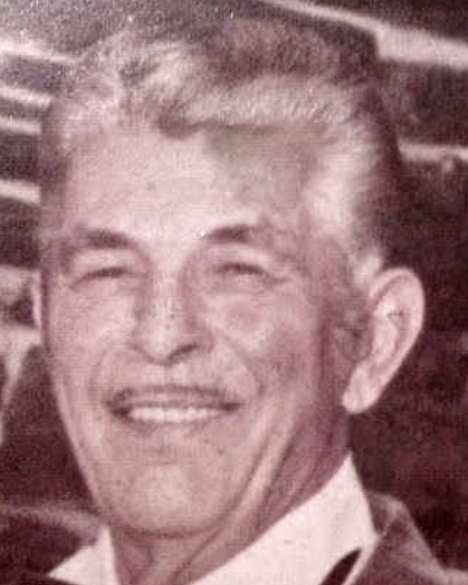
*SSDI indicates his birth date as May 29, 1913.
Marie V. Barhonovich Jurich (1917-2000), age 83 years, of Biloxi, passed away peacefully on Friday, February 25, 2000. Mrs. Jurich was born in Biloxi on January 13, 1917. She was a waitress in Biloxi all her life, with 35 years at Rosetti's PoBoys in Biloxi. Her retirement was followed by many proud hours as a volunteer at Biloxi Regional Medical Center. She was a member of St. Michaels Catholic Church, The Slavonian Ladies Auxiliary and St. Michaels Altar Society. Her greatest joy in life was her family. She was preceded in death by her husband, Peter "Mutt" Jurich, Sr.; her parents, Frank and Mildred Barhonovich; a sister, Antonia Barhonovich; and three brothers, Anthony Barhonovich, John Barhonovich and Peter Barhonovich. Survivors include three daughters, Betty Meyers and her husband, Dennis; Marie Gombos and her husband, Al; and Toni Briscoe and her husband, Mendy; a son, Peter M. Jurich Jr., and his wife, Kathy; a brother, Frank J. Barhonovich; and seven grandchildren, Denise Cruthirds, Stacey Meyers, Michael Meyers, Dennis Meyers Jr., Angela Gombos, Aerin Gombos and Peter Jurich III. A service was held at St. Michaels Catholic Church with burial will be in Biloxi Cemetery. The Howard Avenue Chapel of Bradford-O'Keefe Funeral Homes in Biloxi was in charge of arrangements.(The Sun Herald, February 27, 2000, p. A-7)
George Nicholas "Zora" Jurich (1928-1994), age 65 years, of Biloxi, died Wednesday, June 15, 1994, in Biloxi, Mississippi. Mr. Jurich was a native and lifelong resident of Biloxi. He was handicapped from birth with deafness. Zora was a member of St. Michael's Catholic Church at Biloxi. Zora Jurich was preceded in death by his parents, Dominic Jurich (1885-1959) and Catherine Sekul Jurich (1884-1962); and three brothers, Peter Jurich, Joseph M. Jurich (1918-1967), and John P. Jurich (1913-1981). He was survived by Mary 'Monica' Baricev (1911-1997). Bradford-O'Keefe Funeral Home of Biloxi directed the funeral of Mr. Jurich. Following services at St. Michael's Catholic Church burial followed at the Biloxi Cemetery.(The Sun Herald, June 17, 1994, p. A-2)

Luka Kuljis (1886-1965) was born in the village of Milna, on the island of Brac, Split-Dalmatia County, Croatia on August 11, 1886. He married Tadica Pitalo (1883-1978), a native of Bobovisce, Brac, Split-Dalmatia County, Croatia. She was the daughter of Stephen Pitalo and Mandelina ? . Children: Joseph Kuljis (1908-1988) m. Georgia Foster (1908-1989); Stephen Joseph Kuljis (1911-1960) m. Ruth Moniot (19-1962); Marguerite Kuljis (1913-1986) m. Ojo J. Ohr (1903-1991); Peter T. Kuljis (1916-1983) m. ; Madaline [Mandelina] Kuljis (1921-1993) m. John Bolton Richards (1918-1986); and Alexander 'Alex' John Kuljis (1924-1979).
Dr. Joseph Kuljis
Dr. Joseph Kuljis (1908-1988) was born at Biloxi on 1908. He married Georgia Ruth Foster (1908-1989), a native of Union, South Carolina. Graduate of Tulane University. Died March 17, 1988 in the Baptist Hospital in New Orleans. Survived by spouse; a son, Joseph L. Kuljis; and Madaline Kuljis Richards, his sister. Burial Southern Memorial Park at Biloxi, Mississippi.(The Times-Picayune, March 19, 1988, p. B-7)

Stephen J. Kuljis
Stephen 'Steve' Joseph Kuljis (1911-1960) was born at Biloxi, Mississippi on January 21, 1911. He married Ruth Moniot (1920-1962), the daughter of Leon Moniot and Martha Moniot, in Harrison County, Mississippi on January 8, 1942. They were the parents of five children: Georgia Kuljis (1943-2010) m. George W. Lawrence; Ruth Kuljis; Hope Alexis Kuljis m. George Grego Garbin; Jacqueline Rita Kuljis (1947-1996) m. Armond J. Boudreaux and Anthony Corso; Stephen Jospeh Kuljis Jr.; and Peter deMoniot Kuljis (1960-2016) m. Vickie L. Baker and Kathy Buck.(Harrison Co., Mississippi Circuit Court MRB 54, p. 30)
In July 1941, Steve Kuljis acquired the grocery store of Charles Schuman on east Howard Avenue near Lameuse Street.(The Daily Herald, July 10, 1941, p. 3)
During WW II on March 11, 1942, Steve Kuljis enlisted in the Naval Reserve and was called to actve duty in May 1942. In early November 1942, he was in combat in the North African campaign and received a citation for bravery from his commanding officer. The citation read as follows: "Accomplishment of assignement and outstanding bravery displayed at risk his own life, under enemy fire, during initial assault and capture of Arzew [Oran] French Algiers, North Adfrica, November 8-11, 1942; operation successfully carried out in cooperation with the United States Army and British Royal Navy."(The Daily Herald, March 29, 1943, p. 8)
Children
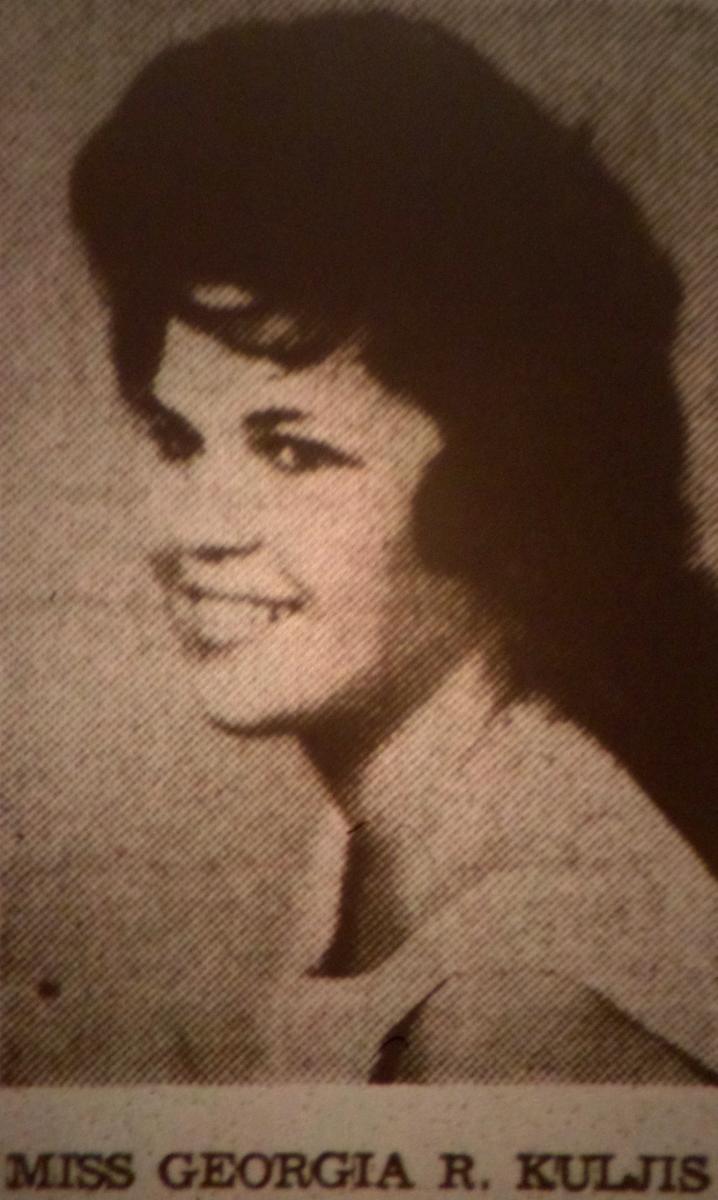
Georgia R. Kuljis Lawrence (1943-2010)-On August 10, 2010, after fulfilling God's purpose for her life on earth, the angels were sent to bring Georgia R. Lawrence home to her eternal reward. She was 67 years of age. Georgia was born in Biloxi where she remained a lifelong resident. She was of the Catholic Faith and a devoted member of St. Michael Catholic Church where she faithfully served as a Eucharistic Minister. Georgia graduated from Sacred Heart Girls High School in 1961. She was a member of the Slavonian Ladies Auxiliary. She is remembered by many for her dedication to the Biloxi Girls Softball League, her ten years as cafeteria manager at Mercy Cross High School, and her commitment to catholic education. In 1998 she was awarded "Mother of the Year" by the Biloxi Lions Club. She spent her entire life offering selfless unconditional love to her family, friends and everyone she encountered. Through her immense love and support for her grandchildren the legacy of "Ria" will forever live on. She is preceded in death by her parents, Stephen "Scupps", Sr. and Ruth Moniot Kuljis; sister, Jacqueline Corso; father-in-law, Anthony Lawrence, Sr. and mother-in-law, Teresa Calamari Lawrence. Georgia is survived by her loving and devoted husband of 48 years, George W. Lawrence; three daughters, Gina (Dannie) Skrmetta, Gwyn (Boots) Diaz, Gela (Dennis) Meins; five grandchildren, James and Danielle Skrmetta, Josh, Jacob and Justin Diaz; sister, Hope Garbin; two brothers, Stephen Kuljis, Jr., Peter D. Kuljis and numerous nieces, nephews and other relatives.mmA Mass of Christian burial will be on Saturday, August 14, 2010 at 12:00 p.m. at St. Michael Catholic Church. Reciting of the Rosary will be at 11:30 a.m. Interment will be in Biloxi City Cemetery. A celebration of Georgia's life will follow at the Slavonian Lodge, 159 Maple St. Bradford-O'Keefe Funeral Home, Howard Avenue, Biloxi is in charge of arrangements.(The Sun Herald, August 13, 2010)
Jacqueline Rita Kuljis (1947-1996) was born at Biloxi, Mississippi on June 14, 1947. She died on November 25, 1996.

Peter DeMoniot Kuljis (1960-2016), age 60 years, of Biloxi, passed away on Monday, February 29, 2016. He was born on April 17, 1955 and graduated from Biloxi High School in 1973. Peter had a deep love for his family and was extremely proud of his Croatian and French heritage. He was a member of The Slavonian Lodge where he served on the Board of Trustees. He was also a member of The French Club. Peter's heritage instilled in him an immense love of the water, boats and being a fisherman. He also enjoyed his mornings having breakfast with his Slavonian Lodge brothers and playing bourre (booray) with them. Peter was the owner of Cable Unlimited and he installed and serviced security systems. He was a jack-of-all-trades, excelling in mechanical work, carpentry, and art, which he used to paint and build props and stages for high school proms and carnival balls. Many people also remember him as a mechanic at Lyon's Chevron gas station in Biloxi. Peter had a big heart and used all of his many talents to help others when in need. Peter is preceded in death by his parents, Stephen "Skups" Kuljis, Sr. and Ruth Moniot Kuljis; sisters Georgia Lawrence & Jacqueline Corso. Peter is survived by his daughter Meagan Kuljis and granddaughter Talyn Pizzetta; sister Hope Garbin and brother Steve(Diane) Kuljis; nieces, nephews and other relatives. A celebration of Peter's life will be held Sunday, March 13, 2016 at noon at The Slavonian Lodge, 159 Maple Street. All family and friends are welcome to attend. Bradford-O'Keefe Funeral Home is in charge of arrangements.(The Sun Herald, March 6, 2016)
Marguerite Kuljis
Marguerite Kuljis (1913-1986) was born April 22, 1913 at Biloxi. She married Ojo J. Ohr (1903-1991). Marguerite died on July 24, 1986 at Ocean Springs, Mississippi. Her corporal remians were interred in the Biloxi Cemetery.
Peter T. Kuljis
Peter Tony Kuljis (1916-1983) was born March 10, 1916 at Biloxi, Mississippi. He married Verna Mae Cannette (1916-1988), the daughter of Edward James Cannette (1893-1950) and Estella Diaz Cannette (1896-1980), in Harrison County, Mississippi on September 8, 1946.(Harrison Co., Mississippi Circuit Court MRB 51, p. 310)
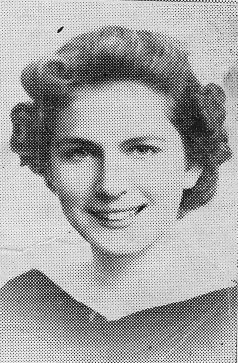
Madeline Kuljis
Madeline Kuljis (1921-1993) was born at Biloxi, Mississippi on April 24, 1921. She was named Miss Biloxi at the Buena Vista Hotel in early February 1938.[The Daily Herald, February 5, 1938, p. 1]
Madeline married John Bolton Richards (1918-1986) and they were the parents of Sherry Ann Irene Richards. Sherry Ann married Paul Louis Babuchna Jr. in Harrison County, Mississippi on June 30, 1968.
Alexander J. Kuljis
JOSEPH KULJIS
Joseph Kuljis (1888-1957)
SAM KULJIS
Sam Kuljis (1889-1961) was born Siman Kuljis on August 9, 1889 at Milna, Brac, County Split-Dalmatia . He arrived at Boston, Massachusetts on May 21, 1921 aboard the SS Argentina, which had earlier embarked from Trieste, Austria for America. Mr. Kuljis declared his intent to become an American citizen in the Southern Federal District Court at Biloxi, Mississippi in May 1925. At this time, he was domiciled at 314 Pine Street in Biloxi. Sam Kuljis indicated that he was 5 feet 8 ½ inches tall and weighed 178 pounds.(Declaration of Intent No. 804-Southern District Federal Court of Mississippi, May 19, 1925)
Circa 1925, Sam Kuljis married Mary Josephine Keresich (1906-1996), a native of Biloxi. In 1940, the Sam Kuljis family lived at 126 Myrtle Street on Biloxi’s Point Cadet. Sam and Mary J. Kuljis were both employed in the local seafood industry. He captained a fishing vessel and she labored in a local factory shucking oysters and picking shrimp. At this time their three daughters had been born and lived at home: Margaret Rita Kuljis (b. 1926) m. Charles Harry McMahon in October 1942; Vincentia ‘Vee’ Kuljis (1928-2012) m. Murphy J. Trahan Sr. (1926-1980) in October 1948; and Teresa Kuljis (b. 1931) m. Bernard Ward in June 1949.(1940 Harrison Co., Mississippi T627_2024, p. 9A, ED 24-5)
Sam Kuljis expired at Biloxi, Mississippi on October 25, 1961. He was followed in death by his wife who passed on May 10, 1996. Their corporal remains were interred in Southern Memorial Park.(The Daily Herald, October 25, 1961, p. 2)
ANTONIA KULJIS
Antonia Kuljis (1890-1960) was born June 13, 1890 at Milna, Brac, Croatia. She married John Skrnich (1887-1968), also a native of Milna, Brac. Children: Clara Ann Skrnich (1912-2003) m. John Frank Cosmich (1909-2009); Margaret Skrnich (1913-1935) m. Vincent Rosett; Thomas Skrnich (1914-2001) m. Lillian Broux; Joseph ‘Chibby’ Skrnich (1915-2009); John Skrnich Jr. (1917-2007) m. Flora Gazzo (1924-2001), the daughter of Andrew Gazzo and Viola Daniel; Michael Skrnich (1919-1973) m. Isabell Leleaux (1922-1996); Antonia Skrnich (1922-1923); Samuel J. Skrnich (1924-2001) m. Marie Grace Sanzari; Frances Dominica Skrnich (1924-2010) m. Lawrence W. Mason (1918-2004); Lucretia Skrnich m. Neville J. Broussard (1920-1999); and Dolores Rita Skrnich m. George A. Sonnier.
Antonia Kuljis Skrnich passed on September 18, 1960 at 1442 East Beach in Biloxi. She was survived by her spouse; five sons; and four daughters; three brothers, Luka Kuljis, Sam Kuljis and Peter Kuljis; two sisters, Madica Kuljis Buzolich and Yubica Kuljis Banicich [sic] in Yugoslavia [Croatia]; 26 grandchildren; and one great-grandchild. The Reverend Herbert Mullen officiated at her funeral in St. Michael's Catholic Church follwed by burial in the Biloxi Cemetery. services under the auspices of Bradford-O'Keefe Funeral Home.(The Daily Herald, September 19, 1960, p. 2)
PETER KULJIS
In July 1948 in Harrison County, Mississippi, Peter Kuljis (1902-1966) married Dina Mary Mladinich (1914-2006), the widow of John Joseph Labetich (1909-1944). John Joseph Labetich (1909-1944) had died at the Presidio, US Army Camp, in San Francisco, California on February 20, 1944. He had married Dina Mary Mladinich (1914-2006) in Harrison County, Mississippi on September 12, 1934. They had one daughter, Frances Labetich who married Gus C. Cavalier Jr. (1933-2005). John J. Labetich's corporal remains were interred in the Biloxi Cemetery.(The Daily Herald, February 21, 1944, p. 7 and March 1, 1944, p. 8 and The Sun Herald, October 7, 2006)
REFERENCES:
The Daily Herald, “Dr. Kuljis in Greenville”, August 12, 1935.
The Daily Herald, “Miss Kuljis new Miss Biloxi”, February 5, 1938.
The Daily Herald,“Grocery changes [ownership]”, July 10, 1941, p. 3.
The Daily Herald, “John L. (sic) Labetich dies in Army camp”, February 21, 1944.
The Daily Herald, “Steve Kuljis dies at Biloxi”, August 27, 1960.
The Daily Herald, “Mrs. John Skrnich”, September 19, 1960.
The Daily Herald, “Sam Kuljis", October 25, 1961, p. 2.
The Daily Herald, “Mrs. Ruth Kuljis”, March 21, 1962.
The Daily Herald, “Former Biloxi Shrimp Ruler taken by death”, March 2, 1977.
The Daily Herald, “Mrs. Tadica Pitalo Kuljis”, February 13, 1978.
The Daily Herald, “”,
The Sun Herald, “Peter T. Kuljis”,
The Sun Herald, “Verna Mae Kuljis”,
The Sun Herald, “Georgia Foster Kuljis”, June 5, 1989.
The Sun Herald, “Madeline Kuljis Richards”, Febriuary 16, 1993.
The Sun Herald, “Mary J. Kuljis”, May 12, 1996.
The Sun Herald, “Dina Mary Mladinich Labetich Kuljis”, October 7, 2006.
The Sun Herald, “Vincentia Trahan”, August 23, 2012.
_______________________________________________________________________________________________
MARICICH
Luka John Maricich (1893-1963) was born May 3, 1893 at Supetar on the isle of Brac, Split-Dalmatia County, Croatia. He came to Biloxi, Mississippi in the fall of 1922 from Baltimore, Maryland where he had landed on June 14, 1922 disembarking from the SS Helenia which had sailed from Trieste, Austria, now Italy. Luka made his way from the East Coast and soon joined the large Slavic community at Biloxi’s Point Cadet. His spouse Danica Pleticolcich Maricich (1894-1966), and Marie Maricich, their infant daughter, came from Brac in 1923 and joined him at 1426 First Street.(Declaration of Intention No. 740, Federal Court-Southern District-Gulfport, Mississippi, December 19, 1922 and The Daily Herald, December 20, 1922, p. 3)
In 1930, the Maricich family lived at 218 Cedar Street on Point Cadet where Luka J. Maricich made his livelihood as a fisherman. He and Danica were the parents of at least six children: Marie Maricich (1919-1956) m. Carl J. Hebden (1923-1980); Luke John Maricich Jr. (1925-1988) m. Theresa Marie Rutledge in May 1947, m. Sarah R. Gavin in August 1955, m. Mara Lena Homlish in October 1965; Elena Agnes Maricich m. Anthony S. Hannigan Jr. (1918-2009) in December 1941; Katherine Maricich (1930-1993) m. Mr. Arceneaux and Carol Biggs (1927-2010); Anthony J. Maricich (1931-1984) m. Myrtle Ann Slater in September 1957; and Jerry Peter Maricich (1932-1989) m. Dolores R. Masse in September 1952 and Deborah Mae Daily in February 1965.
Luka John Maricich died at Biloxi on July 15, 1963. Danica expired on December 8, 1966. Their corporal remains were interred in the Biloxi Cemetery.
Children
Marie Maricich
Marie Maricich (1919-1956) was born at Brac, Split-Dalmatia County, Croatia on September 30, 1919. She came to Biloxi in 1923 with her mother, Danica Pleticolcich Maricich (1894-1966) from the Dalmatian island of Brac. Marie married Carl J. Hebden (1923-1980) in Harrison County, Mississippi on January 31, 1942.(Harrison Co., Mississippi Circuit Court MRB 54, p. 236)
Marie M. Hebden died at Homestead, Florida on December 31, 1956 from injuries that she received in an automobile accident at Homestead on December 6, 1956. Mrs. Hebden was survived by her husband, M. Sgt. Carl J. Hebden; two children, Janice Hebden and Carl J. Hebden Jr.; her parents, Mr. and Mrs. Luka Maricich; three brothers, Jerry Maricich; Anthony Maricich; and Luka Maricich Jr; two sisters, Katie Stanfield and Elena Tamer, all of Biloxi. The body will be brought to Biloxi for burial. (The Daily Herald, December 31, 1956, p. 2)
Funeral services for Marie M. Hebden were held from the Bradford-O'Keefe Funeral Home at Biloxi on January 3, 1957. Internment was in the Biloxi Cemetery following a Requiem Mass at Nativity BVM Catholic Church.(The Daily Herald, January 4, 1957, p. 2)
Luke J. Maricich Jr.
Luke John Maricich Jr. (1925-1988) was born at Biloxi, Mississippi on March 12, 1925. He appears to have married four times in Harrison County, Mississippi. Theresa Marie Rutledge on May 8, 1947; Sarah R. Gavin on August 30, 1955; Mara Lena Homlish in October 4, 1965; and Laura Poole on October 5, 1968.[Harrison Co., Mississippi Circuit Court MRB 74, p. 387; MRB 102, p. 444; MRB 130, p. 339; and MRb 139, p. 532]
Mr. Maricich was a lifelong resident of the Coast and made his livelihood as a boat captain in the oil and gas industry. He was a Catholic. Luke J. Maricich Jr. died June 26, 1988 at Biloxi, Mississippi. He was survived by four daughters: Cheryl Overton of Wichita, Kansas; Rosalie Maricich of Metairie, Louisiana; Debbie Maricich of Benton, Florida, and Angel Maricich of Bay St. Louis, Mississippi; three sons, Larry Maricich and Luke John Maricich II, both of Biloxi, and Dennis Maricih of Ocean Springs; a sister, Katheirne Biggs of Biloxi; and a brother, Jerry Maricich of Slidell, Louisiana; and seven grandchildre. Luke's funeral was dirrected by Bradford-O'Keefe Funeral Home of Biloxi with internment at the Biloxi National Cemetery.(The Sun Herald, June 28, 1988, p. A-3)
Elena A. Maricich
Elena Agnes Maricich (1927-) married Anthony Seth Hannagan Jr. (1918-2009), a native of Illinois, in Harrison County, Mississippi on December 31, 1941.(Harrison Co., Mississippi Circuit Court MRB 54, p. 24)
Anthony S. Hannagan Jr. expired on July 9, 2009 in Park Forest, Illinois. His corporal remains were interred in the Fort Sills Veterans Cemetery at Oklahoma.(The Southtown Star [Chicago], Anthony S. Hannagan II, July 26, 2009)
Katherine Maricich
Katherine Maricich Arceneaux Biggs (1930-1993), age 63 years, of Violet, Louisiana, died Saturday, May 29, 1993, in Chalmette, Louisiana. Mrs. Biggs was a longtime resident of Biloxi, a Catholic and homemaker. Survivors include her spouse, Carol Biggs (1927-2010) of D'Iberville, Mississippi; a daughter, Patricia Menefee of Ocean Springs; son, Peter Stanfield of Slidell, Louisiana and Tony Arceneaux of Ocean Springs; and four grandchildren. Bradford-O'Keefe Funeral Home of Biloxi had charge of Mrs. Biggs' funeral service with graveside services at Southern Memorial Park.(The Sun Herald, June 1, 1993, p. A-2)
Anthony J. Maricich
Anthony 'Tony' John Maricich (1931-1984) was born at Biloxi, Mississippi on March 15, 1931. He married Myrtle Ann Slater in Harrison County, Mississippi on September 8, 1957. Tony and Myrtle Ann Maricich left Biloxi in 1958 for Pascagoula, Mississippi where they settled at 2021 Margie Moore Avenue. Tony was employed with the Ingalls Shipbuilding Corporation. He later was the proprietor of the S & M Cabinet Shop at Pascagoula.(Harrison Co., Mississippi Circuit Court MRB 110, p. 97)
Mr. Marich expired at Pascagoula, Mississippi on April 2, 1984. He was survivied by his spouse; two sons, Eddie Slater of Indianola and Paul Slater of Pascagoula; four daughters, Tina Key of Pascagoula; Pat Hobbs of Jackson; June Flores of Huntsville, Alabama; and Jean Armstrong of Greenville; two brothers, Jerry Maricich (1932-2989) and Luke Maricich and a sister, Katie Biggs (1930-1993), all of Biloxi; 23 grandchildren; and 11 great-grandchildren.(The Daily Herald, April 13, 1984, p. A-2)
Jerry P. Maricich
Jerry Peter "Runt" Maricich (1932-1989) was born at Biloxi, Mississippi. He married Dolores R. Masse in Harrison County, Mississippi on June 16, 1952 and Deborah Mae Daily on February 22, 1965. Jerry made his livelihood as a boat captain. He died on December 9, 1989 in Slidell, Louisiana while a resident of Pearl River, Louisiana. He had lived in Pearl River since 1984. Mr. Maricich was survived by Jerry Alan Maricich, a son; two daughters, Marie Maricich of Slidell, and Diane Lynn Marich Sirey of Pearl River; a sister, Katie Biggs of North Biloxi; and five grandchildren. His internment was in the Crowe Cemetery at Lacombe, Louisiana.(The Sun Herald, December 12, 1989, p. C-2 and Harrison Co., Mississippi Circuit Court MRB Bk. 91, p. 112 and 128, p. 558)
REFERENCES:
The Daily Herald,“Isle Brach [sic] man wants to be an American”, December 20, 1922.
The Daily Herald, “Biloxian dies following wreck in Homestead, Fla.”, December 31, 1956.
The Daily Herald, “Mrs. Hebden Rites”, January 4, 1957.
The Daily Herald, “Luka Maricich”, July 16, 1963.
The Daily Herald, "Mrs. Danica Maricich”, December 9, 1966.
The Daily Herald, “Anthony Maricich”, April 13, 1984.
The Oklahoman [Oklahoma City], "Anthony S. Hannagan", July 12, 2009, p. A-18.
The Southtown Star [Chicago], "Anthony S. Hannagan II", July 26, 2009.
The Sun Herald, 'Luke Maricich Jr.', June 28, 1988.
The Sun Herald, “Jerry 'Runt' Maricich”, December 12, 1989.
The Sun Herald, “Katherine Maricich Biggs”, June 1, 1993.
________________________________________________________________________________________________
MARINOVICH
Mateo 'Mike' Marinovich
Mateo 'Mike' Marinovich (1889-1929) was born March 14, 1887 at Milna, Brac. He left Trieste and arrived at the port of New York in November 1905 and declared his name as Kuznia Marinovich. He had married Margurite T. Misko (1886-1943) in Croatia. They settled at 1323 First Street and Mike made his livelihood in the seafood industry. Their children were born in Biloxi: Steve Joseph Marinovich (1917-1999); Mary Helena Marinovich (1920-2011) m. Willard A. Newman (1917-1990); and Rita Marinovich (1925-2005) m. Clay Frank Baudry (1924-1992).
Children
Steve J. Marinovich
Steve Joseph Marinovich (1917-1999) was born July 1, 1917 to Mike Marinovich and Marguerite . He married Marie Lovlyn Arceneaux (1922-2001), the daughter of Adam Arceneaux and . She was a native of Abbeville, Louisiana. Children: Steve Michael Marinovich (1941-1942); Mary Jo Marinovich m. Bissett; and Margaret Ann Marinovich m. Breeland.
Steve Marinovich expired at
Marinovich Trawl Company
Steve J. Marinovich began his trawl making service about 1946. He manufactured and exported netting and trawls from his Oak Street headquarters. In April 1963, Steve was appointed by the Biloxi City Council to the Boiloxi Port Commission replacing Albert Duckett.(The Daily Herald, April 25, 1963, p. 1)
SAM MARINOVICH
Sam Marinovich (1881-1956) was born December 25, 1881 to Joseph Marinovich at Zdrelo, Serbia. He married Vencentia Sekul Keresich (1884-1974), the widow of Joseph Keresich (d. March 1906) in Harrison County, Mississippi on July 13, 1908. Children: Annie Marinovich m. John Skrmetta and Fountain; Alena Marinovich (1911-1970); Stephanie Marinovich (1913-2001) m. Sidney Fountain; Joseph Marinovich; Frances Marinovich (1916-1918); Antoney Marinovich (1919-1919); Jake Marco Marinovich (1921-2003) m. Octavia Rousseau and Helen Delores Anderson; and Samuel Marinovich (1923-1934). Sam's step-daughter, Mary Josephine Keresich (1906-1996) married Sam Kuljis (1889-1961).
REFERENCES"
The Daily Herald, “Marinovich child dies”, June 10, 1942.
MIHOJEVICH
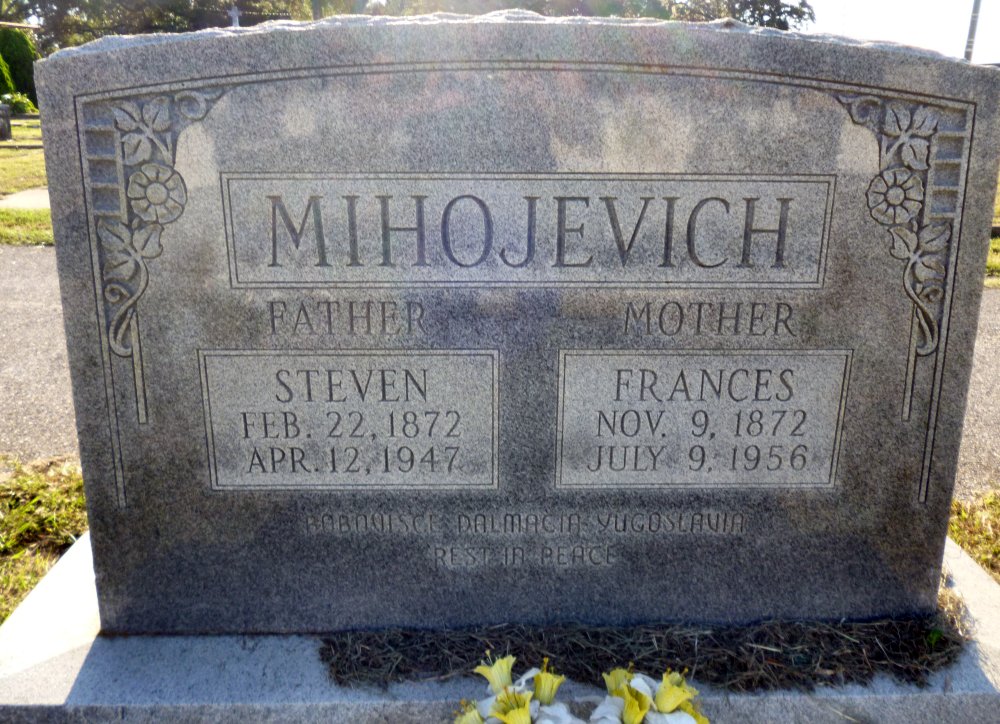
Steven Mihojevich and Frances Martinich
[image made Biloxi Cemetery-August 2012]
Steven [Stip] Mihojevich (1872-1947) was born at Boboviscia, Brac on February 22, 1872, the son of Anthony 'Tony' Mihojevich and Mary Doukstoni. Stip Mihojevich left Le Havre, France on the SS Britannia and arrived at New York City on February 14, 1901. He settled at 219 Cedar Street.(Southern District Mississippi-Declaration of Intention for Citizenship, No. 280)
Stip Mihojevich married Frances 'Frankie' Martinich (1872-1956) in Bobovisca, Brac. Her father was Matthew Martinich and mother, Frances Trebotich. She came to Biloxi in 1905 with Anthony Mihojevich (1902-1982), their son. The Steve Mihojevich family later resided at 220 Myrtle Street on Point Cadet where he made his livelohood as a fisherman. There children were: Mary Mihojevich (1899-1918) m. Anthony Filipich (1897-1969); Anthony Mihejovich (1902-1982) m. Angelina Russo (1907-2008); Peter Mehojevich (1906-1997); Katrina [Katie] Mehojevich (1907-1999) m. Frank Kovacevich (1899-1971); Joseph Mehovecich (1909-1991) m. Marguerite Fountain; Frances Mihovecich (1913-2002) m. Mike Sekul (1911-1988).
Mrs. Frances Mihojevich expired at Biloxi on July 9, 1956. Steve Mihojevich died on April 12, 1947.(Bradford-O’Keefe Burial Book 38-A, p. 111)
Steve Mihojevich (1872-1947), a 1903 Dalmatian immigrant and the son of Tony Mihojevich and Mary Doukstoni, married Frances Martinich (1872-1956), also a native of Dalmatia. Her father was Matthew Martijich and mother, Frances Trebotich. She came to Biloxi circa 1904. Their children were: Antonio 'Tony' Mihojevich (1902-1982); Peter Mihojevich (1907); Katrina Mihojevich (1908) m. Frank Kovacevich; Joseph Mihojevich (1909-1991) m. Marguerite Fountain; and Frances Mihojevich (1913) m. Mike Sekul. The Steve Mihojevich family resided at 220 Myrtle Street on Point Cadet. Mrs. Frances Mihojevich expired at Biloxi on July 9, 1956. Steve died on April 12, 1947.(Bradford-O’Keefe Burial Book 38-A, p. 111 and 1920 Harrison County, Mississippi Federal Census T625_876, p. 30B, ED 39)
CHILDREN
Antonio Mihojevich
Angelina 'Angie' Russo (1907-2008), native of NOLA and the daughter of Salvador Russo and Olivia Fallo married Tony Mihojevich (1902-1982) on April 27, 1927 at Nativity BVM in Biloxi, Mississippi. Children: Claudette Frances Mihojevich m. William Laughlin Quigley Quigley and Stephanie Mihojevich m. Don Francis Pizzetta (1935-1987). Employed at the Gulf Central Seafood factory. Angie R. Mihojevich expired at her home on 220 Myrtle Street in Biloxi on January 23, 2008. Burial Southern Memorial Park cemetery at Biloxi, Mississippi.(The Sun Herald, January 24, 2008, p. A6)
Children

Claudette F. Mihojevich
Claudette Frances Mihojevich was valedictorian of Class of 1948 at Sacred Heart Academy. Terese Peresich was salutatorian. Claudette garduated from Loyola University [NOLA] with a degree in Medical Technology. Before her marriage to William Laughlin Quigley of Biloxi in Harrison County, Mississippi on February 17, 1952, Claudette worked as a laboratory technician at the Biloxi VA Hospital. Thier first child, Deborah Ann Quigley was born in October 1953. She married Paul Franklin Bates in December 1973.(The Daily Herald, May 25, 1948, p. 2, February 19, 1952, p. 14; and Ocotber 30, 1953, p. 18)
Stephanie Ann Mihojevich
Stephanie Ann Mihojevich married Don Francis Pizetta in Harrison County, Mississippi April 6, 1958.[Harrison Co., Mississippi MRB 111, p. 455.
___________________

Sam Mihojevich
Sam Mihojevich (1881-1927) was born February 2, 1881 at Bobovesci, Brac, Split-Dalmatia County, Croatia. He left Le Havre, France and arrived at New York City on June 29, 1902. Sam married Perina Skrmetta (1886-1945) in Harrison County, Mississippi on June 13, 1904. She was the daughter of Nicholas Skrmetta (1855-1918) and Margaret Jahsih (1862-1947).(The Daily Herald, June 14, 1904 and April 26, 1915, p. 4)
Sam and Perina S. Mihojevich settled at 1418 Howard Avenue and Sam worked in the Biloxi seafood industry. Their three children were Biloxi born: John Mihojevich (1906-1985); Geraldine Carmel Mihojevich (1909-1989) m. Roger N. Townsend (1915-2006); and Joseph James Mihojevich (1912-1992) m. Catherine Silva (1914-1995).
Circa 1919, the family left Biloxi, Mississippi and relocated to San Pedro, Los Angeles County, California. Sam was killed accidentally here on May 27, 1927. Perina married Ivan [John] Domjanov (1894-1957) after the demise of her spouse. Ivan was born at Kastel Gomilica, Split-Dalmatia County, Croatia and came to America in July 1913. He worked as a coal miner in Wyoming before settling at San Pedro, California
In September 1933, Perina and Geraldine came to Biloxi to visit relatives and friends. Geraldine had graduated from the University of California and was an accomplished musician and piano teacher.(The Daily Herald, May 27, 1927, p. 8 and September 7, 1933, p. 2)
Perina Skrmetta expired on April 24, 1945 in southern California. Ivan lived until September 19, 1957. It appears that he married Helen Pavlov (1892-1966) after Perina's demise.
REFERENCES:
The Biloxi Daily Herald, “Hymeneal”, June 14, 1904.
The Daily Herald, “Petition to naturalization”, April 26, 1915.
The Daily Herald, “Sam Mihojevich killed”, May 27, 1927.
The Daily Herald, “Biloxi News Paragraphs”, September 7, 1933.
The Daily Herald, “Mrs. [Perina Skrmetta Mihojevich] Domjamov dies”, April 25, 1945.
The Daily Herald, “[Claudette] Mihojevich and [Terese] Peresich heard at class night”, May 25, 1948.
The Daily Herald, “Quigley-Mihojevich", February 19, 1952, p. 14.
The Sun Herald, "Angelina Russo Mijojevich", January 24, 2008, p. A6.
__________________________________________________________________________________________________
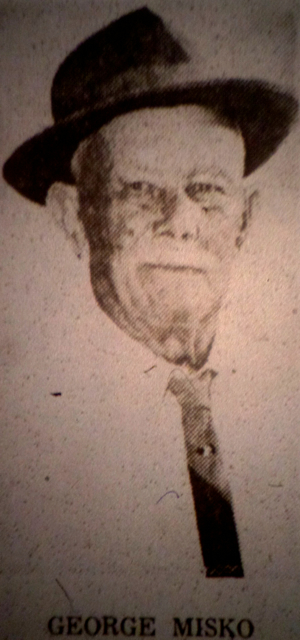

Captain George A. Misko and Madeline Pitalo
[image made Biloxi Cemetery-August 2012]
Captain George Anthony Misko (1878-1971) was born March 25, 1878 in the Bobovisce, a village on the island of Brac off the Dalmatian coast. He arrived at Biloxi in 1903 and became a crewman on the Julia H., a schooner owned by Lopez-Dunbar and Company. In 1908, he married Madeline [Mandelina] Pitalo (1888-1983) and lived at 215 Cedar Street with their children: Anthony 'Tony' Misko (1911-1993) m. Ida Mae Nadalich (1914-1996); Elizabeth Misko (1913-2001) m. Mr. Gutierrez; Albert J. Misko (1915-2006) m. Eunice Leckich; Georgio Misko (1920-1924); Stephen 'Steve' Misko (1918-1930); Madeline Rita Misko m. Charles D. Jenkins; Peter Misko (1923-1985) m. Laura Kracher; Antonia Misko (1926-2011) m. Joseph A. Juen; Frances A. Misko m. Joseph M. Lamas; Lucretia Misko m. Mr. Doljanin; and John 'Brioche' Misko (1930-2012). During the off-season he worked on the track gang of the local street carline.(The Daily Herald, April 22, 1971, p. 2)
George A. Misko was a charter member of the Slavonian Benevolent Association and worshipped at St. Michael's Catholic Church He retired in 1949 after sailing Biloxi's srhimp and oyster watercraft. In 1968, Captain Misko reined over the Biloxi Shrimp Festival. In March 1968, Captain Misko was feted for his 90th natal anniversary at his Cedar Street home. A confectionary replica of the Jolly Traveller, his fishing boat, graced the dining table at the celebration.(The Daily Herald, March 26, 1968, p. 14)

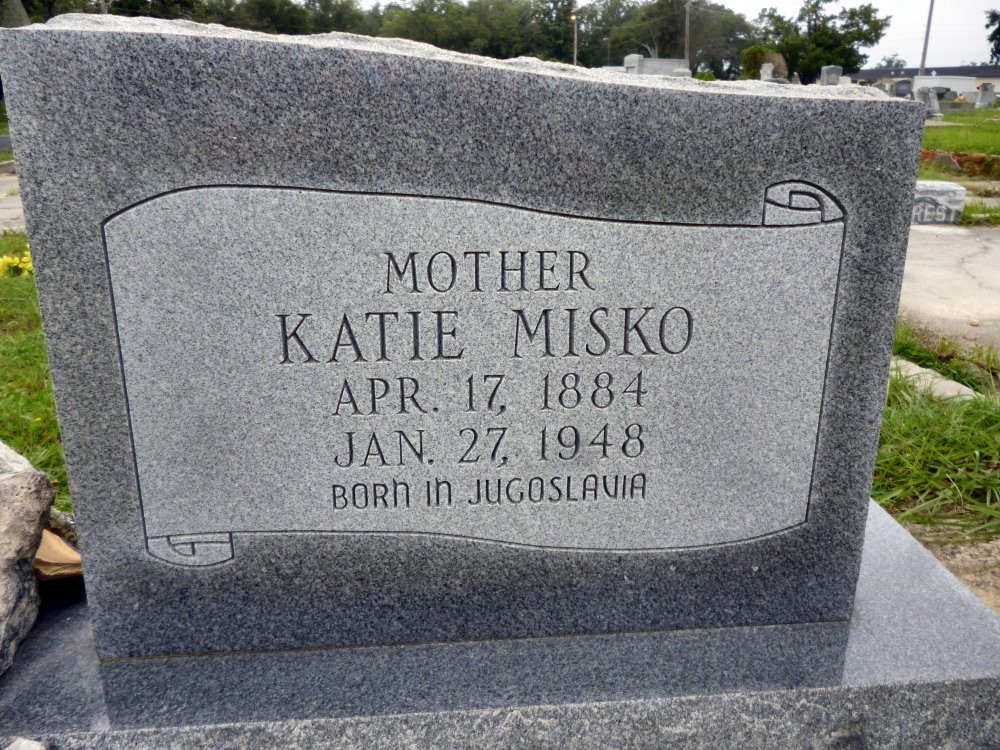
Peter D. Misko Sr. and Katie Misko-Biloxi Cemetery [image made August 2012]
Peter Dominick Misko (1881-1959) was born June 10, 1881 . He married Katrina 'Katie' Skrmetta (1884-1948). Children: Anthony Misko (1909-1910); Nicholas A. Misko (1911-1994) m. Flavia Hebert; Lawrence Misko; Lucretia Misko (1920-2006) m. Peter V. 'Troubles' Skrmetta (1917-2000); Peter Dominick Misko Jr. (b. 1914); and Steve Rocco Misko (1916-2006) m. Mary Lou Misko; and Joseph R. Misko (1916-1990) m. Velma Dujmov (1922-1998).
Lucy [Lucia] Misko (1892-1975) was born in Louisiana. She married Vincent Polovich (1882-1952), a native of NOLA and the son of Matre Polovich and Mary Krich in Harrison County, Mississippi on November 24, 1915. Their children were: Matre Polovich (1917-1998) m. Dorothy Romero (1925-2003); Lucille Polovich; Anthony V. Polovich m. Margaret Migues; Vincent J. Polovich (1925-2007) m. Edith Allen; and Lucretia Polovich.
John Misko married Olivia Sekul
REFERENCES:
The Biloxi-D'Iberville Press, "Time Traveler-"Living Historians-Conversation with Peter Misko", Jauary 24, 2013, p. 4.
The Daily Herald, “[John Misko] Waiting for bride from Dalmatia [Olivia Sekul]”, June 19, 1920.
The Daily Herald, “Marriage licenses”, January 24, 1921.
The Daily Herald, “George Misko celebrates his 90th birthday", March 26, 1968.
The Daily Herald, “Biloxi Shrimp Festival King (George Misko) of 1964 Dies, April 22, 1971.
The Daily Herald, "Peter Misko", January 11, 1985, p. A2.
The Sun Herald, “Velma Dujmov Misko", September 1, 1998.
The Sun Herald, “Lucretia Misko Skrmetta”, March 7, 2006.
The Sun Herald, “Stephen Rocco Misko”, March 17, 2006.
The Sun Herald, "Peter Misko Jr. looks forward to a century of living", August 27, 2006, p. F11.
The Sun Herald, “Antonia Misko Juen”, June 20, 2011, p. A6
The Sun Herald, "John 'Brioche' Misko", November 4, 2012, p. A13.
_____________________________________________________________________________________________
MLADINICH
Ernest J. Mladinich (1875-1953) was the son of Jacob Mladinich and Dina Filipich and a native of the village of Milna on the Island of Brac in the Adriatic Sea just off the Damaltian coast of Croatia. He married Catherine Bonacich Mladinich (1874-1962), also a native of Milna. They acquired their land on Point Cadet in December 1931. Ernest Mladinich expired on January 20, 1953. He had come to Biloxi from Croatia, then a part of the Austrian-Hungarian Empire, in 1901. Mladinich was a veteran of the Austrian Navy. He and wife, Catherine Bonacich, were the parents of two children: Ernest Mladinich Jr. (1906-1990) m. Amanda Tremontana (1908-1997) and Dina Mladinich (1914-2006) m. John J. Labetich (1909-1944) and Peter Kuljis (1902-1966).(The Daily Herald, January 20, 1953, p. 4 and The Sun Herald, October 7, 2006)
Dixie Fisheries Incorporated
Dixie Fisheries Incorporated owned by Ernest Mladinich Sr., Ernest Mladinich Jr., and J. Mladinich Sr. are making extensive improvements to their East Beach plant to comply with the new health inspection requirements. The work will be completed before the opening of the shrimp season.(The Daily Herald, August 2, 1934, p. 2)
CHILDREN
Ernest J. Mladinich Jr.
Ernest J. Mladinich Jr. (1906-1990) was born at Biloxi, Mississippi on 1906. On June 29, 1924, in Harrison County, Mississippi, he married Amanda Tremontana (1908-1997), a Croatian immigrant and the daughter of Joseph Tremonta (1878-1950), who born on Brac, Croatia and Mary Cerenich, also a Croatian immigrant. The Tremontana family came to Biloxi from Croatia in 1921 and lived at 240 Myrtle street with their children: Joseph Tremontana Jr.; Amanada Tremontana (1908-1997) m. Ernest Mladinich Jr. (1906-1990); Lucretia Tremonta (1911-1937) m. Earl F. Cook (19-1999); Josephine Tremontana (1913-2004) m. Julian K. Cook (1908-1994); and Mary Tremontana m. Thomas Garbin (1895-1966) and Mr. Calmut.(Harrison Co., Mississippi Circuit Court MRB 39, p. 411)
Ernest and Amanda T. Mladinich (1906-1990) were the parents of two daughters: Katherine 'Katie' Mladinich (1928-2018) m. James Preston Coleman Jr. (1928-1995) and Mary M. Mladinich (b. 1935).(Harrison Co., Mississippi Circuit Court MRB 39, p. 411)
Ernest retired from the Biloxi Police as its Captain after twenty years of loyal service. He was a member of the Slavonian Society of Biloxi and a Catholic. Mr. Mladinich died at Biloxi on April 5, 1990. Riemann Memorial Funeral Home, Beauvoir Road, Biloxi directed his funeral followed by internment in Southern Memorial Park.(The Sun Herald, April 6, 1990, p. )
Amanda T. Mladinich (1908-1997), age 89, died on March 4, 1997. Her corporal remains were also interred at Southern Memorial Park .
Children

Katherine 'Katie' Mladinich Coleman (1928-2018), age 89 years, of Biloxi, Mississippi passed away Thursday, March 15, 2018 in Gulfport, Mississippi. Mrs. Coleman was born in Biloxi, Mississippi on November 27, 1928 to Ernest Jacob and Amanda Tremontana Mladinich. She was co owner of Serv-Rite Grocery Store for many years. Mrs. Coleman enjoyed playing bingo and loved spending time with her grandchildren. She was preceded in death by her husband of 48 years, Preston Coleman, Jr.; and her parents. Mrs. Coleman's survivors include her children, Sharon (Dale) Creel, James (Kathy) Coleman, Jr. and Mary (Virgil) Morse; her sister, Margaret Mladinich; 9 grandchildren; 8 great-grandchildren; and 4 step great-grandchildren. At Mrs. Coleman's request, there will be no services held. The Howard Avenue Chapel of Bradford-O'Keeefe Funeral Home is in charge of arrangements.[The Sun Herald, March 18, 2018]
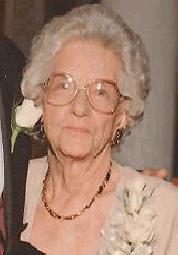
Dina M. Mladinich
Dina Mary Mladinich (1914-2006) married John Joseph Labetich (1909-1944). He died at the Presidio, US Army Camp, in San Francisco, California on February 20, 1944. in Harrison County, Mississippi on September 12, 1934. They had one daughter, Frances Labetich who married Gus C. Cavalier Jr. (1933-2005). John J. Labetich's corporal remains were interred in the Biloxi Cemetery.(The Daily Herald, February 21, 1944, p. 7 and March 1, 1944, p. 8 and The Sun Herald, October 7, 2006)
After the demise of her spouse, Dina M. Labetich in July 1948 married Peter Kuljis (1902-1966) in Harrison County, Mississippi.(Harrison Co., Mississippi MRB 77, p. 475)
Obituary
Mrs. Dina Mary Mladinich Labetich Kuljis (1914-2006) died October 4, 2006, at her Biloxi residence. Dina was born March 1, 1914.
She was preceded in death by her husbands, John Joseph Labetich and Peter "South America" Kuljis; mother, Catherine Bonacich Mladinich; father, Ernest Mladinich, Sr.; brother, Ernest Mladinich, Jr.; sister-in-law, Amanda Tremontana Mladinich, and son-in-law, Gus Cavalier, Jr.
She is survived by a daughter, Frances Labetich Cavalier; grandsons, Daniel John Cavalier of Daphne, AL, Joel Craig Cavalier and his wife, Laurie, of Biloxi; great grandsons, Michael Graham of Honolulu, HI, Jesse Kittrell of Biloxi, and Grant Edward Cavalier and Great Granddaughter, Shelby Danielle Cavalier and her mother, Chris, of S. W. Ranches, FL; and her beloved companions, Barbie, Ken, Tigger and Nala.
Dina was a former member of St. Michael Catholic Church and St. Michael Altar Society until August, 2005. She then became a member of Our Lady of Fatima Catholic Church. She was a retired seafood worker and was a dedicated member of the Slavic Ladies Auxiliary. She donated time and talent to their famous pusharata sales and the Slavic Benevolent Association of St. Nicoli and their famous Slavic Golf tournament.
Although her eyesight and hearing failed in her later years, she was always eager and ready for outings with her faithful companions, for a trip to the casinos and weekly pitty pat card games.
Dina won her battle with cancer years ago. It took a stroke to bring her down. She only asked, "How did this happen?" She never questioned God or complained. When asked how she felt, she would answer, "Just fine." When asked if she hurt, she would respond, "No, thank God."
Nana taught everyone she met to love and forgive. She taught us that life is short and to live each day like it was their last. To know her was to love her. The angels carried her to heaven where she joined our loved ones who were eagerly waiting for her. There is no doubt that her first words to God were, "Where's the broom?"
A special thanks to Dr. Dawn Hanson, Deaconess Home Health, Trinity Hospice, and to the caregivers at Nursing Management for their tender loving care.
Visitation will be Monday, October 9, 2006, from 5 until 8 p.m. at the Howard Avenue Chapel of Bradford-O'Keefe Funeral Homes in Biloxi. Rosary will be at 7:30 p.m. A Mass of Christian Burial will be held Tuesday at 11 a.m. at Our Lady of Fatima Catholic Church where friends may visit one hour before service time. Interment will follow in Biloxi City Cemetery. After the burial, friends and family are invited to Our Lady of Fatima Hall for a gathering after which they are also invited to the home of Joel and Laurie Cavalier, 2019 Marisol Court, Biloxi, (in Bent Oaks Subdivision) for a celebration of her life.[The Sun Herald, October 7, 2006]
Andrew Mladinich
Andrew Mladinich (1877-1938), also a son of Jacob Mladinich and Dina Filipich, came to America in 1902 and Biloxi in 1905. He had married Clementine Bonacich at Milna in 1901. She came to Biloxi in August 1906 aboard the SS Brooklyn debarking Marseille, France on August 4, 1906 with their two children: Ola Ursula Mladinich (1900-1988) and Andrew Jakonro [Jake] Mladinich (1902-1967).
Clementine B. Mladinich expired at Biloxi on June 18, 1915. She had been a resident of Biloxi for nine years and had resided at 208 Cedar Street. Her corporal remains were interred in the Biloxi Cemetery.(The Daily Herald, June 18, 1915, p. 1)
CHILDREN
Ola U. Mladinich
Ola Ursula Mladinich (1900-1988) married Matre Peter Pitalo (1898-1981), a Croatian immigrant, at Biloxi, Mississippi on December 20, 1917. They were the parents of: Peter M. Pitalo (1919-2000+); Andrew Pitalo (1920-1939); John Pitalo (1922-1932); Elizabeth R. Pitalo (1923-2000) m. Dennis Frank Dartez (1920-1983); Marguerite Pitalo (1926); and Anthony 'Tony' Pitalo Sr. (1928-2000+) m. Blanche Jumonville.(Harrison Co., Mississippi Circuit Court MRB 29, p. 437 and 1930 Harrison Co., Mississippi R 1146, p. 23A, ED 2)
Jake Mladinich
Jake Mladinich (1902-1967) married Mary Pierotich, the daughter of John Pierotich and , in Harrison County, Mississippi on June 3, 1925. They lived at 1435 First Street and reared two sons: A. Jake Mladinich (1926-2014) and John M. Mladinich (1928-2013).
Children

-image.jpg)
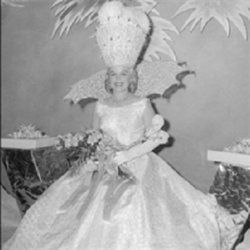
Andrew Jake Mladinich II and E. June Stojcich Mladinich
A. Jake Mladinich II (1926-2014), Biloxi entrepreneur and personality, died at Biloxi on December 18, 2014. A. Jake “Jake” Mladinich II, was born on May 28, 1926 in Biloxi, MS. His parents, A. Jake Mladinich, Sr. and Mary Mladinich, provide a classic example of immigrants who lived out the American Dream. They were Slavic immigrants who came to Biloxi in the late 19th century to work in the seafood industry. With hard work and the help of relatives they eventually acquired waterfront property and built a successful and well-known complex of tourist-related family businesses on the beach in an area that is now in west Biloxi. Jake worked in the family businesses and eventually inherited in 1987, a segment of his parents properties, including the Fiesta entertainment complex, the Cabana Beach apartments and the Sea-n-Sirloin Restaurant.
Jake’s many civic memberships and titles included Past President and current member of the Slavic Benevolent Association, Past President of the MS Gulf Coast Hotel Association, MS Gulf Coast Restaurant Association and MS Gulf Coast Motel Association; Past Commissioner of the Biloxi Port Commission and the Point Cadet Development Commission (PCDC-Waterfront Master Plan); Past Board of Directors of the Biloxi Chamber of Commerce; Past Vice-President and current member of the Biloxi Businessmen’s Club; current member of Main Street Biloxi, Biloxi Bay Chamber of Commerce, B.P.O. Elks, Chapter #606 and Biloxi Yacht Club.
Jake owned many businesses which included The Flame Restaurant in Gulfport, The Party Store, the Hot-Stop Restaurant, Peppermint Lounge, The Nineteenth Hole, Fiesta at the Fiesta Complex, the Sports Page Lounge, Cabana Beach Motel and Apartments, Fiesta Gift Shoppe, Sea-n-Sirloin Restaurant, White Pillars Gourmet Restaurant, Le Chateau Apartments, Traders Lounge, Rodenberg Properties, LLC, Fiesta, Inc. and Orleans, Inc. all in Biloxi.
Jake was preceded in death by his parents. His survivors included his wife of 57 years, Ethel June Stojcich McElveen Mladinich (1927-2015), the daughter of Anthony Stojcich (1901-1983) and Edna Fowler (1902-1982); his children, Mary Kathleen Mladinich Spain, Andrew Jake Mladinich, III, Andra June Mladinich, April Mladinich Fairley and Tania Mladinich (William) Buchanan; his grandchildren, David Andrew Spain, Kathleen June Miller, Damien Alexander Spain, Dennis Anthony Spain, Andrew Jake (Katie) Mladinich, IV, Richard Anthony Mladinich, Jeffrey Randall (Heather) Fairley, II, Charlotte Renee Fairley (Eric) Martin, Amy Darlene Fairley, June Pierce Shivers, William Buchanan, IV, Gavin Buchanan and Liam Buchanan; his great-grandchildren, Aubree Jade Mladinich, Rowan Christopher Fairley, Kaitlyn Shivers and Morgan Shivers.(The Sun Herald, December 20, 2014, p. A-6 and March 12, 2015, p. A-4)
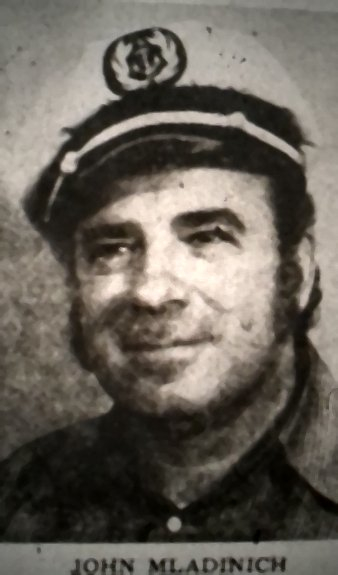
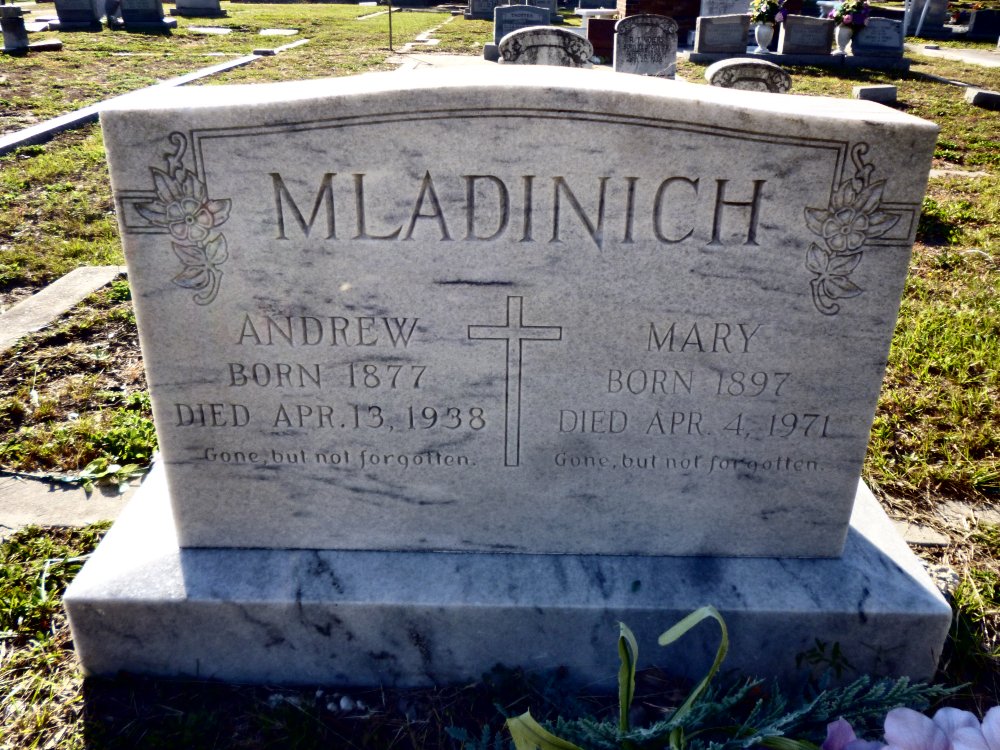
[Biloxi Cemetery-October 2012]
After the death of Ola, in Louisiana, probably Iberia Parish, he married Mary Bourgeios (1897-1971), the daughter of Alces Bougeois and Eva Louvier, a native of Avery Island, Louisiana. Andrew applied for naturalization in May 1922. He lived at 237 Cedar Street in Biloxi at the time.(The Daily Herald, June 2, 1922, p. 3 and April 5, 1971, p. 2)
Children: Andrew Mladinich Jr. (1920-1955); Julius Joseph Mladinich (1921-2011) m. Teresa Flora Larvella (1925-1960) and Rita Griffin Roddy (1922-1999), the widow of William J. Roddy (1912-1962); Eva Mae Mladinich (1922-2017) m. Frank Joseph Mallette (1920-2008); Ernest Paul Mladinich (1926-1988) m. Nona Mae Foster (1925-1985); Lucille Mladinich (1915-1990) m. Ballinger ; Mary Ann Mladinich m. Sidney D. Johnson; and Thomozina Mary Mladinich m. Wallace Hebert (1921-1995).
CHILDREN
Andrew Mladinich Jr.

[The Daily Herald, October 24, 1955, p. 2]
Julius J. Mladinich

Eva Mae Mladinich

Eva M. Mladinich
Eva Mae Mladinich (1922-2017) was born at Biloxi on December 7, 1922 to Andrew and Mary Mladinich. At St. Michael's Catholic Church on 3 June 194, she married Frank Joseph Mallette (1920-2008), probably a native of Missouri and in the US Coast Guard. Frank passed at Gainesville, Florida in January 2008. They had divorced in Orleans Parish, Louisina in April 1946. Eva Mallette, a life-long resident of Biloxi, passed away peacefully on 13 October 2017 at the Kare Med Personal Care Home in Ocean Springs at the age of 94 years. A life well-lived. At a young age she went to work in the seafood factories, then had a successful career with the Base Exchange at Keesler, retiring as a manager. She later was the hostess at the Sea 'n Sirloin restaurant. Eva was a very outgoing, generous, funny, and caring lady. Always the life of the party, she never met a stranger and always had a joke to tell and a plate of goodies to share. She was a dedicated member of Our Lady of Fatima. She traveled the country with the Golden Age Club, keeping the entire bus laughing. Eva was a member of the Slavonian Lodge in Biloxi. She loved her longtime pets Pippi and Chance. She enjoyed fishing, playing cards, the Saints, the Braves, bingo, and the slots. Eva spent many days fishing with her grandsons, catching lots of catfish. She made the best pork roast in the world. Eva is survived by her son, Kenneth (Wanda) Mallette of Ocean Springs, MS; grandsons, Dr. Scott (Chetta) Mallette of Monument, CO, and Dr. Jeff (Dane) Mallette of Gulf Breeze, FL; great-grandchildren, Alyssa Mallette, Gabrielle Mallette, Sarah Mallette, Rachel Mallette and Michael Mallette; great-great-granddaughter Violet Mallette; sisters, Thomasine Hebert of Biloxi, MS, Lucille Ballinger of Charlotte, NC, and Mary Ann Johnson of Gulfport, MS. She was preceded in death by her parents, Andrew and Mary Mladinich of Biloxi, MS; brothers, Andrew Mladinich Jr. of Biloxi, MS, Ernest Mladinich of Biloxi, MS, and Julius Mladinich of New Orleans, Louisiana. A memorial service is scheduled for Thursday, November 9th, at 11:00 AM at Our Lady of Fatima in Biloxi, with a reception to follow in the Parish Center. All are welcome to attend and celebrate Eva's life. In lieu of flowers, please send memorials to Our Lady of Fatima, 2090 Pass Rd, Biloxi, MS, 39531. The family would like to thank Bea, Crystal, Jenny, and Shavon at Kare Med and Regina, Tammy, and Stephanie of Notre Dame Hospice for their care of Eva in her final days.[The Gainesville Sun, January 11, 2008 and The Sun Herald, November 7, 2017]
Ernest P. Mladinich
Ernest Paul Mladinich(1926-1988) was born at Biloxi, Mississippi. He was a Merchant Marine. Ernest was a member of Our Lady of Fatima Catholic Church, the Slavonian Benevolent Association and Seafarers Union International. Ernest married Nona Mae Foster (1925-1985) in Harrison County, Mississippi on February 26, 1960.
Ernest expired at Biloxi on February 11, 1988. His corporal remains were interred at Southern Memorial Park by Bradford-O’Keefe Funeral Home.(The Sun Herald, February 12, 1988, p. A4.
Mary Ann Mladinich
Tomozina M. Mladinich
Tomozina Mary Mladinich was born at Biloxi, Mississippi. She married Wallace Joseph Hebert (1921-1995) in Harrison County, Mississippi on August 3, 1942. Children: Wallace J. “Joe” Hebert (1943-2003) m. Anne Hebert; Kevin Troy Hebert m. Shirley Jean Pizzetta; Pamela Jane Hebert m. Billy Jo Smith and Daniel Chadwick Griffon; and Mary Beth Hebert m. Mr. Farrell.
Wallace J. Hebert died at Biloxi, Mississippi on January 22, 1995.(The Sun Herald, January 24, 1995, p. A-2)
Mary Mladinich
REFERENCES:
Harrison County, Mississippi Chancery Court Cause No. 54114-The Estate of Jake Mladinich Sr.-
Journals
The Daily Herald, "", June 18, 1915.
The Daily Herald, "Naturalization applicants [Andrew Mladinich] start for citizenship", June 2, 1922.
The Daily Herald, "Improving factory", August 2, 1934.
The Daily Herald, "[Andrew] Mladinich funeral", April 14, 1938.
The Daily Herald, "[Preston] Coleman-[Katherine] Mladinich", February 4, 1947.
The Daily Herald, "Mladinich-Redding", May 23, 1949
The Daily Herald, "Mrs. Catherine Mladinich", October 22, 1962.
The Daily Herald, "Ernest Mladinich dies", January 20, 1953.
The Daily Herald, "Andrew Mladinich Jr.", October 24, 1955.
The Daily Herald, "Lucy T. Mladinich", January 7, 1963.
The Daily Herald, "[Jake] Mladinich rites”, March 22, 1967.
The Daily Herald, “Mrs. Mary Mladinich”, April 5, 1971.
The Gainesville Times, 'Frank Mallette', January 11, 2008.
The Sun Herald, "Ernest [Paul] Mladinich", February, 1988.
The Sun Herald, "Ernest J. Mladinich Jr.", April 6, 1990.
The Sun Herald, "Wallace J. Hebert", January 24, 1995, p. A-2.
The Sun Herald, "Preston Coleman Jr.", October 29, 1995.
The Sun Herald, "Wallace “Joe” Hebert", September 10, 2003, p. A-10.
The Sun Herald, “Julius Joseph ‘Joe’ Mladinich”, January 30, 2011, p. A10.
The Sun Herald, "Mladinich wins Jacobs award", November 25, 2012.
The Sun Herald, "Mladinich earns Coast tourism award", November 28, 2012.
The Sun Herald, "Mladinich earns Coast tourism award", November 28, 2012.
The Times-Picayune, “Decisions-Mallette v. Mallette”, April 3, 1946, p. 25.
The Times-Picayune, “Action is taken in slander suit”, April 16, 1963.
The Times-Picayune, “Rita Griffin Roddy Mladinich”, October 2, 1999.
______________________________________________________________________________________________
PAVLOV
Peter Pavlov(1882-1951) was born March 16, 1882 to George Pavlov and Diana Sapurnich at Brac, Split-Dalmatia County, Croatia. Peter came to America in 1905. He embarked from Le havre, France on the La Savoie on December 10, 1905 and arrived at New York City on December 17, 1905. Peter declared his intention to become an American citizen at Biloxi, Mississippi on December 6, 1917. He was naturalized at Biloxi on February 21, 1921 receiving Certificate of Naturalization No. 1511976.[Declaration of Intention No. 346 and Petition for Naturalization No. 239-US District Court-Southern Division of Mississippi]
Peter Pavlov married Anna Hire (1882-1962), a native of Bobovisce, Brac, Split-Dalmatia County, Croatia. They lived at 324 Pine Street on Biloxi’s Point Cadet. Peter made his livelihood as a fishermen in the Biloxi canning industry and became a partner in the Seacoast Packing Company. He served as its president from 1934 until his demise. Peter expired at home on January 17, 1951. His corporal remains were interred in the Biloxi Cemetery.(The Daily Herald, January 18, 1951, p. 6)
Peter and Anna Hire Pavlov were the parents of six children: Danica V. Pavlov (1908-1996) m. Grgur 'George' Garbin (1893-1969); George Pavlov (1910-1963) m. Cecile Arguelles (1908-1994); Margaret Pavlov (1912-2008) m. Vincent 'Visco' Kuluz(1898-1987); Frances 'Flossie' Pavlov (1915-2004) m. James J. Touchet;Peter Pavlov II (1919-2012) m. Mary Alice Smith (1925-2015); and Frank Buffalo Pavlov (1920-2005) m. Hilda Marie Belter (1922-1999).
Danica V. Pavlov
Danica Victoria Pavlov (1908-1996) was born December 23, 1908 at Biloxi, Mississippi.
George Pavlov
George Pavlov (1910-1963) was born August 9, 1910 at Biloxi, Mississippi.. He married Cecile Arguelles (1908-1994), the daughter of Joseph Peter Arguelles (1866-1944) and Louise E. Bellman (1867-1958). They were the parents of George Pavlov Jr. (1943-1991) m. Janet Bosarge and Martha Ann Webb and Wayne J. Pavlov (b. 1945). George Pavlov expired on September 7, 1963 while Cecile A. Pavlov lived until March 21, 1994. Both were interred in the Biloxi Cemetery 6th Addition on the north side of the CSX Railroad tracks.
Margaret Pavlov
Margaret Pavlov (1912-2008) was born July 1, 1912 at Biloxi, Mississippi. She married Vincent Kuluz
Frances "Flossie"Pavlov Touchet
Frances "Flossie" Pavlov Touchet was born February 24, 1915 at Biloxi, Mississippidied Wednesday, April 7, 2004, in Biloxi after a brief illness. She was 89 years old. Mrs. Touchet was born Jan. 28, 1915 and was a native and lifelong resident of Biloxi. She was a retired seafood worker and was employed at Austin's Style Center at its original location in downtown Biloxi. However, she was mainly known for her culinary talents, preparing Slavonian pastries and other dishes for family gatherings and for her many friends. Her "red velvet" cake became the signature dessert at the White Pillars Restaurant in Biloxi.
"Flossie" also was known for her sharp wit, her colorful candor and her friendliness Frances. She was a member of the Slavic Ladies Auxiliary and St. Michael's Catholic Church in Biloxi. In the early '30s she was also queen of the Oyster Festival in Biloxi.
The light of her life was her son, James Joseph "J.J." Touchet, Jr., a onetime high school and collegiate football standout who died when his Navy fighter jet crashed in 1978 in Lake Eufala, Ala. She was also preceded in death by her parents, Peter and Annie (Hire) Pavlov; a brother, George Pavlov; and a sister, Danica (Pavlov) Garbin.
She is survived by a sister, Margaret (Pavlov) Kuluz of Biloxi; two brothers, Dr. Peter Pavlov of Ocean Springs, and Frank Pavlov of Biloxi; and her special niece and caregiver, Frances (Kuluz) Creel of Biloxi. She will be greatly missed by her many nieces, nephews, other family members and friends.
Peter Pavlov II
Dr. Peter ‘Doc’ Pavlov II was born February 23, 1919 at Biloxi, Mississippi. He married Mary Alice Smith (1925-2015) at St. Michael’s Catholic Church on May 3, 1947. Mary was reared in Jonestown, Mississippi and raised on the family farm in Philipp, Mississippi.[Harrison Co., Mississippi Circuit MRB 74, p. 325]
Children: Peter Pavlov III; Michael Pavlov, PhD; Mary Ann Pavlov m. Wolfgang Vogelbein; Dr. Paul Marion Pavlov (b. 1955) m. Theresa Ann Lamburth (b. 1954-Chicago), daughter of Paul Raymond Lamburth and Harriet Mozelle Nix; Joseph Pavlov; Dr. John Pavlov; and Francis Pavlov.
Frank B. Pavlov
Frank Buffalo Pavlov married Hilda Belter May 26, 1949.
REFERENCES:
The Daily Herald, “Georgette Pavalov [sic] and John Mavar are head of Carnival Ball", February 19, 1938.
The Daily Herald, “Pavlov death”, Januay 18, 1951.
The Sun Herald, “Danica V. Garbin”, January 13, 1996.
The Sun Herald, “Frances Pavlov Touchet”, April 10, 2004.
The Sun Herald, “Mrs. Mary Smith Pavlov”, February 10, 2015.
_______________________________________________
PIEROTICH
John J. Pierotich (1877-1942) and Antonia Barhanovich (1880-1957) were the progenitors of the Biloxi family. They were both born on August 14, 1877 at Supetar [St. Peter], Isle of Brac, Split-Dalmatia County, Croatia. John J. Pierotich arrived at New York City on June 8, 1905 from Trieste on the SS Bremen. Antonia arrived at New York City on November 14, 1947 aboard Princess Irene.(Declaration of Intention No. 350-Southern District Court-South Mississippi-December 6, 1917 and Petition for Naturalization No. 262-Southern District Court-South Mississippi-January 27, 1921)
John J. Pierotich and family lived at Biloxi, Mississippi on 231 Cedar Street and 219 Maple Street. He made his livelihood in Biloxi’s seafood industry harvesting oysters and shrimp for various seafood canneries. J.J. Pierotich and spouse were the parents of Matthew Frank Pierotich (1905-1956) m. Viola Bond (1908-1994); Mary Pierotich (1907-1983) m. Jake Mladinich (1902-1967); John J. Pierotich Jr. (1908-1969) m. Hilda E. Fountain (1914-1991); Frank Pierotich (1911) m. Eunice Bailey; and Anthony Pierotich (1913-1986) m. Sara Nell Lint (1928-1987).
Children
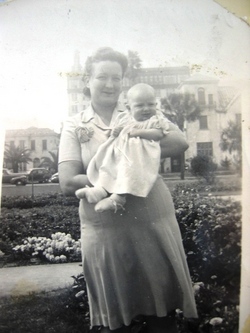
Viola Bond Pierocich and son
.jpg)

Matthew F. Pierotich
Matthew Frank ‘Slim” Pierotich (1905-1956) was born September 11, 1905 at Biloxi, Mississippi. He married Viola Bond (1908-1994) and their children were: Louis Lee ‘Billy’ Pierocich (1937-2006) m. Lillian Delchamp and Elmyra Pal Pierocich m. Pat Harrison Reeves.
Mary Pierotich
Mary Pierotich (1907-1983) was born June 23, 1907 at Biloxi, Mississippi. She married Jake Mladinich (1902-1967) in Harrison County, Mississippi on June 3, 1925. Children: John Mladinich and Jake Mladinich

John J. Pierotich Jr.
John J. ‘Spex’ Pierotich Jr.(1908-1969) was born at Biloxi, Mississippi on August 27, 1908. He married Hilda E. Fountain (1914-1991) in Harrison County, Mississippi on January 31, 1934. They lived at 301 Howard Lane in Biloxi where John made his livelihood as a boatman for a seafood factory. John and Hilda were the parents of two children: Ronald 'Ronnie' C. Pierotich (b. 1935) m. Judith Ewing (1934-2010) and Maxine Pierotich (b. 1939).(1940 Harrison Co., Mississippi T627_2024, p. 20A, ED 24-2)
Children
Ronald C. Pierotich
Ronald C. Pierotich married Judith Ewing (1934-2010) in Harrison County, Mississippi on June 26, 1955. Children: Mark Anthony ‘Doby’ Pierotich (1957-1993) m. Roxann Marie Gutierrez and Jennifer Ann Pierotich m. Larry Allen Drawdy.(Harrison Co., Mississippi Circuit Court MRB 101, p. 571)
Frank Pierotich
Frank Pierotich (1911-) was born at Biloxi, Mississippi on July 29, 1911. He married Eunice Bailey, the daughter of Lottie Gazzo, on May 4, 1935 at Pascagoula, Mississippi. Mayor J.W. Watts officiated at their nuptials. Miss Veronica Anticich and Frank ‘Buddy’ Bass were their attendants.(The Daily Herald, July 17, 1935, p. 2)
Frank Pierotich made his livelihood as a fisherman until June 1935, when he was appointed to the Biloxi Police Department by Mayor John W.A. O’Keefe.(The Daily Herald, July 1, 1935, p. 1)
.jpg)
Anthony C. Pierotich
Anthony Ching Pierotich (1913-1986) was born at Biloxi, Mississippi on February 13, 1913. He married Sara Nell Lint (1928-1987) in Harrison County, Mississippi on April 30, 1948.
REFERENCES:
The Daily Herald,‘Telephone case is postponed’, June 23, 1921.
The Daily Herald,‘Changes in Biloxi Personnel’, July 1, 1935.
The Daily Herald,‘Wedding Announcement’, July 17, 1935.
The Daily Herald,‘Eunice Pierotich dead’, July 19, 1937.
The Daily Herald,‘Mrs. [Eunice] Pierotich’s funeral’, July 20, 1937.
The Daily Herald,‘John Pierotich Sr. dies’, March 20, 1942.
The Daily Herald,‘M.F. (Slim) Pierotich’, June 21, 1956.
The Daily Herald,‘Mrs. Antonia Pierotich’, May 11, 1957.
The Daily Herald,‘John Pierotich Sr. dies’, March 20, 1942.
The Sun Herald,‘Hilda F. Pierotich’, August 28, 1991.
The Sun Herald,‘Viola Bond Pierocich Woodward’, January 1, 1995.
The Sun Herald, 'Billy Pierocich', October 25, 2006.
The Sun Herald, 'Louis Lee Billy Pierocich', October 26, 2006.
The Sun Herald, 'Judith Pierotich', July 17, 2010.
The Times-Picayune,‘Pierotich new port unit head’, March 20, 1974.
_____________________________________________________________
PITALO
.jpg)
.jpg)
Biloxi Cemetery-6th Addition-Section 2-Block 6-Lot 100 .
GEORGE PITALO
George Pitalo (1860-1928) was born in January 1860 at Bobovisce, Isle of Brac, Split-Dalmatia County, Croatia. He married Anastasia 'Stona' Trebotich (1858-1942), probably at Brac. It appears that George Pitalo left 'Austria' and landed at New York City on August 28, 1902. He declared his intention to become an American citizen at Biloxi, Mississippi on December 7, 1917.(Declaration of Intention No. 355-Southern District Court of South Mississippi-December 1917)
The Pitalo children were also born at Brac, Split-Dalmatia County, Croatia and came to America with their mother in 1904: Louis A. Pitalo (1891-1959) m. Ursula Sekul; Matre Pitalo m. Mary Kuluz; Antonio Pitalo (1899-1977) m. Katie Surian (1908-1988); and Nicholas Pitalo m. Lenora Antonsich.
The George Pitalo family settled at 322 Pine Street on Biloxi's Point Cadet and worked in Biloxi's thriving seafood industry as oystermen and seafood factory workers. George Pitalo died at Biloxi on March 26, 1928. Stonal lived until August 6, 1942. The year and day of her death on her tombstone appears to be incorrect from her burial records.
Children
Louis A. Pitalo (1891-1959), son of George Pitalo and Anastasia Trebotich, married Ursula Sekul (1900-1975). Children: George Pitalo (1923-1931); John Anthony 'Crash' Pitalo (1924-2007) married Marguerite "Margie" Vickery (1923-2005); and Estelle Pitalo married Robert Himmel.
Matre Pitalo married Mary Kuluz on June 20, 1921 in Harrison County, Mississippi. They were the parents of: Anastasia Pitalo m. Joseph 'Zibbie' Jurich (1918-1967); George Pitalo (1924-2006) m. Hazel Marie Langlinais; Matre Pitalo Jr. m. Jumonville?; and Marion Daniel Pitalo m. Sarah Roberts Tremmel.
Anthony G. Pitalo (1899-1977) arrived at New York in 1904. He was born at Bobovisce, Brac. He was a resident of 322 Pine Street when applying for citizenship in August 1918. Anthony Pitalo was naturalized in June 1921 and he married Katherine "Katie" Surian (1908-1988). They later lived at Bay St. Louis.(The Daily Herald, August 5, 1918, p. 3, August 18, 1920, p. 4, and June 23, 1921, p. 1)
Children

Anthony G. Pitalo
Anthony G. Pitalo Jr (1931-2017), age 86 years, passed away on March 22, 2017. Known to his family and friends as "Buddy," he was born on January 22, 1931 in Biloxi to Anthony and Katherine Pitalo. He grew up in Bay St. Louis, graduated from St. Stanislaus College in 1948, and went on to graduate from Tulane University in 1952. Following his college graduation, Buddy served two years in the United States Air Force before returning home to work in his father's store, Pitalo's Supermarket. It was during that time that he courted and then married Patricia Poolson in 1957. Buddy began his teaching and coaching career in 1960 at St. Stanislaus College. He obtained his Master of Science degree from William Carey College while teaching. Buddy was a member of the SSC Sideline Club and he dedicated 25 years to teaching at the school, from which he retired in 1985. After retiring, Buddy then built a restaurant that he called, "Bud's Catfish House." He and his family worked together to make the business successful. Once he sold the restaurant in 2006, he dedicated his time to traveling with Pat and attending the extra-curricular activities of his grand-children and eventually his great grand-children. Any spare moments were spent out in his yard picking up pecans or working on a household project. He truly enjoyed just being outside. In May of 2013, Buddy was honored as the oldest living baseball coach for St. Stanislaus College. Just this year, he was honored by the American Legion Post 139 for 45 years of service and loyalty. Buddy was preceded in death by his parents, Anthony G. Pitalo, Sr. and Katherine S. Pitalo, and by his sister, Anna P. Gayaut. He is survived by his loving and loyal wife of 59 years, Patricia P. Pitalo, and his four children, Catherine R. Pitalo, Donald A. Pitalo (Carolyn), David C. Pitalo (Cathy), and Cynthia P. Wasilenko (Clayton). He was a doting grandfather to his grand-children, Courtney P. Rich (John), Moira Nix, Anthony Pitalo, Allyson Pitalo, Ryan Pitalo, Caroline Pitalo, Hannah Pitalo, and Abbie Sawyer. Buddy was also blessed to have seven great grand-children, Dominique, Cayler Ann, Jayden, Beckam, Harley, Lawson, and Skylar. The family wants to thank his caregivers at Dunbar Village and Notre Dame Hospice. They would also like to thank his home caregivers, especially Dale, Cherriel, Mary, and Evette, for their support during his last days. Visitation will be held at 10:30 am with Mass to follow at 11:30 am at Our Lady of the Gulf Catholic Church on March 24, 2017. A private burial service will be held next week. Edmond Fahey Funeral Home is in charge of the arrangements.[The Sun Herald, March 24, 2017]
Nicholas Pitalo (
PETER PITALO
Peter Pitalo (1866-1947) was born February 20, 1866 at Bobovisce, Brac, Croatia. Circa 1891, Peter Pitalo married Elizabeth Tremontana (1865-1925), the daughter of Mateo Tremontana and Lucretia Sekul. They were the parents of: John Joseph Pitalo (1893-1918); Yerka Pitalo (1895); Matre Pitalo (1898-1981) m. Ola Mladinich (1900-1988) ; and Peter Pitalo (1900)
Peter Pitalo came to Biloxi circa 1904. His wife and children arrived in 1907 and settled at 322 Pine Street. Peter Pitalo worked as a fisherman in the Biloxi seafood industry and later owned a grocery and market on the NE/C of Cedar and 1st Street on Point Cadet. Peter expired at NOLA on May 23, 1947. He was survivied by matre Pitalo, his son, and Margaret Zaro, a sister and resident of Sacremento, California. Peter's corporal remains were interred in the Biloxi Cemetery.(The Daily Herald, May 24, 1947)
John J. Pitalo
John Joseph Pitalo (1893-1918) was born March 5, 1893 in Croatia. He came to Biloxi in 1907. John expired at 213 Cedar Street on December 2, 1918. His corporal remains were interred in the Biloxi Cemetery.(The Daily Herald, December 2, 1918, p. 3)
Matre P. Pitalo
Matre Peter Pitalo (1898-1981) was born in Croatia on September 6, 1898. He married Ola Mladinich (1900-1988), also a Croation immigrant, at Biloxi, Mississippi on December 20, 1917. They were the parents of: Peter M. Pitalo (1919-2000+); Andrew Pitalo (1920-1939); John Pitalo (1922-1932); Elizabeth R. Pitalo (1923-2000) m. Dennis Frank Dartez (1920-1983); Marguerite Pitalo (1926); and Anthony 'Tony' Pitalo Sr. (1928-2016) m. Blanche Jumonville (1928-2016).(Harrison Co., Mississippi Circuit Court MRB 29, p. 437 and 1930 Harrison Co., Mississippi R 1146, p. 23A, ED 2)
Children

Anthony Pitalo
Anthony M. "Tony" Pitalo, Sr., age 87 years of Ocean Springs, MIssissippi, passed away Wednesday, May 25, 2016 in Ocean Springs. Tony was born in Biloxi and was a lifelong resident of the Gulf Coast. He was the owner of Pitalo's Hardware and Boat Supply. Tony enjoyed all sports, loved playing golf and watching horse racing. He was a member of the Slavonian Lodge and St. Michael Catholic Church. He is preceded in death by his wife, Blanche Jumonville Pitalo ; his parents, Matre and Ola Pitalo; his sisters, Elizabeth Dartez and Margaret Pitalo; and his brothers, Peter Pitalo, John Pitalo and Andrew Pitalo. Tony's survivors include his daughter, Kristi (Tommy) Murphy; his son, Tony Pitalo, Jr.; and his grandchildren, Brent Murphy and Shannon Murphy. In lieu of flowers the family prefers donations be made to St. Michael Catholic Church. A Mass of Christian Burial will be held at St. Michael Catholic Church on Friday, May 27, 2016 at 10:30 am. Friends may visit from 9:30 am until mass time. Interment will follow at Biloxi City Cemetery.(The Sun Herald, "Blanche Pitalo", May 16, 2016 and The Sun Herald, 'Anthony M. Pitalo Sr.', May 26, 2016)
Anthony Pitalo
Anthony M. Pitalo (1892-1966), called Tony, was born at Bobovisce, Isle of Brac, Split-Dalmatia County, Croatia on February 1, 1892. He left Palermo, Italy in November 1907 aboard the SS Campania, a Cunnard liner, for New York City arriving here on December 5, 1907. Anthony settled on 1326 1st Street at Biloxi, Mississippi with Marica Rosetti (1895-1986), a native of Starigrad, Hvar, Croatia. They were married at Gulfport, Mississippi on January 6, 1915. Tony became an American citizen at Biloxi, Mississippi on June 20, 1912 receiving No. 1511995.[Harrison Co., Mississippi Circuit Court MRB 27, p. 230 and Petition for Naturalization-South District Court-South Mississippi Certificate No. 256, January 14, 1921 and June 20, 1921]
Children: Stephen J. Pitalo (1916-1980) m. Dorothy M. Pitalo (1923-1989) ; Anthony M. Pitalo Jr. (1920-1995) m. Marguerite Vickery Parker; and Mandina Pitalo (1924-1975) m. Charles Vincent Polite (1917-2005).
Tony M. Pitalo made his livelihood at Biloxi as a fisherman. He had been secretary of the Slavonian Benevolent association, member of the Biloxi Benevolent Association, East End Volunteer Fire Company and the Croatian Fraternal Organization. Tony expired on May 6, 1966 at the US Public Health Service Hospital in New Orleans where he had been a patient for three days. Mr. Pitalo was survived by Marcia [sic] Pitalo, his widow; one daughter, Mrs. Charles Polite of Biloxi; a foster daughter, Mrs. George Little of McAllister, Montana; two sons, Steve Pitalo and Tony Pitalo Jr., both of Biloxi; five sisters: Stella Yurich of New York City; Mary Bilic of Camden, New Jersey; Angelina Trevizjon of South America; and Mrs. Frances Skrmetta and Miss Anna pitalo, both of Yugoslavia; and eight grandchildren. Burial was in Biloxi Cemetery.(The Daily Herald, May 6, 1966, p. 2)
 and Catherine Sekul (1891-1970).jpg)
Alexsandro Pitalo and Catherine Sekul
Biloxi Cemetery-March 2014
Alexsandro Pitalo
Alexsandro Pitalo (1887-1960) married Catherine Sekul (1891-1970) in Harrison County, Mississippi on February 1, 1913. Children: Dr. Stephen S. Pitalo (1914-2004) m. Marjorie Harris (1917-1992); Magdalena Pitalo (1915-1916) and Tony Pitalo (1917-1917); Peter Pitalo (1919-1982); Alex Mike 'Lou' Pitalo; and Mark Pitalo.(Harrison Co. Mississippi Circuit Court MRB 25, p. 224)
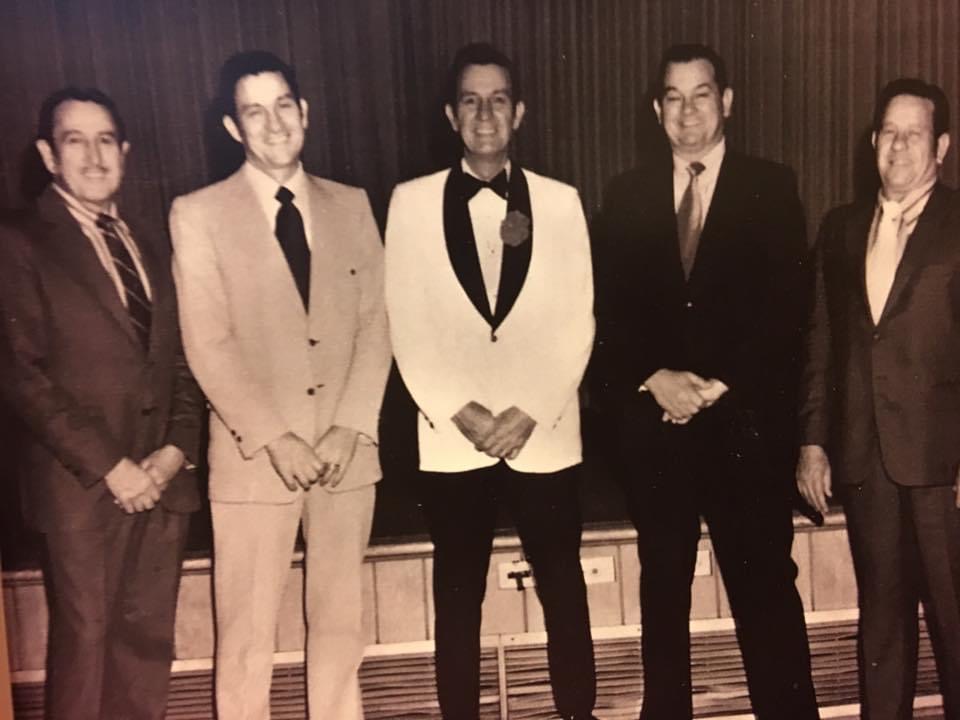
Children

[L-R: Steve 1914-2004), Lou (1925-), Mark, John (1921-2000) and Peter Pitalo (1919-1982) from Facebook of Margaret Pitalo Peeples]

Stephen S. Pitalo
Dr. Stephen S. Pitalo, age 90 years, and a native and lifelong resident of Biloxi, died Monday December 20, 2004 in Biloxi. Dr. Pitalo graduated from Biloxi High School in 1932, and from Perkinston Jr. College in 1934. He then attended Loyola School of Dentistry and received his D.D.S. in 1938. He was a Captain in the U.S. Army Air Corp. during WWII. Dr. Pitalo was also a member of the Slavic Benevolent Association of Croatia, a longtime member of the Lions Club and the Reveler's Carnival Association, and was an active member of the Perkinston Alumni Association. He was also active in Babe Ruth Little League Baseball and a member of Sunkist Country Club. Dr. Pitalo was a member of Our Lady of Fatima Catholic Church in Biloxi. Preceding him in death was his wife Marjorie Harris Pitalo. He is survived by three sons; Gerald A. Pitalo and wife Tam of New Orleans, LA, Stephen "Kenny" Pitalo of Huntsville, AL, and Ric Pitalo and wife Robin of Biloxi, MS., two brothers; Lou [Alex M.] Pitalo and Mark Pitalo, both of Ocean Springs, MS, six grandchildren; Stephen Pitalo, Richele Ann Pitalo, Paul Pitalo, Shannon Nolan, Patrick Nolan, and Margaret Korn, and five great-grandchildren.
Visitation will be Monday December 27, 2004 at the Howard Ave. Chapel of Bradford O'Keefe Funeral Homes from 6:00pm until 8:00pm. A recitation of the Rosary will be at 7:30pm. Services will be on Tuesday December 28, 2004 at Our Lady of Fatima Catholic Church, where Dr. Pitalo will lie in state beginning at 9:00am with a Mass of Christian Burial starting at 10:00am. Burial will follow at the Biloxi National Cemetery.(The Sun Herald, December 26, 2004)
CALIFORNIA
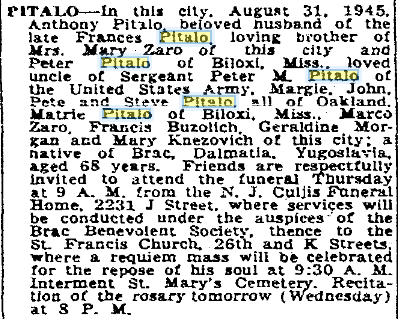
[from The Sacremento Bee, September 4, 1945, p. 21]
REFERENCES:
The Daily Herald, “Wedding yesterday [Skermetti-Pitalo]”, April 21, 1914.
The Daily Herald, “Patallo-Roseta”, January 7, 1915.
The Daily Herald, “Death of John Pitalo”, December 2, 1918.
The Daily Herald, “Waited 16 years to become citizen”, August 18, 1920.
The Daily Herald, “Boats charged with violating oyster law [Captain M. Pitalo] at Pascagoula”, June 1, 1928.
The Daily Herald, “Mrs. Pitalo dies”, August 7, 1942.
The Daily Herald, “Peter Pitalo dies in New Orleans”, May 24, 1947.
The Daily Herald, “Infant [Michael John] Pitalo dies”, December 18, 1950.
The Daily Herald, “Pitalo Hardware founder, Matre Pitalo, dies at 82”, June 3, 1981.
The Daily Herald, “Mrs. Mary 'Marisa' Pitalo”, March 10, 1986..
The Sun Herald, “Mrs. Ola Mladnich Pitalo”, October 11, 1988.
 and Mary G. (1894-1968).jpg)
Peter J. Radich (1875-1954) was born September 30, 1875 at Brac, Split-Dalmatia County, Croatia the son of Nicholas Radich and ?. He came to Biloxi in November 1902 and lived at 212 Pine Street where he made his livelihood as a fisherman in Biloxi's seafood industry. Peter departed Europe from LeHavre, France and arrived at New York City aboard the SS Latonia on October 21, 1902. He became an American citizen on November 24, 1920 at Biloxi, Mississippi.(Petition for Naturalization-US District Court-Southern Mississippi No. 240, filed July 24, 1920 and The Daily Herald, July 26, 1920, p. 3)
Peter married Mary Guich (1894-1968), a native of Milna, Split-Dalmatia County, Croatia, in Harrison County, Mississippi on April 17, 1913. They were the parents of: Nicolena Radich (1914-2001) m. William Peter Strayham (1909-1956); Etta Cora Radich (1916-1998); Nicholas Charles Radich (1918-1976); Andrew Tony Radich (1921-2004); Peter M. Radich (1924-2011) m. Emelda Joyce Diaz (1925-2013); Tony Radich (1926-2014); Mary Peggy Radich (1929-1955) m. Henry G. Byrd; Victoria Radich (1936-1936); and Stella Ann Radich (1939-1941).(Harrison Co., Mississippi Circuit Court MRB 25, p. 266 and 1930 Harrison Co., Mississippi 1930 Federal Census R11146, p. 23B, and ED 2)
Nicholas C. Radich
Nicholas 'Nick' Charles Radich (1918-1976) was born July 17, 1918 at Biloxi, Mississippi. He lived at 212 Pine Street in Biloxi where he made his livelihood as an independent, commercial fisherman. Nick was owner and Captain of the Mary Etta, a shrimp boat. Nick died on March 17, 1976 in the Marine Hospital at New Orleans after a long illness. He was survived by two sisters, Miss Etta Cora Radich and Nicolena Radich, the spouse of William Peter Strayham; and four brothers: Andrew Radich; Peter Radich; Tony Joseph Radich (1926-2014); and John 'Hack' Radich, all of Biloxi.(The Daily Herald, March 17, 1976, p. A2)
Tony Joseph Radich (1926-2014) was born September 14, 1926 on Point Cadet. He attended St. Michael's Catholic School through the 8th grade and then worked in Biloxi's seafood industry until enlisting in the US Navy in 1943. After a trying diesel mechanic school in New York, Tony decided that his future lie in the Merchant Marine service. He retired after 35 years of sea duty and setttled in the Radich family home on Point Cadet. Mr. Radich died at Biloxi on April 9, 2014. His internment was in the Biloxi Cemetery.(The Sun Herald, April 11, 2014, p. A-4)
REFERENCES:
The Daily Herald, "Peter Radish files admission papers", July 26, 1920, p. 3.
The Daily Herald, "Nick C. Radich", March 17, 1976, p. 2.
The Sun Herald, "Nicolena Radich Strayham", September 5, 2001, p. A7.
The Sun Herald, "Emelda Joyce Diaz Radich", October 16, 2013.
The Sun Herald, "Tony Joseph Radich", April 11, 2014.
RODOLFICH

CAPTAIN STEPHAN RODOLFICH [from The Times-Picayune, March 27, 1933, p. 17]
Captain Stephan ‘Steve' Rodolfich (1887-1971), a 1900 Croatian immigrant, and Johanna ‘Noonoo’ Molitva Skrmetta (1886-1980), a 1907 Croatian immigrant and the daughter of John Skrmetta (1852-1929) and Perina Marinovich (1854-1937), were the progenitors of the Rodolfich family of Biloxi, Mississippi. Captain Steve was born February 22, 1887 and Johanna M. Rodolfich on February 7, 1886, both on the Island of Brac, Croatia. Their children were: Mary Rodolfich (1908-1997) m. Julius Barich (1907-1993); Perina Rodolfich (1911-2006) m. Mr. Lees; Stephania Rodolfich (b. 1913) m. Ralph Olier (1923-2006); Sophie Vincentia Rodolfich (1914-1960); Nicholas D. Rodolfich (1915-2005) m. Margaret Lorraine Smith (1924-2013); John Rodolfich (1917-1917); and Olive Rodolfich (b. 1924).
The Rodolfich family resided at 116 Maple Street in Biloxi. Steve Rodolfich was a fisherman and in 1918 he was employed by the Dunbar-Dukate Company. In 1930 the family also operated a grocery store on Maple Street, while Captain Steve continued to earn his livelihood from the sea.(1930 Harrison Co., Mississippi Federal Census R1146, p. 30B, ED 2)
1929 HALAT DROWNING
Marko 'Mike' A. Halat (1880-1929) settled at 118 Pine Street in Biloxi. He had arrived here circa 1904 and made his livelihood as a fisherman. In late August 1929, Mike Halat was working for Captain Steve Rodolfich (1887-1971) aboard the Arcadia, a power boat, in Lake Borgne, Louisiana. While attempting to tie an awning rope, it broke and he fell into the lake. All attempts to save Mike Halat were futile as he was a poor swimmer. His body was found near the Rigolets by Captain Vincent Kuluz (1898-1987), master of the Annie Long. The US Coast Guard had dispatched two vessels for his search and rescue and at least twenty-five fishing boats from Violet, St. Bernard Parish, Louisiana were on the scene. Tony M. Pitalo, a nephew, was aboard one of the USCG boats during the search for Halat's body. Mike Halat's ccorpse was brought to the O'Keefe Undertaking Service at Biloxi and buried on August 31, 1929 in the Biloxi Cemetery. Pallbearers for Mr. Halat's Catholic funeral service were: Vincent Rosetti; Steve Rodolfich; Mitchell Cavanaugh; Jerry Covich; and Steve T. Sekul. Nick Trebotich of Oakland, California, a cousin of Mrs. Halat, came to Biloxi for the funeral.(The Daily Herald, August 30, 1929, p. 1 and p. 8, August 31, 1929, p. 1, and September 4, 1929, p. 4)
1940 LOVING CUP
Captain Steve Rodolfich 116 Maple Street was honored with a silver loving cup for his contributions to the oyster industry by Dunbar-Dukate and the Louisiana Conservation Department for delivering the best oysters to Violet, Louisiana for the 1940 oyster season and for the discovery of oyster reefs in Lake Borgne.(The Daily Herald, June 28, 1940, p. 8)
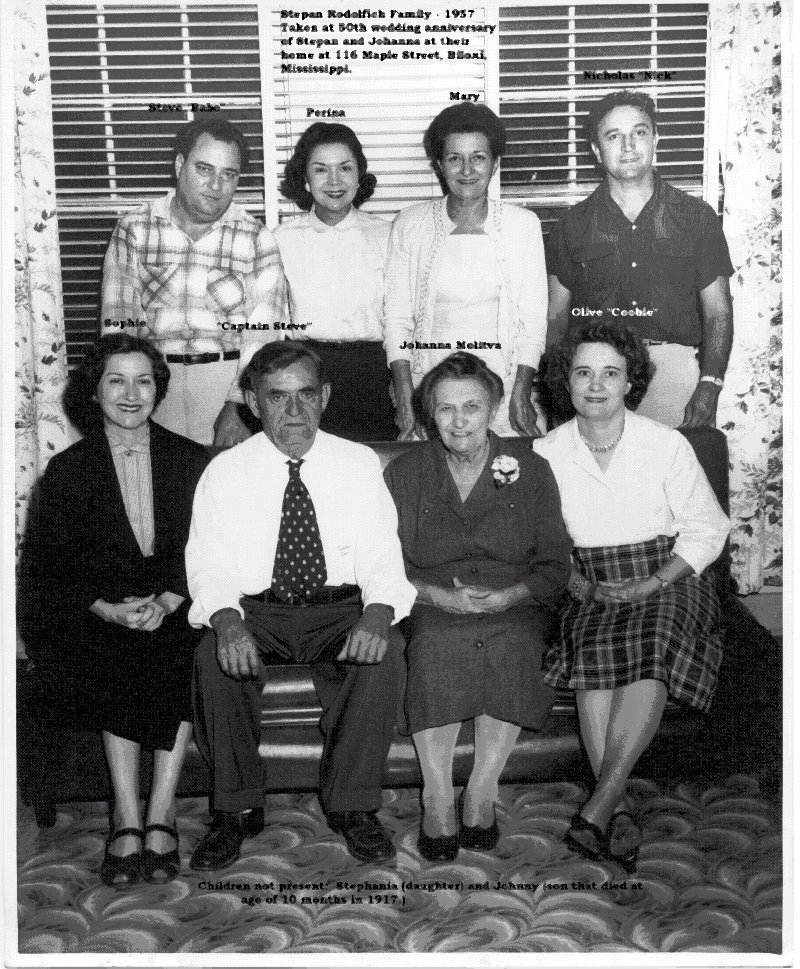
RODOLFICH FAMILY [Courtesy of Ava Rodolfich Coleman-February 2012]
CHILDREN
MARY RODOLFICH
Mary Rodolfich (1908-1997) was born on April 4, 1908. Circa 1927, she married Julius Barich (1907-1993), a 1922 Croation immigrant. In 1930, the Barich family lived at 212 Cedar Street and Julius made his livelihood as a fisherman. Children: Mary Joyce Barich (1928-1999); Barbara Catherine Barich m. James Mickey McCarthy; and Perina Juliet Barich.(1930 Harrison Co., Mississippi Federal Census R1146, p. 46B, ED 2)
Julius Barich expired on January 23, 1993. Mary Rodofich Barich passed on October 1997 and Mary Joyce Barich died on September 13, 1999. Their corporal remains were interred in the Evergreen Cemetery on Old Fort Bayou at Ocean Springs, Mississippi.
PERINA RODOLFICH
Perina Rodolfich (1911-2006) was born February 2, 1911. In August 1938, Perina Rodolfich, Miss East Biloxi, participated in the Miss Mississippi beauty contest held at Biloxi. She was a fine accordion player and had played the instrument on broadcast radio. On October 23, 1938, Perina married Barney C. Rogers in the St. Peter and Paul Catholic Church at Chattanooga, Tennessee. Barney C. Rogers (b. 1914) was the son of Professor and Mrs. Joel Rogers of Chattanooga. He was a graduate of the University of Chattanooga and was employed with Rogers & Leventhal, a construction company. Barney was reared in the Sale Creek region north of Chattanooga, Hamilton County, Tennessee. Later Perina Rodolfich married Mr. Lees. They lived at NOLA. No further information.(The Daily Herald, January 3, 1934, p. 2 and 1930 Hamilton Co., Tennessee Federal Census R 2253, p. 5B, 3rd Civil District)
STEPHANIA RODOLFICH
Stephania Rodolfich (1912-1988) was born August 10, 1912 at Biloxi, Mississippi. She married Ralph A. Olier (1923-1985). They were the parents of two children: Sandra B. Olier m. Davis and Ralph S. Olier. Stephania expired at Biloxi on September 21, 1988. Her corporal remains were interred in Southern Memorial Park.(The Sun Herald, September 22, 1988, p. A-4)
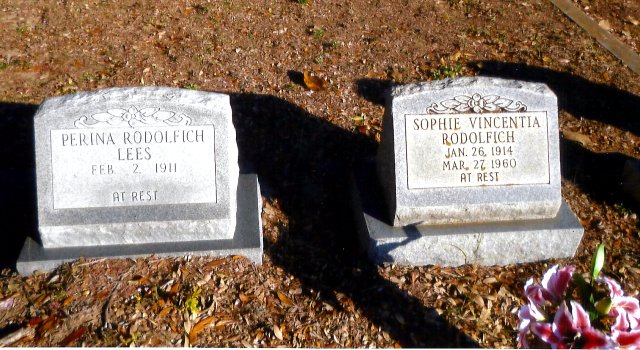
BILOXI CEMETERY [December 2012]
SOPHIE V. RODOLFICH
Sophie Vincentia Rodolfich (1914-1960) was born January 26, 1914. She never married and circa 1957 she went to live at NOLA with Perina R. Lees, her sister. Sophie expired in the Crescent City at the Touro Shakespears Home on March 27, 1960. Miss Rudolfich was survived by two brothers, Steve 'Babe' Rudolfich and Nick Rodolfich, both at Biloxi; four sisters, Mrs. Julius Barich of Gulf Hills, Mrs. Perina Lees of New Orleans; Mrs. Ralph Olier and Miss Olive Rodolfich, both of Biloxi. Her corporal remains were sent to Biloxi, Mississippi for interment in the Biloxi Cemetery.(The Times-Picayune, March 28, 1960, p. 3 and The Daily Herald, March 28, 1960, p. 2)

Margaret L. Smith Rodolfich (1924-2013)
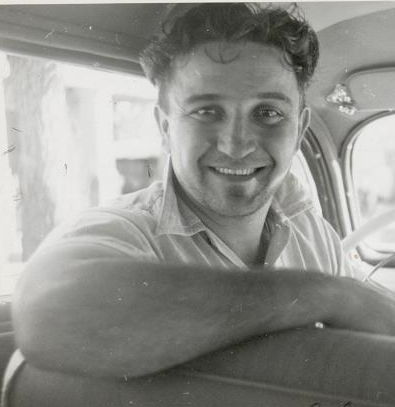
NICHOLAS D. RODOLFICH
[image made 1947 at Detroit and courtesy of Ava Rodolfich Coleman via FaceBook]
Nicholas Dominic Rodolfich (1915-2005) was born October 17, 1915. Nicholas married Margaret Lorraine Smith (1924-2013), a native of Georgetown, Washington and the daughter of Soloman and Gladys Smith, in Harrison County, Mississippi in November 1952. Children: Nicholas Keef Rodolfich; Jean Rodolfich m. Alexander Vendrell; Angela Rodolfich m. Mr. Ladner; and Ava Rodolfich m. John Coleman.(Harrison Co., Mississippi Circuit Court MRB 91, p. 488 and The Sun Herald, December 3, 2005, p. A10 and January 2, 2014, p. A4)
JOHN RODOLFICH
John Rodolfich (1917-1917) was born January 11, 1917 and died October 23, 1917.(Tombstone-Biloxi Cemetery)
STEPHEN RODOLFICH
Stephen ‘Babe’ Rodolfich (1919-1981) was born January 25, 1919. On October 23, 1938 at Pascagoula, Mississippi, he married Flora E. Hardy (1923-2006), the niece of Maye Hardy. They resided at 527 Chartres Street in Biloxi. Babe and Flora E. Rodolfich were the parents of four children: Steve Rodolfich (1939-2011) m. Robin Sue Galle’; Wayne Rodolfich (1942-2000) m. Susan Marie Gilmore; Forrest Lane Rodolfich (b. 1943) m. JoeLynn Frances Jernigan; and Scarlett Rebecca Rodolfich (1948-1987) m. Wayne ‘Cage’ Elliott (1942-2004).
Babe Rodolfich reared his family on Church Street, now Fred Haise, in Biloxi, Mississippi. He was the proprietor of the Shady Oaks Lounge on Division Street. Babe Rodolfich passed on December 1981. Flora E. Rodolfich followed him in death expiring on September 21, 2003.
OLIVE RODOLFICH
Olive Rodolfich was born circa 1924. No further information.
REFERENCES:
The Daily Herald, “Mike Holot [sic], Biloxi fisherman, falls from boat, drown”, August 30, 1929.
The Daily Herald, “Search for Holat's body”, August 30, 1929.
The Daily Herald, “Body of fisherman brought to Biloxi”, August 31, 1929.
The Daily Herald, “Rogers-Rodolfich”, January 3, 1934.
The Daily Herald, “Oyster captain at Biloxi gets Cup”, June 28, 1940.
The Daily Herald, “Miss Sophie Rodolfich”, March 28, 1960.
The Sun Herald, “Mrs. Scarlett Elliott”, February 28, 1987, p. A4.
The Sun Herald, “StephanieRodolfich Olier”, September 22, 1988, p. A4.
The Sun Herald, “Mrs. Joan Lee Romano Rodolfich”, June 10, 1994, p. A2.
The Sun Herald, “Mary R. Barich”, October 2, 1997, p. A2.
The Sun Herald, “Mary Joyce Barich”, September 15, 1999, p. A7.
The Sun Herald, “Mr. Wayne Rodolfich”, April 19, 2000, p. A11.
The Sun Herald, “Flora E. Rodolfich”, September 23, 2003, p. A6.
The Sun Herald, “Nicholas Dominic Rodolfich”, December 3, 2005, p. A10.
The Sun Herald, “Perina Rodolfich Lees”, March 2, 2006.
The Sun Herald, “Margaret Lorraine Smith Rodolfich”, January 2, 2014.
The Times-Picayune, “Rich store of information on Louisiana fisheries given in Conservation Bulletin”, March 27, 1933, p. 17.
The Times-Picayune, “Deaths [Sophie Rodolfich]”, March 28, 1960.
Personal Communication:
Ava Rodolfich Coleman has been a major contributor and editor to this brief family history.
_____________________________________________________________________________________________
SEKUL
ANTHONY SEKUL
Anton Sekul (1854-1940) was the founder of the Sekul family of Biloxi, Mississippi. Anton was born in Bobovisce, Brac, Splitsko-Dalmatia County, Croatia, the son of Stephan Sekul and Jacobina Lurisich. He married Helena Skrmetta and they were the parents of twelve children: Roko Sam Sekul (1878-1947); Steve M. Sekul (1880-1966) m. Elena Trebotich (1884-1970); Jacobina Sekul (1881-1956) m. Marko Beaorvich (1883-1966); Vencentia Sekul (1884-1974) m. Joseph Keresich (d. 1906) and Sam Marinovich (1881-1956); John Sekul [Chile, South America]; Marko Sekul [Chile, South America]; Dominica Sekul (1889-1968) m. Frank Barhonovich (1886-1930); Catherine Sekul (1891-1970) m. Alexsandro Pitalo (1887-1960); Marica Sekul (1888-1948) m. Palmiro Gligo (1884-1949) [lived in Sacramento and San Pedro, California]; Peter C. Sekul (1892-1971) m. Mara Trebotich (1907-1996); Ursula Sekul (1900-1975) m. Louis Pitalo (1891-1959); Sister Olivia Mary Josephine [Split, Croatia]; and Maria Sekul m. Tom Cerinich [The Cerinich family lived at Hamilton Hill, Western Australia].
Anton Sekul arrived at Biloxi in 1928. He expired on September 16, 1940 at the home of Peter Sekul, his son, at 1627 3rd Street in Biloxi. Anton Sekul left two sisters: Katherine Sekul Trebotich (1859-1948) of Biloxi, Mississippi and Mrs. Nicholas Skrmetta of South America.(The Daily Herald, September 16, 1940)
CHILDREN
Roko Sam Sekul
Roko Sam Sekul (1878-1947) born at Bobovisce, Brac, Croatia on August 16, 1878. He came to Biloxi, Mississippi in 1902. During the Boer War, he was a horse-tender on a British ship. Roko made hi slivelihood as a fisherman and in later life was the night watchman for the Seacoast Packing Company. Roko S. Sekul expired on July 5, 1947. His corporal remains were interred in the Southern Memorial Park cemetery on Biloxi's West Beach.(The Daily Herald, August 14, 1920, p. 4 and July 7, 1947, p. 2)

Steve M. Sekul
Steve M. Sekul (1880-1966) married Elena Trebotich (1884-1970) in Harrison County, Mississippi in 1907. They were both Croatian immigrant from Bobovisce on the island of Brac in the Aegean Sea off the Dalmatian Coast. Children: Anton 'Tony' Sekul (1907-1907); Alena Sekul (1908-2002) m. Peter Cerinich (1894-1951); John M. Sekul (1911-1984) m. Elizabeth Marjorie Lamas (1917-1984); Jacobena Sekul m. Percy J. Wetzel Jr. and Andrew Gillich; Vincentia [Vitsie] Sekul (1915-2002) m. Alonzo Gabrich (1894-1948); Josephine Sekul (1918-1986) m. William F. Schaaf (19-1986+); and Clare Sekul (1922-2017) m. Warren H. Hornsby (1922-1996).
Groceryman
In July 1941, Steve M. Sekul acquired the City Hall Cash Grocery from Peter Cerenich and Alena Sekul, his spouse. Mr. and Mrs. Cerenich also operate a grocery on West Howard Avenue and Seal Avenue.(The Daily Herald, July 10, 1941, p. 3)
CHILDREN
Anton Sekul
Alena Sekul
Alena Sekul (1908-2002) was born on December 10, 1908. She married Peter Cerenich (1894-1951) at Biloxi, Mississippi on January 6, 1926. Children: Nicholas Douglas Cerenich (1926-2002) m. Gilda Astleford Wambsgans (1928-1976) and Betty Joyce Lawrence. Jeanette Cerinich (1928-2011+) m. Louis E. Capuana Sr. (1925-2005).(Harrison Co., Mississippi Circuit Court MRB 37, p. 485)
Groceryman
In late April 1940 , Peter Cerinich (1894-1951) let a contract with Joseph Wallace to build a new store and residence on the NW/C of West Howard Avenue and Seal Avenue. I. Daniel Gehr designed the structures. Clarence Kornman moved two houses from the Cerinich lot before construction commenced. Other contractors wefor the Cerinich projects were: Lester Frentz-painting; Albert Mangin-plumbing and electrical; and Biloxi Roof and Sheet Metal-roofing and metal work. The Cerinich store was called the Biloxi Cash Grocery and operated by Alena Sekul Cerinich (1908-2002) for over fifty years.(The Daily Herald, April 27, 1940, p. 3 and The Sun Herald, July 6, 2002, p. A6)
In July 1941, Petet Cerenich and wife sold their interest in the City Hall Cash Grocery to Steve M. Sekul, his father-in-law. Since the Cerenichs had just completed a new grocery on West Howard Avenue and Seal Avenue, they relinquished their Central Biloxi location..(The Daily Herald, July 10, 1941, p. 3)
Jacobena Sekul

Blessing of the Fleet
[L-R: Alton L. Bellande; Jacobena Sekul Gilich; Andrew M. Gilich; and Marcel "Mickey" Bellande]
John M. Sekul

John M. Sekul
John Marshall Sekul (1911-1984) was born at Biloxi, Mississippi on January 31, 1911 to Steve M. Sekul (1880-1966) and Elena Trebotich (1884-1970), both Croatian immigrant from Bobovisca on the island of Brac in the Aegean Sea off the Dalmatian Coast. Children: Alena Sekul (1909-1984+) m. Peter Cerinich (1895-1940+); John M. Sekul (1911-1984) m. Elizabeth Marjorie Lamas (1917-1984); Jacobena Sekul m. Percy J. Wetzel Jr. and Andrew Gillich; Vincentia [Vitsie] Sekul m. Alonzo Gabrich (18-1948); Josephine Sekul (1918-1986) m. William Schaaf; and Clare Sekul (1922-2011+) m. Warren Hornsby.
Education
John M. Sekul matriculated to Springhill College at Mobile and graduated from Loyola University Law School at New Orleans. He took the Mississippi bar exam in 1935 and in April 1935 spoke to the Biloxi Lions Club on the Biloxi seafood industry, a subject that he was intimately acquainted having been reared at 1627 East Third Street on Point Cadet.(The Daily Herald, April 2, 1935, p. 5)
Family
On October 30, 1938, John M. Sekul married Elizabeth Marjorie Lamas (1917-1984), the daughter of Rudolph Lamas (1877-1920+), a Biloxi seafood merchant, and Kathryn (1878-1920+). John and Marjorie were the parents of Judith C. 'Judy' Sekul (1939-1987) m. Raymond Charles Seymour (b.1931) and Steve M. ‘Buzzy’ Sekul.(1943-2009).(Harrison Co., Mississippi MRB 49, p. 244)
Demise
Judge Sekul died in the Biloxi Regional Medical Center on January 9, 1984. His corporal remains were interred in the Southern Memorial Park cemetery at Biloxi, Mississippi. Marjorie Lamas Sekul expired in December 1984.
Judith Sekul Seymour (1939-1987) died on May 2, 1987. She was survived by Raymond Charles Seymour, her spouse, and children: Julia Seymour Sheridan; Marjorie Seymour Ricahrd; Raymond C. Seymour Jr., and John F. Seymour. Stephen 'Buzzy' Sekul, her brother, also was a survivor of Mrs. seymour.(The Sun Herald, May 4, 1987, p. A4)
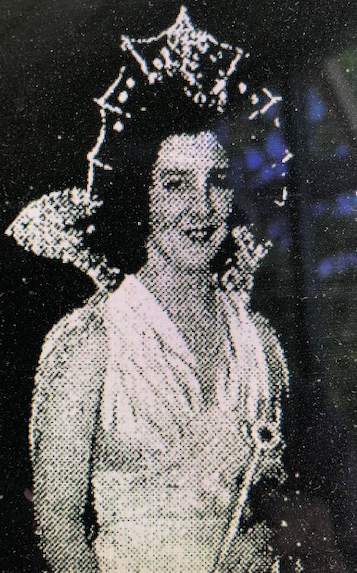
Josephine Sekul
Josephine Sekul Schaaf (1918-1986), age 67 years, died Wednesday, January 15, 1986 at John Sealy Hospital in Galveston, Texas after a brief illness. Josephine Sekul Schaaf, better known affectionately as "Aunt Jo," was born March 20, 1918 and reared in Biloxi, Mississippi. She was the daughter of the late Mr. and Mrs. Steve M. Sekul. She graduated from Biloxi schools and Soule Business College in New Orleans, La. In 1949 she and her husband, Bill, moved to Galveston and opened a seafood business, Fisherman's Wharf. She also owned and operated Shrimp & Stuff Restaurants. Aunt Jo was a member of Sacred Heart Church, Sacred Heart Altar Society, Galveston Restaurant Association, Texas Restaurant Association, National Marine Fisheries, and Wednesday Night Dance Club. She is survived by her husband, William F. Schaaf Sr.; six children, Elena Jo Garcia, Catherine Bennett, Joseph Stephen Schaaf and Stephen Sekul Schaaf, all of Galveston, Stephanie Wentzel of Kingwood, and William F. Schaaf Jr. of Dickinson, six grandchildren; and sisters, Alena Cerinch, Jackie Gilich, Vetsie Gabrich and Clare S. Hornsby, all of Biloxi. She is also survived by her niece, Anna Mae Gilich of Galveston, and numerous nieces and nephews in Biloxo. A funeral Mass will be at 11 a.m. today at Sacred Heart Church with the Monsignor Eugene Cargill officiating. Burial will be at Calvary Cemetery. A rosary was recited at 7 p.m. Friday at Sacred Heart Church, Father Tim Bucek officiating. Pallbearers will be W. Fred Hornsby, Drew Gilich, Steve Wetzel, Lonnie Gabrich, Louis Capuano, Andrew Gilich, Bo Hornsby and Nick Cerinich. Funeral arrangements are under the direction of Broadway Funeral Home. Memorials may be sent to St. Patrick's School or the American Heart Association. [The Galveston Daily News, 18 January 1986, p. 4-A]

MacArthur said, "I hold no branch in higher esteem than the Merchant Marine service."
During the war, Bill met his future wife, Josephine Sekul, from Biloxi, Miss.. Josephine's family owned Seacoast Packing Co., a shrimp cannery plant in Biloxi, and this was Bill's introduction to the seafood business. In 1949, Bill and Josephine opened Southeast Packing Co. in Galveston, Texas located at Pier 22. They packed and shipped shrimp across the United Sates. Warren Hornsby served as the national salesman for the company, and he and Bill made an incredible business team. In 1968, Bill and Josephine opened Fisherman's Wharf Pier 22 which catered to local patrons and tourists. In 1976, in a joint venture with their daughter and son-in-law, Catherine and Jim Bennett, they opened Shrimp and Stuff Restaurant. In 1980, the four of them opened another Shrimp and Stuff Restaurant on Stewart Road. Bill and Josephine's six children worked in the family business while growing up. One of Bill's greatest joys was providing jobs to the young people of Galveston. Many successful business and community leaders had their first work experience with Bill. They all learned the value of hard work.
Throughout the years, Bill became part of the fabric of Galveston. His wonderful smile, warm personality and fire-red hair were the perfect combination for making life-long friends. He was a member of Sacred Heart Catholic Church and the Sacred Heart Men's Club, president of the Galveston Jaycees, served as a director for Galveston Chamber of Commerce , and was a member of the Galveston Restaurant Association and the National Fishery Association.
In his earlier years, Bill was an avid golfer and he introduced his three sons to the sport. He never missed his weekly poker games with some of Galveston's finest. Bill enjoyed traveling, and he and his wife took their 6 children on many wonderful vacations across the country. He and Josephine also loved their frequent get-away trips to Las Vegas.
Bill was an amazing father to his children and involved in all of their activities while they were growing up. He also loved playing with his grandchildren and great grandchildren.
His house was always filled with laughter and fun. He worked hard, but also took time to enjoy his life and his family. His priorities were faith, family, and friends. He taught his children, through example and small lessons, how to be a good person and live with dignity. Bill's life was well lived.
In 2002, Bill married Gerry Bennett of Galveston, and they spent the next years until his death, hosting family events, parties with friends and traveling the world. After Hurricane Ike in 2008, they moved to Tuscan Lakes in League City, Texas, but they never lost their love of Galveston and their wonderful friends on the Island. They attended church in Galveston each Sunday and could often be seen at local restaurants afterwards.
Bill was preceded in death by his first wife, Josephine Sekul Schaaf, his daughter, Marian Lynn Schaaf, and his parents, Joseph and Katherine Schaaf.
Bill is survived by his wife Gerry Bennett, daughters Elena Jo Petree (Pete), Catherine Bennett (Jim), Stephanie Marquard (Kevin), sons William F. Schaaf Jr., Joseph Schaaf (Carolyn), and Stephen Schaaf (Cynthia). He is survived by his eleven grandchildren and ten great grandchildren, his sisters Ginger Christopher and Nancee Kearney and brother Michael Schaaf.
Visitation will be held on Monday, May 30, 2016, from 5-7 PM with a rosary at 6:30 PM at Sacred Heart Catholic Church in Galveston, Texas. The funeral mass will be held on Tuesday, May 31, 2016, at 11 AM at Sacred Heart Church with the Rev. Tim Bucek officiating. Internment will be at Calvary Catholic Cemetery in Galveston, Texas.
Proudly serving as pallbearers are Bill's six grandsons: Christopher Garcia, Geoff Wentzel, Greg Wentzel, Stephen Schaaf, William Schaaf, and John Preston Schaaf.
The Schaaf family wishes to thank his wonderful cardiologist Dr. Ahmed S. Ahmed who worked tirelessly in securing him a bed in the medical center, and the medical staff at Memorial Hermann Heart and Vascular Institute in Houston, Texas. Dr. Biswaijit Kar and his cardiology team provided world-class medical treatment for Bill. The CV-ICU nurses were exceptional with their care, compassion and love for Bill in his final days. The family wants to recognize particularly his nurse, Destiney MacAuley, who never left his bedside. The family also wishes to thank their many friends who prayed unceasingly for Bill's recovery. Our hearts were touched and your kindness will never be forgotten.[The Daily News [Galveston, Texas], May 26, 2016]
Clare Sekul
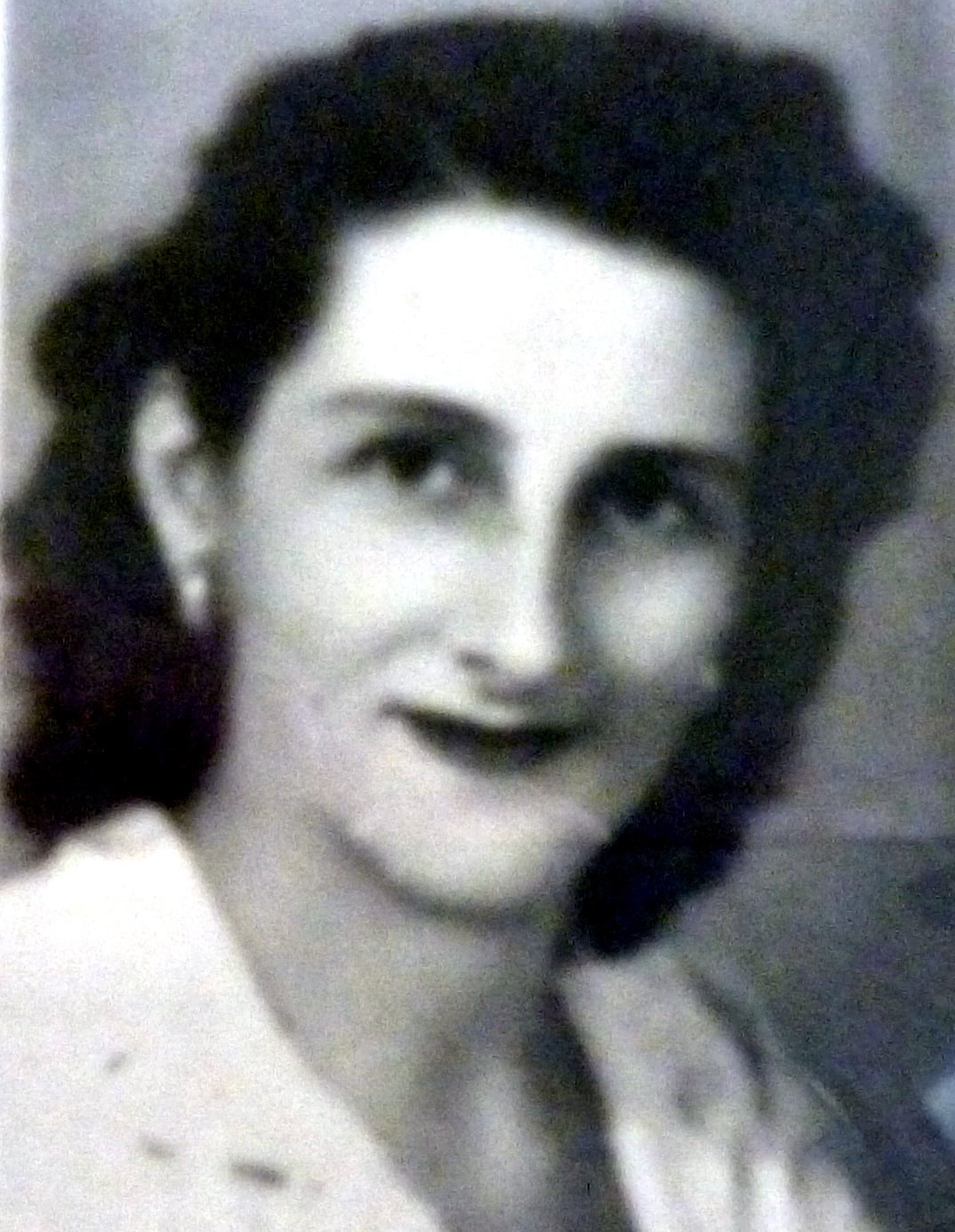
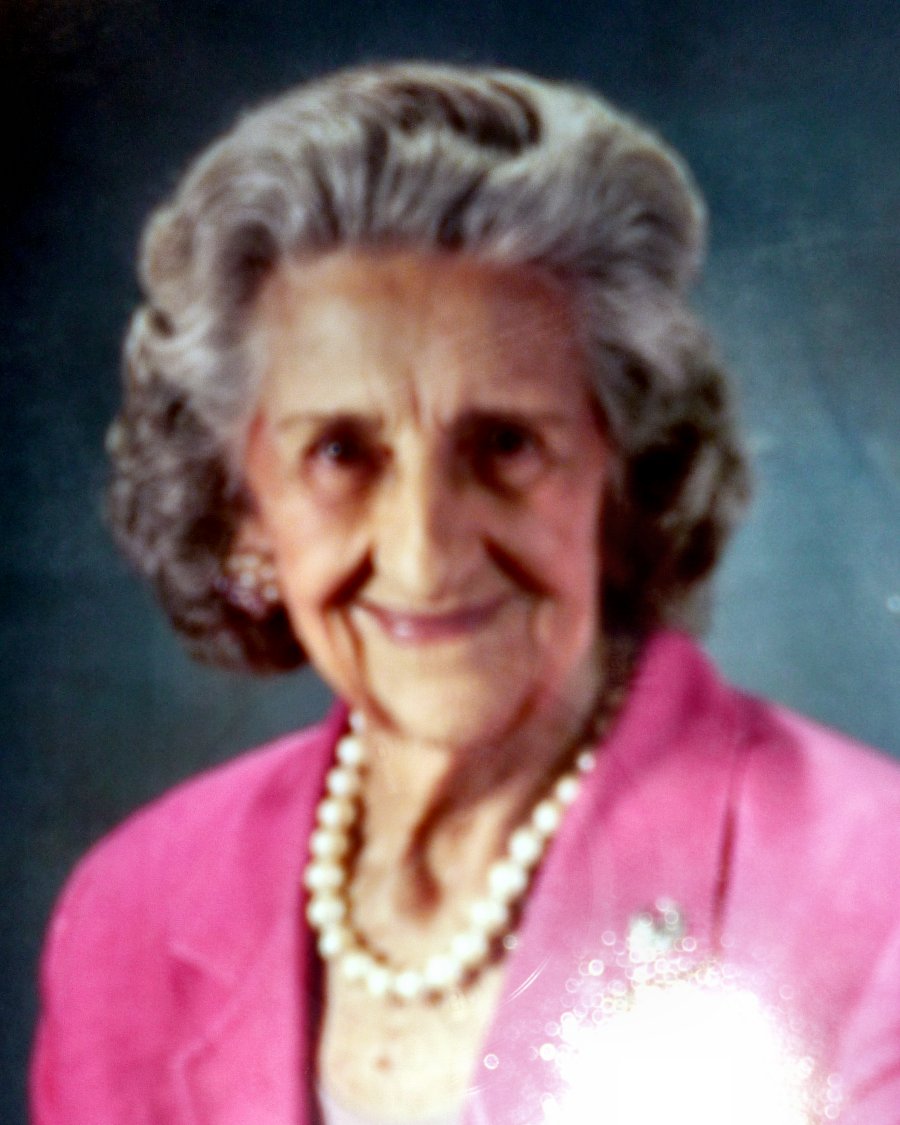
Clare Beatrice Sekul Hornsby
Clare Beatrice Sekul (1922-2017) attended Biloxi High School, Perkinston Jr. College and graduated from the University of Mississippi with her Bachelor of Law degree on May 28, 1945. She was believed to have been the first native Biloxi woman to become a lawyer and the 41st in the State of Mississippi. Miss Sekul went to Ole Miss via Perkinston Junior College where she graduated in May 1941.(The Daily Herald, May 28, 1945 and May 30, 1945, p. 7)
Clare married Warren Haywood Hornsby (1922-1996), a native of
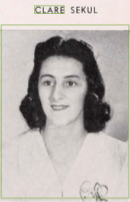
Legal Legend
The Harrison County Bar association named Clare Sekul Hornsby a Coast legal legend' in April 2013. The association planned to make a $1000 donation in Mrs. Hornsby's name to the Mississippi Volunteer Lawyers Project which provides pro bono services to clients.(The Sun Herald, April 20, 2013, p. A-4)
JACOBINA SEKUL
Jacobina Sekul (1881-1956) married Marko Beaorvich (1883-1966). Children: Henrietta Beaorvich (1911-1999) married Cvitanovich, Bellew, and Charles E. Savage (1903-1977).[see Beaorvich family]
CATHERINE SEKUL
Catherine Sekul (1891-1970) was born March 5, 1891. In Harrison County, Mississippi on February 1, 1913, she married Alexsandro Pitalo (1887-1960). Children: Dr. Stephen S. Pitalo (1914-2004) m. Marjorie Harris (1917-); Magdalena Pitalo (1915-1916) and Tony Pitalo (1917-1917); Peter Pitalo (1919-1982); Alex Mike 'Lou' Pitalo; and Mark Pitalo.(Harrison Co. Mississippi Circuit Court MRB 25, p. 224)
PETER SEKUL

Peter C. Sekul (1892-1971) was born October 23, 1892 at Bobovisce, Brac, Split-Dalmatia County, Croatia. He married Mara [Margaret] Trebotich (1907-1996) who was also born at Bobovisce. Their nuptial vows were exchanged in Harrison County, Mississippi on June 29, 1925.(Harrison Co., Mississippi Circuit Court MRB 37, p. 118)
Mara Trebotich came to America aboard the Aquitania landing at NYC in December 1923. When she applied for naturalization in February 1954, Mara stated that she was born on July 18, 1904 at Bobovisce and that Peter Sekul was born August 18, 1893, also at Bobovisce and had come to America in January 1921 and had been naturalized in June 1928. Mrs. Sekul took her oath of allegiance to the United States in February 1954.[Petition of Naturalization No. 1343-District Court-Biloxi, Mississippi-1954)
Mr. Sekul was president of the Sea Coast Packing Company and a denizen of Biloxi for fifty years. He and Mara lived at 1627 East 3rd Street on Point Cadet. Peter was a member of St. Michael's Catholic Church and the Slavonian Benevolent Society.
Peter C. Sekul was survived by his widow, Margaret Trebotich Sekul; three sons, Anthony 'Tony' Sekul (1926-1987) and Louis Sekul (1932-1996) m. Mary Ann Rollins, both of Biloxi, and Ronald Sekul (b. 1945) of Jackson, Mississippi; two daughters, Helen Sekul (b. 1929) m. Leo Paul Gutierrez jr. (1927-2002) of Biloxi and Olivia Sekul (b. 1940) m. Mr. Robbins and Mr. Rukavina of Denver, Colorado; four sisters, Vincentia Sekul (1884-1974) m. Joseph Keresich (d. 1906) and Sam Marinovich (1881-1956) and Ursula Sekul (1900-1975) m. Louis Pitalo (1891-1959), both of Biloxi, Sister Mary Olivia of the Convent of Spilt, Croatia, and Mrs. Mary Sekul Cerenich of Australia.
Mr. Sekul expired in the Howard memorial Hospital at Biloxi, Mississippi on October , 1971. His funeral was under the auspices of Bradford-O'Keefe funeral home. A Requiem Mass was held at St. Michael's Catholic Church before her corporal remains she was placed in the Mausoleum II at Southern Memorial Park cemetery.
MARICA SEKUL
Marica Sekul (1888-1948) was born in Brac and came to America in 1902. Circa 1907, she married Palmiro Gligo, the widower of Vincenza Skrmetta (d. 1905). As early as 1910, they were living in Sacramento, California where George Gligo (1911-1984) was born.
______________________________________________________________________________________
STEVE C. SEKUL
Steve C. Sekul (1881-1970) was born at Brac, Croatia on November 23, 1881. He married Lucia Trebotich (1887-1918) on July 29, 1907 at N.B.V.M. Catholic Church and Yerka Barisich (1887-1977) on June 12, 1921. Children: Anton Sekul (1908-1908); Marguerite Sekul (1909-1987) m. Meco Filipich (1902-1957); Mike Sekul (1911-1988) m. Frances Mihojevich (1913-2002); George Sekul (1913-1986) m. Agnes A. Semski (1919-1999); Lucy Sekul (1916-2004) m. Samuel Joseph Mavar (1912-1993); Mary Lou Sekul m. Worth; and Dr. Wallace Steve Sekul (1922-1994) m. Elizabeth Montgomery (1925-2012+).
MIKE SEKUL
Mike Sekul (1911-1988) was born at Biloxi, Mississippi on May 13, 1911. On June 7, 1936, Mike Sekul married Frances Mihojevich (1913-2002), the daughter of Steve Mihojevich and Frances Martinich. Their children were: S. George Sekul (b. 1938) m. Diane Poulos (b. 1942); Sherman Michael ‘Rock’ Sekul (b. 1941) m. Rose Ann Girouard and Louann Deniro; Geraldine ‘Chee’ Frances Sekul m. James Leroy Garringer; and Michael Joseph Sekul (1956-2011) m. Lola Kae Windom.
GEORGE SEKUL
George Sekul (1913-1986) was born at Biloxi, Mississippi on September 22, 1913. He married Agnes A. Semski (1919-1999), the daughter of Peter Semski (1889-1981) and Augustine Cruso Semski (1894-1974), in Harrison County, Mississippi on July 31, 1940.(Harrison Co., Mississippi Circuit Court MRB 51, p. 242)
George Sekul was survived by his spouse; four sons, George "Giggles" Sekul and Thomas J. Sekul, both of Ocean Springs, Morris Sekul and Stephen "Maroono" G. Sekul (1955-2013), both of Biloxi; two daughters, Carolyn "Catty" Mooney of Vancouver, Washington and Bettye Dennery of Philadelphia.
MARIA SEKUL
Maria Sekul [living in March 1985 in Hamilton Hill, Western Australia] was born at Bobovisce, Brac, County Split-Dalmatia and married Thomas Cerinich in Brac. They were the parents of: Anton 'Tony' Cerinich (1928-1985) m. June ?; Mary Cerinich Mosley and Ella Cerinich Senior, both of Hamilton, Hill, Western Australia
Children
Anton Cerinich
Anton 'Tony' Cerinich (1928-1985) was born at Bobovisce, Brac and immigrated to Australia with his family. Tony passed at Sydney, Australia on March 19, 1985. Tony made his livelihood as assistant director of Custofdial Services NW Division, New South Wales, Australia. He was survived by his mother, Mrs. Maria Sekul Cerinich, the widow of Thomas Cerinich of Hamilton Hill, Western Australia; June Cerinich, his widow, of Sydney, Australia; daughter, Carolyn Cerinich Chinn m. Peter Chinn of Canberra, Australia; son, Rodney Cerinich of Kiama, Australia;and two sisters, Mary Cerinich Mosley and Ella Cerinich Senior, both of Hamilton, Hill, Western Australia.
REFERENCES:
The Biloxi Daily Herald, “City News”, July 2, 1907.
The Daily Herald, “Aliens busy perfecting naturalization papers”, April 21, 1920.
The Daily Herald, “Getting out from under alien enemy class”, August 14, 1920.
The Daily Herald, “Waiting for bride from Dalmatia”, June 19, 1920.
The Daily Herald, “Marriage licenses”, January 24, 1921.
The Daily Herald, “John Sekul speaker before Lions Club”, April 2, 1935.
The Daily Herald, "Announce Marriage", February 3, 1936, p. 5.
The Daily Herald, “Slavonian boy comes from Dalmatia to Biloxi”, January 30, 1937.
The Daily Herald, “Grocery changes”, July 10, 1941.
The Daily Herald, “Miss Clare seoul receives law degree”, May 28, 1945.
The Daily Herald, “R.S. [Roko Sam] Sekul dies”, July 7, 1947.
The Daily Herald, “Mrs. P. Gligo dies”, February 6, 1948.
The Daily Herald, “[Louis E.] Wentzel [sic] funeral Sunday afternoon”, October 31, 1953.
The Daily Herald, “Steve M. Sekul”, July 18, 1966.
The Daily Herald, “Elena T. Sekul”, December 3, 1970.
The Daily Herald, “Catherine Sekul Pitalo”, December 3, 1970.
The Daily Herald, "Peter C. Sekul", October 20, 1971, p. 2.
The Daily Herald, “Yerka B. Sekul”, March 13, 1977.
The Daily Herald, "Charles Edward Savage", December 11, 1977, p. A-2.
The Daily Herald, “Attorney and former city Judge Sekul dies in medical center at age of 72”, January 10, 1984.
The Daily Herald, “Marjorie Sekul”, December 1984.
The Daily Herald, “Tony Cerinich [Sydney, Australia]”, March 22, 1985.
The Jackson County Times, “John Bellew Dies”, March 17, 1945.
The Ocean Springs News, “Mrs. Jacobina Veaorvich (sic)”, November 8, 1956.
The Ocean Springs Record, "Friends Toast Henrietta's 40th", February 24, 1983, p. 1.
The Ocean Springs Record,"50th", February 25, 1993,
The Ocean Springs Record, “Henrietta’s legacy carries on at new diner”, August 17, 1985.
The Sun Herald
The Sun Herald, “Judy S. Seymour”, May 4, 1987.
The Sun Herald, “Eleanor Beaorvich Grove”, November 23, 1994.
The Sun Herald, "Mrs. Margaret Trebotich Sekul", February 3, 1996, p. C2.
The Sun Herald, "Agnes A. Sekul", April 5, 1999, p. A9.
The Sun Herald, “Henrietta Savage”, December 8, 1999.
The Sun Herald, “Henrietta’s passing ends a quieter era”, December 8, 1999.
The Sun Herald, “Frances Sekul”, June 13, 2002.
The Sun Herald, “Alena Sekul Cerinich”, July 6, 2002, p. A6.
The Sun Herald, “Dr. Stephen S. Pitalo”, December 26, 2004, p. A6.
The Sun Herald, “Stephen M. Sekul”, September 13, 2009.
The Sun Herald, “Michael Joseph Sekul”, March 20, 2011, p. A13.
The Sun Herald, “Longtime attorney [Clare Sekul] Hornsby in the hot seat for benefit roast”, Ocotber 9, 2011, p. A9.
The Sun Herald, “Hornsby honored as legal legend on Coast”, April 20, 2013, p. A-4.
The Sun Herald, “Stephen G. Sekul”, October 6, 2013, p. A.
___________________________________________________________________________
SKRMETTA [SKRMETTI-STARMETA?]
JOHN SKRMETTA
Circa 1880 in Croatia, John Skrmetta (1852-1929) married Perina Marinovich (1854-1937). They were the parents of eight children of which seven were living in 1910. Known children: Lawrence 'Lorenc' Skrmetta (1882-1972) m. Jacobina Sekul (1885-1975); Peter Martin Skrmetta (1885-1963) m. Frances Pitalo (1895-1922) and Louvina Saput (1905-1964); Johanna Molitva Skrmetta (1886-1980) m. Stephen Rodolfich (1887-1971); Caterina 'Katie' Skrmetta (1887-1974) m. Mr. Perkov; John Skrmetta (1890-1918); Nickola Skrmetta (1893-1969) m. Jerolima ? (1895-1917) and Manuela Gonzales; Paul Mate Skrmetta (1896) m. ; and Helena Deoma Skrmetta (1898-1978) m. Peter Joseph Babich (1897-1949).(1910 Harrison Co., Mississippi Federal Census T624- , p. , ED )
In 1910, John and Perina M. Skrmetta were domiciled on 2nd Street and Pass Christian, Harrison County, Mississippi. He worked as an oysterman, Perina worked in a cannery, and Peter was captain of an oyster boat.
CHILDREN
Lawrence C. Skrmetta
Lawrence [Lorenc] C. Skrmetta (1882-1972) was born March 12, 1882 at Bobovisce, Brac, County Split-Dalmatia. He came to America on December 20, 1895 landing in New York City. Married Jacobina Sekul (1885-1975) . She was born March 5, 1885 in Brac, Croatia. Children: Mark S. Skrmetta (1911-2011) m. Marguerit Skrmetta (1912-1974); Margaret Maudie Skrmetta (1913-2007) m. Paul John 'Chilly Coon' Halat (1909-1977); Katherine T. Skrmetta (1918-1978) m. Frank R. Rysavy (1914-1971); and Lawrence M. 'Ham' Skrmetta (1920-1999) m. Antonio Rosetti (1916-1975) and Ethel Marie Landry Foret (1926-2006), former spouse of Camille Foret.
Captain Peter M. Skrmetta
Captain Peter Martin Skrmetta (1885-1963) was born August 31, 1885 in Croatia and came to America in 1903. He married Francis Pitalo (1895-1922) a 1907 Croatian immigrant. They were the parents of three children: Perina 'Pat' Skrmetta (1916-2003) m. Merrill J. Bills and Clarence A. Douglas; Mandelena Skrmetta (b. 1918); and Vincentia Skrmetta (1922-1922).
Before 1920, Peter Martin Skrmetta and Frances Pitalo lived at 1530 East Howard Avenue on the corner of Pine Street on Point Cadet. He made his livelihood as the captain of fishing schooner. In August 1922, while shrimping aboard the Louis Goldman in the Lake Borgne area of southeast Louisiana, Captain Skrmetta was summoned to Biloxi. A seaplane had been sent to locate him at sea to notify him that Frances P. Skrmetta (1895-1922), his wife, and infant daughter, Vincenzia Skrmetta (1922-1922), had been electrocuted and killed by a 2300 volt, electric wire that was laying in their front yard. Their untimely deaths occurred on August 17th. The corporal remians of Mrs. Skrmetta and her baby were interred in the Biloxi Cemetery.(The Daily Herald, August 18, 1922, p. 3 and August 19, 1922, p. 3
In January 1925, Captain Peter M. Skrmetta married Louvinia Saput (1905-1964) after the demise of Frances Pitalo. Their children were: Mary Skrmetta (1925-2011); Catherine J. Skrmetta (1928-1984) m. Charles F. Schwark (1923-2010); Peter M. Skrmetta Jr. (b. 1930) m. Jacqueline E. Wentzell; Noel James 'Jimmie' Skrmetta (1936-2004) m. Bobbie Jean Maumus (b. 1935); Mandeline 'Manda' G. Skrmetta (1920-2013) m. Lewis Voorhis 'Hooks' Langlinais (1916-2007); Genevieve Skrmetta (1939-2015) m. Francis Wayne Creel; and Dorothy Skrmetta (b. 1942).(1930 Harrison Co., Mississippi Federal Census R 1146, 19B, ED 2 and The Daily Herald, August 22, 1964, p. 2)
Children

Genevieve Skrmetta
Genevieve Skrmetta Creel (1939-2015) was born May 27, 1939 to Peter Martin Skrmetta and Louvininia Saput. She passed away Sunday, November 29, 2015. She was born in Biloxi and proud of her Croatian Heritage. She loved people and generously gave her time to church and shut-ins. She was preceded in death by her parents; sisters, Manda Langlinais, Parina Bills, Mary Skrmetta and Catherine Scwark ; brother, Jimmie Skrmetta, daughter, Sarah Ann and a granddaughter, Kara Ann.
Genevieve is survived by her husband, Francis Wayne Creel; daughters, Mary Martha (Will) Rogers; Adonna Currie, Mary Frances (Joel) Newbaker; son, Wayne “Junior” Creel; sister, Dorothy Skrmetta and brother, Peter (Jacqueline) Skrmetta; grandchildren, Nathan (Brittany) Newbaker, Kacee Currie, Kristi Currie, Brandon (Madisyn) Newbaker, Kathryn Newbaker, Kyle Currie and Noah Rogers; great-grandchildren, Hunter Newbaker and Paitlyn Newbaker; nieces and nephews; and many, many, friends and family whom she loved and cared for.
Services will be held Thursday, December 3, 2015 at Blessed Seelos Catholic Church, formerly St. John’s. Friends may visit from 10:00 to 12:00pm. Burial to follow at Biloxi City Cemetery. Bradford O’Keefe Funeral Home, Howard Avenue Chapel is in charge of arrangements.
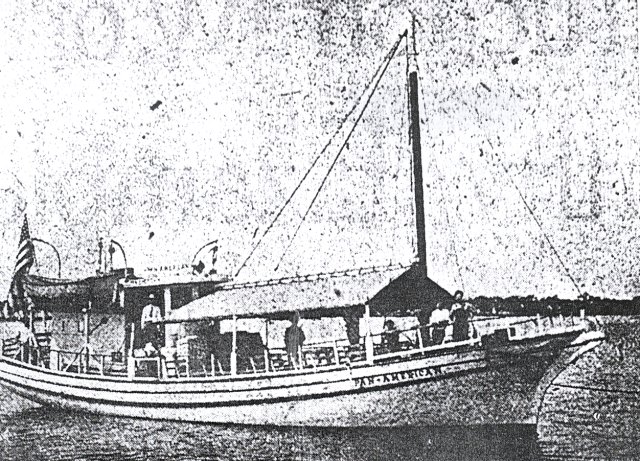
Pan American Clipper
Ship Island Excursion trips
I
n June 1935, Peter Skrmetta began ferrying tourists to Ship Island on the President Roosevelt, a power boat. Skrmetta ran to the island three times daily making stops commencing at the Baltar Pier at the Hotel Biloxi and White House Piers, twice daily.(The Daily Herald, june 27, 1935, p. 2)
Pan American Clipper
The Pan American Clipper, a $15,000, diesel powered, excursion boat, recently completed by Toche Brothers Shipyard on East Beach, has been operating for several weeks between Biloxi and Ship Island with Captain Peter Skrmetta at the helm. The vessel was built for the Mavar Fish and Oyster Company and runs at 12 mph. The boats runs from her main landing at the foot of Delaunay Street [Baltar Pier?] and makes stops at the Buena Vista, Hotel Biloxi, and White House piers on its regular schedule of three trips daily.(The Daily Herald, March 30, 1937, p. 3, May 29, 1937, p. 6, and June 25, 1938, p. 3)
2015
In February, Captain Louis Skrmetta, operations amnager of Pan Isles Inc.-Ship Island Excursions, announced that Gulf Islands National Seasore had renewed its contract for ferrying passengers to Ship Island for ten more years.(The Sun Herald, February 24, 2015, p. A-6)
John Skrmetta
Nickola Skrmetta
Nickola 'Nick' Skrmetta (1893-1969) was born at Bobovisce, Brac, County Split-Dalmatia on February 24, 1893. He arrived at New Orleans on October 4, 1906 from Palermo, Italy. Nick married Jerolima ? (1895-1917) and Pauline (1901-1928+) ? at Houston, Texas on November 26, 1928. He was a resident of San Pedro, Los Angeles, California in June 1932, when he applied for American citizenship.
Letter from Brac-1921
Nikola Skermeta (sic), 413 Copp Street in Biloxi, received a woeful letter from his parents at Bobovisci, in the island of Brach (sic), off the Dalmatian coast in the far-away Adriatic Sea. It recited the privation and suffering common in that country, where the native grape vines have succumbed to a disease which the people have been unable to cure, andin consequence of which many American grape vines have been imported. The soil there is rocky, quite unlike the rich American soil, and the vines require time become acclimated and learn to struggle against the poor soil condition, said Mr. Skermeta (sic) His people write that it will take about six years before they will be able to harvest these grapes. In the meantime, the people of Brach (sic) are enduring great hardships. Mr. Skermeta (sic) was at the Federal clerk's office inquiring into some safe method to send his parents money, a previous remittance never reached them. Reports by Biloxians of losses of money sent to relatives have been frequent, are unable to understand it being accustomed to Uncle Sam's generally prompt and safe deliveries. Mr. Skermeta's (sic) parents wrote that many people were eating grass to save themselves from starving. (The Daily Herald, January 19, 1921, p. 4)
Nick Skermetta expired at Biloxi, Mississippi on December 7, 1969. He was a resident of 101 East End Homes and survived by his wife, Manuela Gonzales, and two sons, Peter "Troubles" V. Skrmetta (1917-2000) m. Lucretia Misko (1920-2006) and John "Johnny" Skrmetta (1915-1977) both of Biloxi. Nick's corporal remains were interred in the Biloxi Cemetery.(The Daily Herald, December 8, 1969, p. 2)
Paul Mate Skrmetta
Helena D. Skrmetta
Helen Deoma Skrmetta (1898-1978) was born December 17, 1898. She married Peter Joseph Babich (1897-1949 and they lived in Sacramento, California. At least two children: Dr. John M. Babich (1924) and Judge Joseph G. Babich (1926-2008). Helen died in Sacramento County, California on November 16, 1978.
)
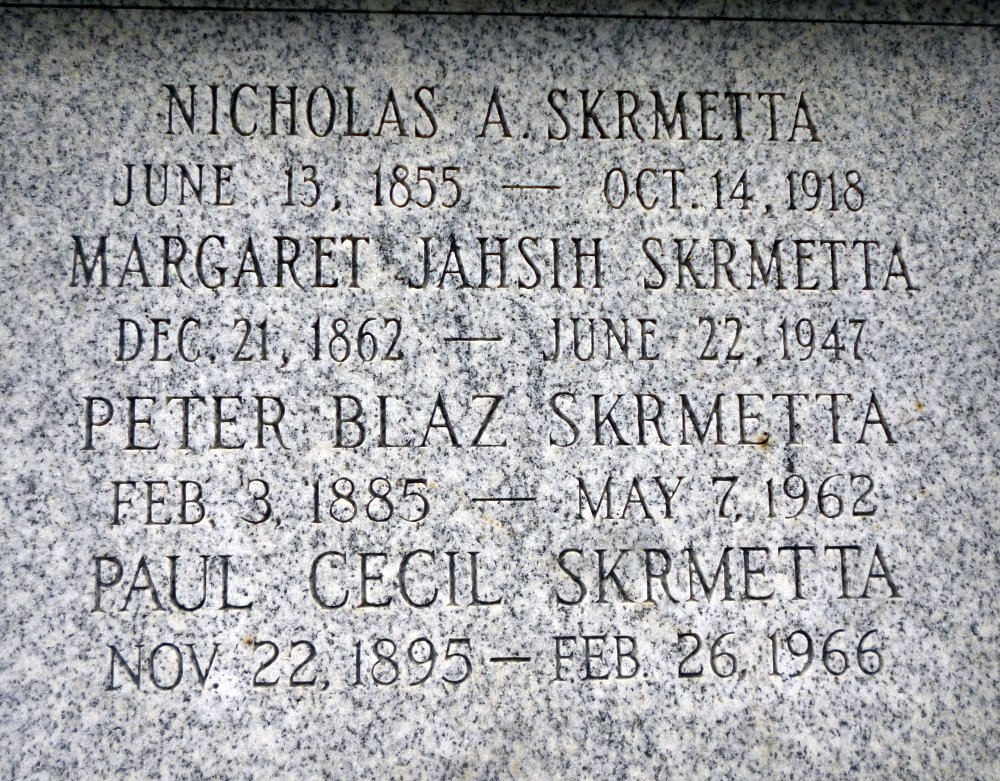
NICHOLAS A. SKRMETTA FAMILY-BILOXI CEMETERY
NICHOLAS A. SKRMETTA
Nicholas A. Skrmetta (1855-1918) was born June 13, 1855 the son of Peter Skrmetta and Vicentia Burich. He married Margaret Jahsih (1862-1947). Children: Peter Blaz Skrmetta (1885-1963); Perina Skrmetta (1886-1945) m. Sam Mihojevich (1881-1927) and Ivan Domjanov (1894-1957); Marko P. Skrmetta (1889-1959) m. Angelina Illich; Paul Cecil Skrmetta (1895-1966), and Mary Skrmetta (1898-1947) m. Grego Anticich (1886-1954).
Paul Mate Skrmetti (1895-1968) was born December 28, 1895 at Bobovice, Brac, County of Split-Damaltia, Croatia. He came to New Orleans via ship from Palermo, Sicily and arrived in the Crescent City on September 28, 1906. At Biloxi, in December 1923, he married Tinah Athaline Borden, the daughter of Thomas Spurgeon Borden (1883-1967), a native of Georgetown, Grand Cayman, British West Indies and Annie Austin Borden (1888-1955), a native of Alabama. Paul Skrmetti appeared in Federal Court in Biloxi, Mississippi on June 4, 1929 to become an American citizen.(The Daily Herald, May 24, 1929, p. 2)
In 1930, the Skrmetti family was domiciled on East Beach and living with Annie A. Borden. Paul was making his livelihood as a fisherman while Athaline work as a clerk in a store with her mother. Thomas J. Skrmetti (1926-2008), a son, had been born in 1926.(1930 Harrison Co., Mississippi Federal Census R 1146, p. 42B, ED 2 and Harrison Co., Mississippi Circuit Court MRB 35, p. 486)
REFERENCES:
Harrison County, Mississippi Chancery Court Cause No. 40775, 'Estate of Marko Skrmetta'-
Harrison County, Mississippi Chancery Court Cause No. 54180, 'Estate of Angelia Skrmetta'-
Mississippi Coast History & Genealogy Society, "A Genealogy of the Skrmetti-Skrmetta Family", Volume 31, No. 2-June 1995.
The Daily Herald, "Skermettas [sic] and Rosettas [sic] fight at christening", July 26, 1912.
The Daily Herald, "Dalmatians suffering; relatives here do not forget the Folks in the old home", January 19, 1921, p. 4)
The Daily Herald, "Use seaplane to search for husband of dead Biloxi woman [Frances Pitalo Skrmetta]", August 18, 1922.
The Daily Herald, "Funeral Mrs. Skrmetta today", August 19, 1922.
The Daily Herald, "Automobile accident causes three deaths", January 31, 1923.
The Daily Herald, "Announce new Subdivision [Paul Skrmetti]", May 21, 1926.
The Daily Herald, "Mrs. [Katie] Skrmetti dies", January 4, 1934.
The Daily Herald, “Mrs. [Perina Skrmetta Mihojevich] Domjamov dies”, April 25, 1945.
The Ocean Springs Record, “Four generations [Skrmetta family] span Ship Island”, April 8, 1999, p. 14.
The Sun Herald, “Ethel Marie Landry Skrmetta”, Jul 21, 2006.
The Sun Herald, "Mr. Anthony 'Crash' Pitalo', January 23, 2007, p. A4.
_____________________________________________________________________________________
SKRNICH
Lucy Skrnich (1867-1941) was born at Milna, Brac, Croatia on August 18, 1868. She married Nikola Filipich (1859-1931) also a native of Milna, on the isalnd of Brac. Children: Stephen Filipich; Antonio Filipich m. Mary Mihojevich (1899-1918) and Jennie Antonsich; Nicholas Filipich; and Frank Filipich.
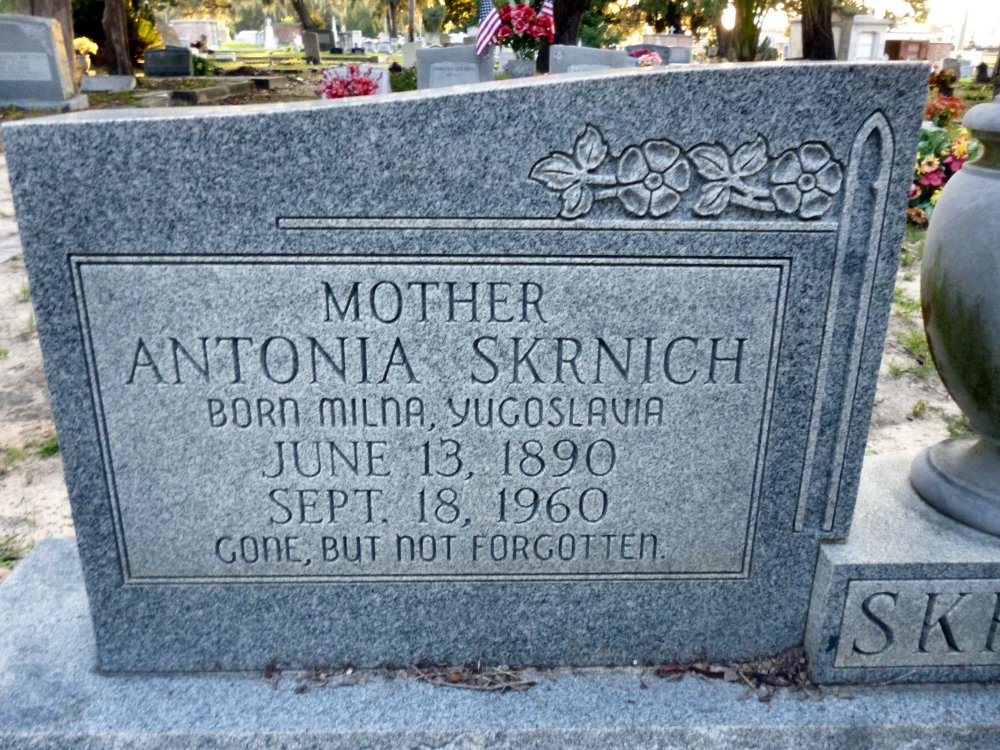
Michael Skrnich (1887-1968) was born December 31, 1887 at Milna, Brac, Croatia. He married Antonia Kuljis (1890-1960), also a native of Milna, Brac. Children: Clara Ann Skrnich (1912-2003) m. John Frank Cosmich (1909-20090; Margaret Skrnich (1913-1935) m. Vincent Rosett; Thomas Skrnich (1914-2001) m. Lillian Broux; Joseph ‘Chibby’ Skrnich (1915-2009); John Skrnich Jr. (1917-2007) m. Flora Gazzo (1924-2001), the daughter of Andrew Gazzo and Viola Daniel; Michael Skrnich (1919-1973) m. Isabell Leleaux (1922-1996); Antonia Skrnich (1922-1923); Samuel J. Skrnich (1924-2001) m. Marie Grace Sanzari; Frances Dominica Skrnich (1924-2010) m. Lawrence W. Mason (1918-2004); Lucretia Skrnich m. Neville J. Broussard (1920-1999); and Dolores Rita Skrnich m. George A. Sonnier.
Antonia Kuljis Skrnich passed on September 18, 1960 at 1442 East Beach in Biloxi. She was survived by her spouse; five sons; and four daughters; three brothers, Luka Kuljis, Sam Kuljis and Peter Kuljis; two sisters, Madica Kuljis Buzolich and Yubica Kuljis Banicich [sic] in Yugoslavia [Croatia]; 26 grandchildren; and one great-grandchild. The Reverend Herbert Mullen officiated at her funeral in St. Michael's Catholic Church follwed by burial in the Biloxi Cemetery. services under the auspices of Bradford-O'Keefe Funeral Home.(The Daily Herald, September 19, 1960, p. 2)
CHILDREN
JOHN SKRNICH JR.
John Skrnich Jr. (1918-2007) married Flora Gazzo (1924-2001), the daughter of Andrew Gazzo and Viola Daniel. Children: Mike Skrnich (b. 1943); Danny Skrnich (b. 1945); Debbie S. Watts, and John Skrnich III (1957-1964). Biloxi fisherman from 1934 until 1987. Captain of the 'Deborah'.(The Sun Herald, February 9, 2007, p. A5)
REFERENCES:
The Daily Herald,“Mrs. Filipich dies”, April 28, 1941.
The Daily Herald,“Mrs. Rosetti dies”,
The Daily Herald,“Skrnich [John Skrnich III] lad drowns in fall from boat deck”, September 23, 1964, p. 2.
The Daily Herald, “Mrs. John Skrnich [Antonia Kuljis]”, September 19, 1960.
The Daily Herald,“John Skrnich Sr.”, July 29, 1968.
The Daily Herald,“Antonia K. Skrnich”, September , 1968.
The Sun Herald,“Isabell Skrnich”, November 21, 1996, p. A2.
The Sun Herald,“Thomas Skrnich”,January 23, 2001, p. A3
The Sun Herald,“Flora G. Skrnich”,August 12, 2001, p. A11.
The Sun Herald,“Clara Ann Cosmich”, October 28, 2003, p. A6.
The Sun Herald,“John Skrnich Sr.”, February 9, 2007.
The Sun Herald,“Joseph ‘Chibby’ Skrnich”,August 21, 2009.
The Sun Herald,“Frances Skrnich Mason”, March 15, 2010.
The Sun Herald,“”,
The Sun Herald,“”,.
The Sun Herald,“”,.
_________________________________________________________________________________________
TREBOTICH
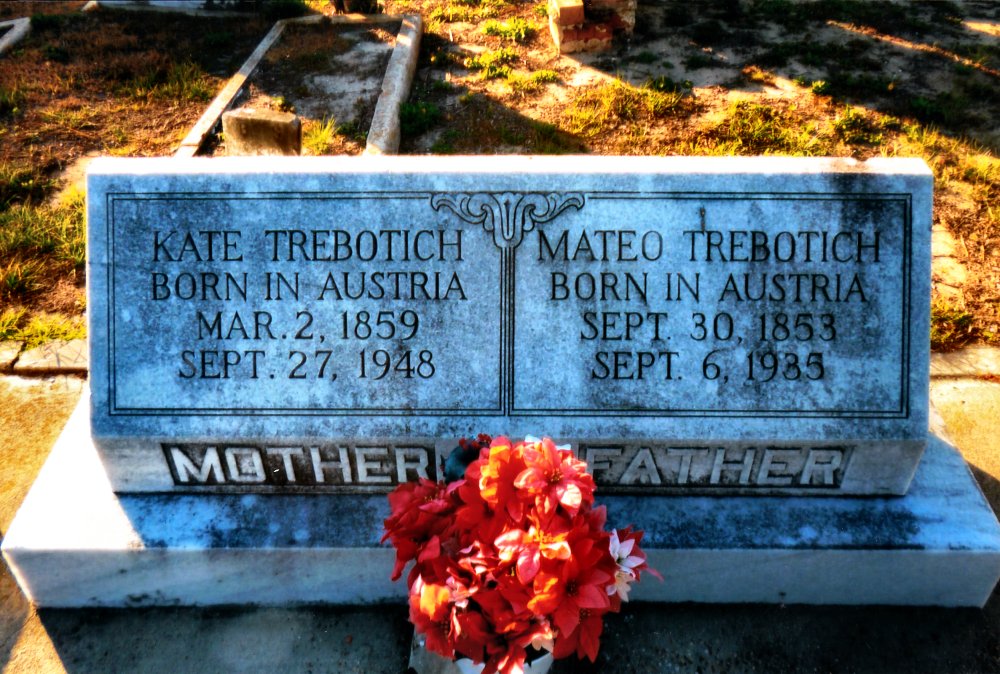
Kate Sekul and Mateo Trebotich [Biloxi Cemetery-August 2012]
MATEO TREBOTICH
Mateo 'Mike' Trebotich (1853-1935) was born at Bobovisce, Brac, Croatia on September 30, 1853. He came to the United States in January 1901 arrving at New York City by a steamer that had embarked earlier from Trieste, Austria. In December 1917.
Mike Trebotich married Katherine 'Kate' Sekul (1859-1948), the daughter of Steve Sekul and Jacobina Barisich. They lived at 238 Cedar Street with their children: Steve B. Trebotich (1886-1971) m. Paula Broussard (1907-1973); Domena [Doma] Trebotich (1880-1966) m. Sam Surian (1881-1926); Jacobina Trebotich (1883-1980) m. Vincent Gospodinovich (1882-1964); and Marguerite Trebotich (1892-1985) m. Peter Buzolich (1886-1920).
JOHN TREBOTICH
John Trebotich and Jacobina Grasich (1856-1936) were the parents of: Elena Trebotich (1884-1970) married Steve M. Sekul (1880-1966); George J. Trebotich (1891-1952) m. Antonia Kordek (1894-1935) and Angelina ? Trebotich (1908-1981); Matt Trebotich (1893-1950) m. ; and Roko Trebotich (1896-1944) m. Agnes Welch.
GEORGE TREBOTICH
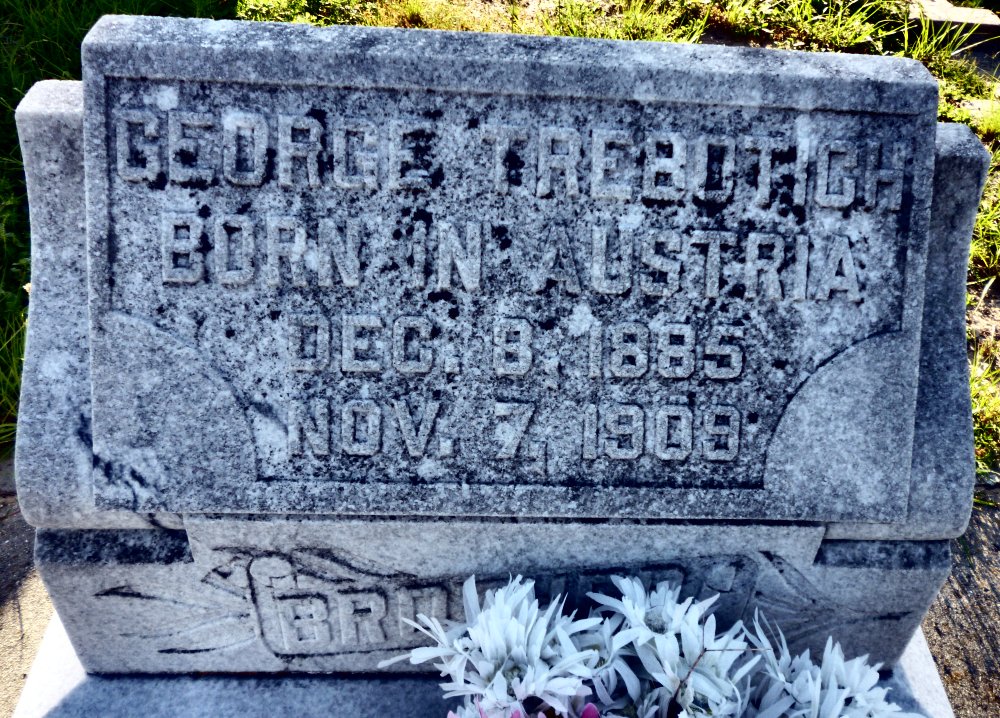
George Trebotich [Biloxi Cemetery-August 2012]
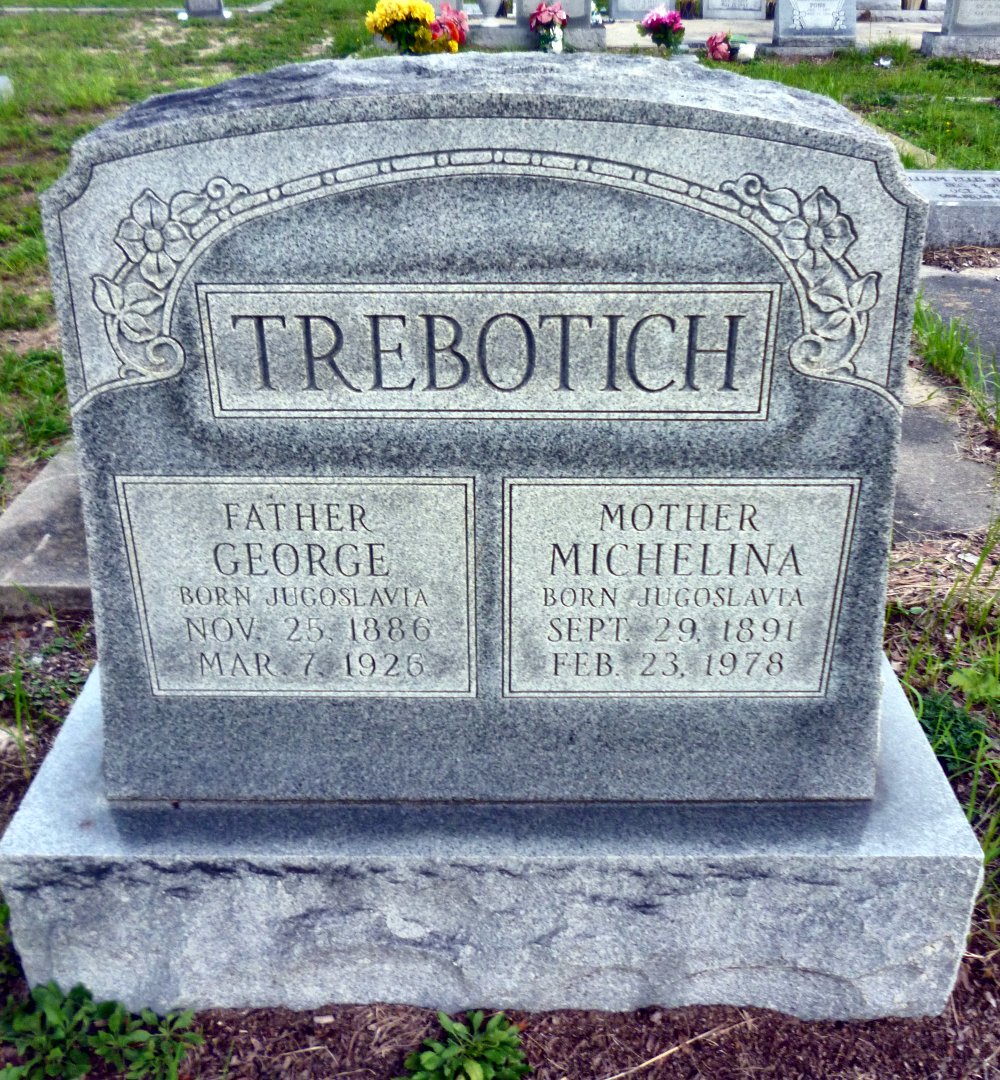
George Trebotich and Michelina Pitalo [Biloxi Cemetery-August 2012]
GEORGE J. TREBOTICH
George J. Trebotich (1886-1926) and Katika [Kate] Michelina Pitalo (1891-1978), both natives of Bobovisce, Brac, County Split-Dalmatia, married at Biloxi, Mississippi on November 6, 1913. They were the parents of the following children: Paul Trebotich (1915-1935); Steve Trebotich (1916-2010) m. Paula Broussard and Helen Hardy (1921-2008); Joseph M. Trebotich (1917-1996); George A. Trebotich (1919-2014) m. Lucy Catherine Filipich; John L. Trebotich (1920-2003) m. Ida Belle Stokes; Louis Joseph Trebotich (1923-2004) m. Margaret Evelyn Farris Shultia; Madeline Trebotich (1924-2006) m. Ernest Keenan; and Peter B. Trebotich (1926-1996).(1930 Harrison Co., Mississippi Federal Census R1146, p. 22B, ED 2 and Harrison Co., Mississippi Circuit Court MRB 25, p. 459)
At Biloxi, Mississippi in January 1934, Kate Pitalo Trebotich declared her interntion to become an American citizen. She stated that she lived at 1714 East Howard Avenue and had come to America on the SS Martha Washington from Trieste, Austria arriving at New York City on December 24, 1912. George Trebotich, her spouse, had come earlier arriving on September 26, 1907.(Declaration of Intent No. 910-Southern Disrict Court-Janaury 1934)
Trebotich sons of World War II

[L-R: Steve Trebotich (1916-2010); Joseph M. Trebotich (1917-1996); George A. Trebotich (1919-2014); John L. Trebotich (1920-2003); Louis J. Trebotich (1923-2004); and Peter B. Trebotich (1926-1996) from The Daily Herald, September 11, 1945, p. 3]
CHILDREN
Paul Trebotich
Steve Trebotich
Steve Trebotich [1916-2010]
Children

Roland Matthew Trebotich
Roland Matthew Trebotich [1937-2020], age 83, passed away on Monday, December 7, 2020. Mr. Trebotich was born on November 10, 1937 and was a native and longtime resident of Biloxi. He retired from the U.S. Postal Service and was a lifelong member of the Slavonian Benevolent Association (Slavic Lodge). He was a longtime volunteer of the Lord is my Help. He was a former member of St. Michael's Catholic Church and a devoted member of St. Alphonsus Catholic Church. He was preceded in death by parents Steve Trebotich and Paula Broussard Trebotich. He is survived by sister Catherine “Kay” Brochard, niece Diana (Thomas) McGuire, and nephews Donald (Catherine) Brochard and Ronald Brochard. In addition, he is survived by great-nephews Brandon (Katelyn) McGuire and Sean (Brianna) McGuire, great-niece Alexis McGuire, and great-great-niece Haven McGuire.
Joseph M. Trebotich
Joseph M. Trebotich [1917-1996] was born October 23, 1917 at Biloxi.
George A. Trebotich
John L. Trebotich
Louis J. Trebotich
Madeline Trebotich
Madeline Trebotich (1924-2006) was born at Biloxi on
m. Ernest Keenan
Peter B. Trebotich
Peter Bernard Trebotich Sr. [1926-1996] was born at Biloxi on May 20, 1926. He expired at Methodist Medical Center from heart failure at Jackson, Mississippi on May 1996 at the age of 69 years. Peter Barwood Drive, a jeweler, died of heart failure Thursday at Methodist Medical Center. A mass is 2 p.m. today at St. Therese Catholic Church with burial in Lakewood Memorial Park. Baldwin-Lee Funeral Home is handling arrangements. Mr. Trebotich had lived in Jackson more than 50 years. He owned and operated Diamond Jewelers in Pearl for more than 28 years. He was a communicant and charter member of St. Therese Catholic Church. He was a World War II Army veteran and served in Germany. He was a member of Veterans of Foreign Wars. Survivors include: wife, Marie; sons, Bernie Trebotich, Paul Trebotich and Mitch Trebotich, all of Jackson; daughters, Deborah Trebotich of Houston, Texas, and Georgette T. Cerula of Germany; brothers, Steve Trebotich of Biloxi, Joe Trebotich and Louis Trebotich, both of Ocean Springs, Johnny Trebotich of Beaumont and George Trebotich of Jackson; sister, Madeline T. Keenan of Biloxi; and seven grandchildren. Memorials may be made to St. Therese Catholic Church, 309 McDowell Road, Jackson MS 39212; or The Mustard Seed, 1025 Luckney Road, Brandon MS 39042.[The Clarion Ledger, May 11, 1996]
Children: Peter ‘Bernie’ Bernard Trebotich Jr.[1952-2020]; Paul Trebotich; Mitchell Trebotich; Deborah Trebotich; Georgette T. Cerula.
GEORGE TREBOTICH
George Trebotich married on June 5, 1937 in Dalmatia and arrived in Biloxi in September 1937 and lived at 1519 3rd Street.(The Daily Herald, September 3, 1937, p. 2)
MATEO TREBOTICH
Matteo 'Matt' Trebotich (1893-1950) was born June 13, 1893. He died December 31, 1950.
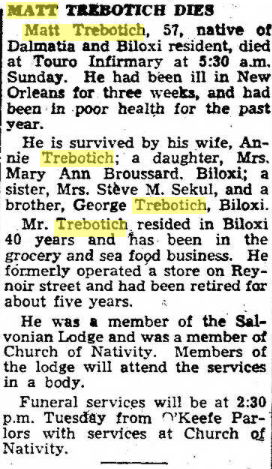
[The Daily Herald, January 1, 1951, p. 2]
Children
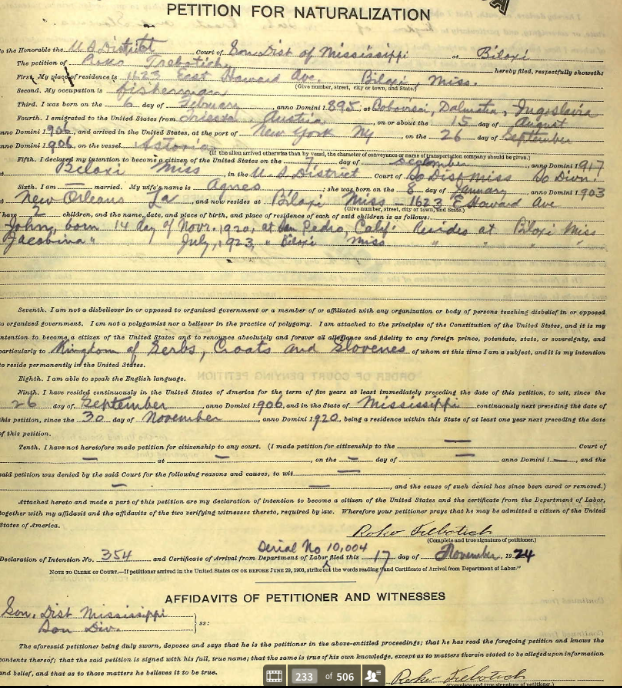
ROKO TREBOTICH

[The Daily Herald, April 13, 1944, p. 9]
Roko Trebotich (1896-1944) came to Biloxi circa 1906 from Brac. He married Agnes Welch, native of NOLA on October 1, 1918. Roko expired at his home at 310 Pine Street on Point Cadet on April 12, 1944.
Children
REFERENCES:
The Daily Herald, “Aliens busy perfecting naturalization papers”, April 21, 1920.
The Daily Herald, “Two [John Skornich (sic) and George Trebotich] after citizenship”, April 21, 1923.
The Daily Herald, "Peter Trevotich [sic] dead", August 1, 1923.
The Daily Herald,“Mrs. Trebotich [Jacobina Grasich] dies”, April 4, 1936.
The Daily Herald,“Bridal couple weds”, September 2, 1937.
The Daily Herald,“Roko Trebotich dies”, April 13, 1944.
The Daily Herald,“Matt Trebotich dies”, January 1, 1951.
Joseph Tremonta (1878-1950) was born on Brac, Croatia on March 19, 1878, the son of Matre Tremontana and Lucretia Sekul. He married Mary Cerenich. Came to Biloxi from Croatia in 1921. Live 240 Myrtle Street. Children: Joseph Tremontana Jr.; Amanada Tremontana (1908-1997) m. Ernest Mladinich Jr. (1906-1990); Lucretia Tremonta (1911-1937) m. Earl F. Cook (19-1999); Josephine Tremontana (1913-2004) m. Julian K. Cook (1908-1994); and Mary Tremontana m. Thomas Garbin (1895-1966) and Mr. Calmut.
Joseph Tremontana expired at Biloxi, Mississippi on December 17, 1950.
REFERENCES:
The Daily Herald, "Tremontana death”, December 18, 1950.
The Daily Herald,“”,
- Printer-friendly version
- 10562 views